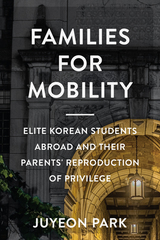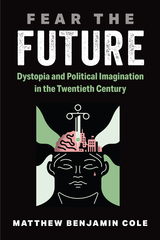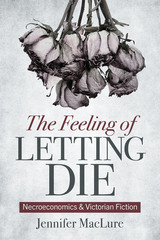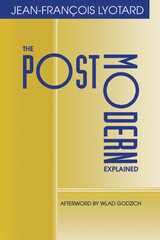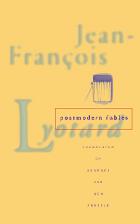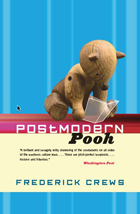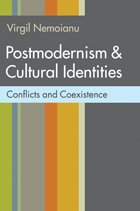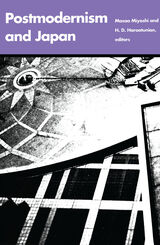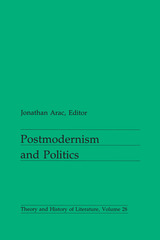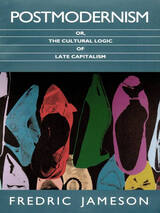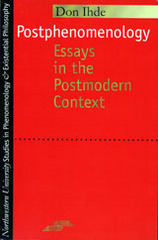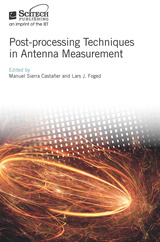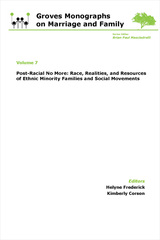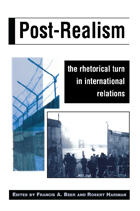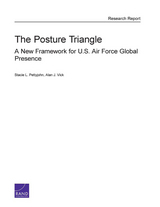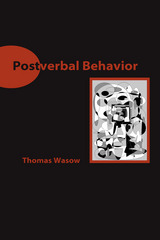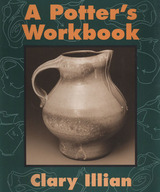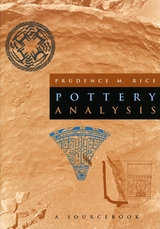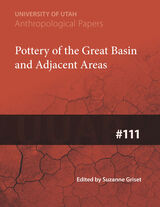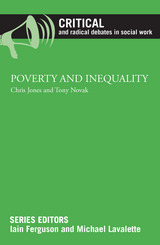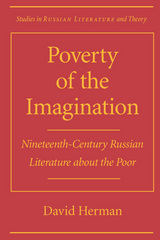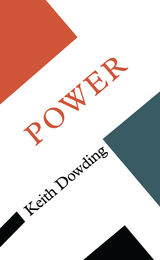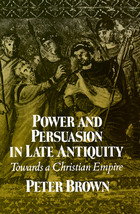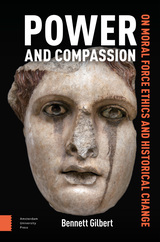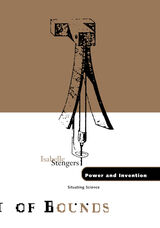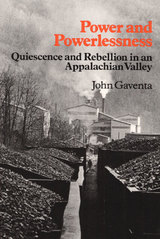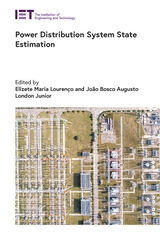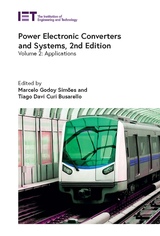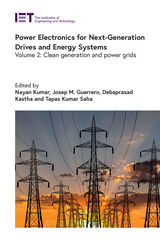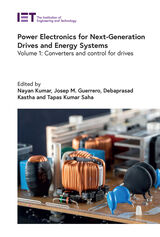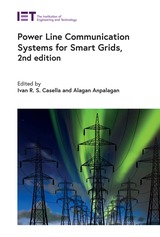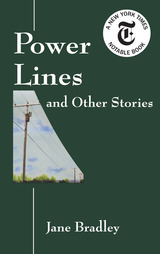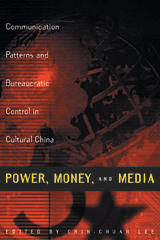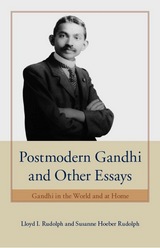 Postmodern Gandhi and Other Essays: Gandhi in the World and at Home
Lloyd I. Rudolph and Susanne Hoeber Rudolph
University of Chicago Press, 2006 Gandhi, with his loincloth and walking stick, seems an unlikely advocate of postmodernism. But in Postmodern Gandhi, Lloyd and Susanne Rudolph portray him as just that in eight thought-provoking essays that aim to correct the common association of Gandhi with traditionalism. Combining core sections of their influential book Gandhi: The Traditional Roots of Charisma with substantial new material, the Rudolphs reveal here that Gandhi was able to revitalize tradition while simultaneously breaking with some of its entrenched values and practices. Exploring his influence both in India and abroad, they tell the story of how in London the young activist was shaped by the antimodern “other West” of Ruskin, Tolstoy, and Thoreau and how, a generation later, a mature Gandhi’s thought and action challenged modernity’s hegemony. Moreover, the Rudolphs argue that Gandhi’s critique of modern civilization in his 1909 book Hind Swaraj was an opening salvo of the postmodern era and that his theory and practice of nonviolent collective action (satyagraha) articulate and exemplify a postmodern understanding of situational truth. This radical interpretation of Gandhi's life will appeal to anyone who wants to understand Gandhi’s relevance in this century, as well as students and scholars of politics, history, charismatic leadership, and postcolonialism.
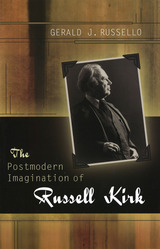 The Postmodern Imagination of Russell Kirk
Gerald J. Russello
University of Missouri Press, 2007 Author of The Conservative Mind, Russell Kirk (1918–1994) was a principal architect of the American intellectual conservative movement. This book takes a closer look at his works on such subjects as law, history, economics, and statesmanship to introduce a new generation of readers to the depth and range of his thought. Kirk probed the very meaning of conservatism for modern intellectuals, and in The Postmodern Imagination of Russell Kirk, Gerald Russello examines such key concepts of his thought as imagination, historical consciousness, the interplay between the individual and tradition, and the role of narrative in constructing individual and societal identity. By stressing the importance of Kirk’s perception of imagination, he offers a new approach to understanding him, showing not only that Kirk laid the groundwork for the “new conservatism” of the 1950s and ’60s, but also that his work evolved into a sophisticated critique of modernity paralleled in the work of some postmodern critics of liberalism. In order to reconstruct Kirk’s attack on modernity, Russello examines his textbook on economics, his fiction, his work on Robert Taft and Orestes Brownson, his writings on the role of the statesman, and his neglected essays such as “The Age of Discussion” and “The Age of Sentiments.” Russello shows that Kirk welcomed the rise of some form of postmodernism, seeing in it a new opportunity for conservatism to engage the wider culture. Through this analysis, he situates Kirk within wider currents of contemporary thought, connecting him not only with such major thinkers as Lyotard, Boorstin, and Koestler but also with such lesser-known figures as Bernard Iddings Bell, Charles Baudouin, and Christopher Dawson. By examining Kirk’s development of the imagination as a tool of conservative discourse, Russello offers an alternative genealogy for conservative thought that melds its antimodernism with postmodern themes. He has forged a lively and provocative work that provides unusual perspectives on Kirk within the wider context of debate over the future of conservatism in a time of shifting alliances—a book that will be a valuable resource for anyone seeking to understand Kirk or conservative thought.
Postmodern Platos: Nietzsche, Heidegger, Gadamer, Strauss, Derrida
Catherine H. Zuckert
University of Chicago Press, 1996 Catherine Zuckert examines the work of five key philosophical figures from the nineteenth and twentieth centuries through the lens of their own decidedly postmodern readings of Plato. She argues that Nietzsche, Heidegger, Gadamer, Strauss, and Derrida, convinced that modern rationalism had exhausted its possibilities, all turned to Plato in order to rediscover the original character of philosophy and to reconceive the Western tradition as a whole. Zuckert's artful juxtaposition of these seemingly disparate bodies of thought furnishes a synoptic view, not merely of these individual thinkers, but of the broad postmodern landscape as well. The result is a brilliantly conceived work that offers an innovative perspective on the relation between the Western philosophical tradition and the evolving postmodern enterprise.
Postmodern Pooh
Frederick Crews
Northwestern University Press, 2006 Purporting to be the proceedings of a forum on Pooh convened at the Modern Language Association's annual convention, this sequel of sorts to the classic send-up of literary criticism, The Pooh Perplex, brilliantly parodies the academic fads and figures that held sway at the millennium. Deconstruction, poststructuralist Marxism, new historicism, radical feminism, cultural studies, recovered-memory theory, and postcolonialism, among other methods, take their shots at the poor stuffed bear and Frederick Crews takes his well-considered, wildly funny shots at them. His aim, as ever, is true.
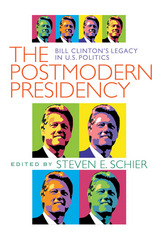 Postmodern Presidency: Bill Clinton's Legacy in U.S. Politics
Steven Schier
University of Pittsburgh Press, 2000
As America’s first truly postmodern president, Bill Clinton experienced both great highs and stunning lows in office that will shape the future course of American politics. Clinton will forever be remembered as the first elected president to be impeached, but will his tarnished legacy have lasting effects on America’s political system?
Including the conflict in Kosovo, the World Trade Organization meeting in Seattle, and new developments in the 2000 presidential campaign, The Postmodern Presidency is the most comprehensive and current assessment of Bill Clinton’s presidency available in print.
The book examines Clinton’s role in redefining the institution of the presidency, and his affect on future presidents’ economic and foreign policies. The contributors highlight the president’s unprecedented courtship of public opinion; how polls affected policy; how the president gained “celebrity” status; how Clinton’s “postmodern” style of public presidency helped him survive the 1994 elections and impeachment; and how all of this might impact future presidents.
This new text also demonstrates how the Clinton presidency changed party politics in the public and in Congress, with long-term implications and costs to both Republicans and his own Democratic party, while analyzing Clinton’s effect on the 1990s “culture wars,” the politics and importance of gender, and the politics and policy of race.
Postmodern Sophistications: Philosophy, Architecture, and Tradition
David Kolb
University of Chicago Press, 1990 Kolb discusses postmodern architectural styles and theories within the context of philosophical ideas about modernism and postmodernism. He focuses on what it means to dwell in a world and within a history and to act from or against a tradition.
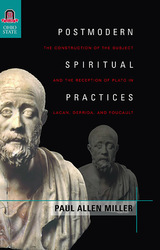 Postmodern Spiritual Practices: The Construction of the Subject and the Reception of Plato in Lacan, Derrida, and Foucault
Paul Allen Miller
Ohio State University Press, 2007 Postmodern Spiritual Practices: The Construction of the Subject and the Reception of Plato in Lacan, Derrida, and Foucault, by Paul Allen Miller, argues that a key element of postmodern French intellectual life has been the reception of Plato. This fact has gone underappreciated in the Anglophone world due to a fundamental division in culture. Until very recently, the concerns of academic philosophy and philology have had little in common. On the one hand, this is due to analytic philosophy’s self-confinement to questions of epistemology, speech act theory, and philosophy of science. As such, it has had little to say about the relation between antique and contemporary modes of thought.
On the other hand, blindness to the merits of postmodern thought is also due to Anglo-American philology’s own parochial instincts. Ensconced within a nineteenth-century model of Alterumswissenschaft, only a minority of classicists have made forays into philosophical, psychoanalytic, and other speculative modes of inquiry. The result has been that postmodern French thought has largely been the province of scholars of modern languages.
A situation thus emerges in which most classicists do not know theory, and so cannot appreciate the scope of these thinkers’ contribution to our understanding of the genealogy of Western thought, while most theorists do not know the Platonic texts and their contexts that ground them. This book bridges this gap, offering detailed and theoretically informed readings of French postmodernism’s chief thinkers’ debts to Plato and the ancient world.
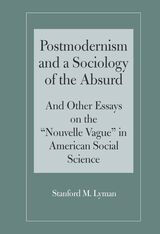 Postmodernism and a Sociology of the Absurd: Absurd And Other Essays on the "Nouvelle Vague" in American Social Science
Stanford Lyman
University of Arkansas Press, 1997 In the fifth volume in the Studies in American Sociology Series, Stanford M. Lyman offers commentaries on and critiques of postmodernism, poststructuralism, and deconstruction, posing questions concerning theoretical and epistemological problems arising from what appears to be a “nouvelle vague.” Postmodernism, poststructuralism, and deconstructionism are interrelated aspects of the newest theoretical development in sociology and the social sciences. This new wave of thought challenges virtually all paradigms currently in use. In this, his fifth volume in the Studies in American Sociology Series, Stanford M. Lyman offers commentaries on and critiques of this new perspective, posing questions concerning theoretical and epistemological problems arising from what appears to be a nouvelle vague. Among the basic themes and issues explored are the allegation that modernity has defaulted on the promise of the Enlightenment; the question of whether the rational basis for knowledge and action is still valid; the controversy over the place of metanarratives and macrosociological outlooks; and newer concerns over race, gender, sexual preferences, the self, and the “Other.” Professor Lyman provides empirically based and historically specific analyses of the relation of the race question to the problem of otherness and to the legal construction of racial identity in American court proceedings. Focusing on the issues of citizenship affecting European, Middle Eastern, and Asian immigrants; African Americans; and the special cases of the Chinese and Native Americans, he relates major public problems to the modern as well as the postmodern perspectives on justice. The debate over assimilation and multiculturalism, the dynamics of gender-specific emotions as expressed in six decades of Hollywood films, and the postmodern approach to deviance are each examined. He also offers proposals for a social science attuned to, but critical of, postmodernism and poststructuralism. Such a sociology might offer a perspective that treats the drama of social relations in the routine as well as the remarkable aspects of everyday life. Professor Lyman provides not only a new understanding of postmodernism but also a program of how to proceed with respect to its challenges.
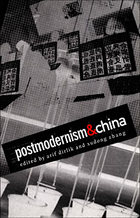 Postmodernism and China
Arif Dirlik and Xudong Zhang, eds.
Duke University Press, 2000 Few countries have been so transformed in recent decades as China. With a dynamically growing economy and a rapidly changing social structure, China challenges the West to understand the nature of its modernization. Using postmodernism as both a global frame of periodization and a way to break free from the rigid ideology of westernization as modernity, this volume’s diverse group of contributors argues that the Chinese experience is crucial for understanding postmodernism. Collectively, these essays question the implications of specific phenomena, like literature, architecture, rock music, and film, in a postsocialist society. Some essays address China’s complicity in—as well as its resistance to—the culture of global capitalism. Others evaluate the impact of efforts to redefine national culture in terms of enhanced freedoms and expressions of the imagination in everyday life. Still others discuss the general relaxation of political society in post-Mao China, the emergence of the market and its consumer mass culture, and the fashion and discourse of nostalgia. The contributors make a clear case for both the historical uniqueness of Chinese postmodernism and the need to understand its specificity in order to fully grasp the condition of postmodernity worldwide. Although the focus is on mainland China, the volume also includes important observations on social and cultural realities in Hong Kong and Taiwan, whose postmodernity has so far been confined—in both Chinese and English-speaking worlds—to their economic and consumer activities instead of their political and cultural dynamism. First published as a special issue of boundary 2, Postmodernism and China includes seven new essays. By juxtaposing postmodernism with postsocialism and by analyzing China as a producer and not merely a consumer of the culture of the postmodern, it will contribute to critical discourses on globalism, modernity, and political economics, as well as to cultural and Asian studies. Contributors. Evans Chan, Arif Dirlik, Dai Jinhua, Liu Kang, Anthony D. King, Jeroen de Kloet, Abidin Kusno, Wendy Larson, Chaoyang Liao, Ping-hui Liao, Sebastian Hsien-hao Liao, Sheldon Hsiao-peng Lu, Wang Ning, Xiaobing Tang, Xiaoying Wang, Chen Xiaoming, Xiaobin Yang, Zhang Yiwu, Xudong Zhang
Postmodernism and China, Volume 24
Arif Dirlik and Zhang Xudong
Duke University Press This collection on postmodernism and China undertakes two tasks: to map out the terrain of postmodernism in Chinese intellectual and creative activity, specifically in the domains of literature, the arts, film, and architecture; and to engage the question of postmodernity and postmodernism as relevant concepts for understanding the condition of contemporary Chinese societies. Essays consider Chinese postmodernity in its relationship to a socialist and revolutionary modernity; new patterns of consumption and production that have accompanied integration into the global capitalist system; and an increasingly visible Chinese diaspora sharing a historical legacy but individually dynamized by contemporary economic and political forces.
Postmodernism and Cultural Identities: Conflicts and Coexistence
Virgil Nemoianu
Catholic University of America Press, 2010 Virgil Nemoianu's book starts from the assumption that, whether we like it or not, we live in a postmodern environment, one characterized by turbulence, fluidity, relativity, commotion, uncertainty, and lightning-fast communication and change.
Postmodernism and Japan
Masao Miyoshi and H. D. Harootunian, eds.
Duke University Press, 1989 Postmodernism and Japan is a coherent yet diverse study of the dynamics of postmodernism, as described by Lyotard, Baudrillard, Deleuze, and Guatarri, from the often startling perspective of a society bent on transforming itself into the image of Western “enlightenment” wealth and power. This work provides a unique view of a society in transition and confronting, like its models in the West, the problems induced by the introduction of new forms of knowledge, modes of production, and social relationships.
Postmodernism and Politics
Jonathon Arac
University of Minnesota Press, 1986 In eight essays, the contributors reach out to explore cinema and photography, psychology and ethics, social theory and economic reform. Taken together, the essays provide fresh perspectives on the problem of representation in many areas, from the constitution of the individual subject, through the status of the image, to the formation and transmission of social and moral knowledge. The contributors: Paul A. Bove, Mary Louise Pratt, Dana Polan, Andrew Parker, Rainer Nagele, John Higgins, Cornel West, and Bruce Robbins.
Postmodernism and the Other: New Imperialism of Western Culture
Ziauddin Sardar
Pluto Press, 1997 This controversial work examines postmodernism from a non-Western perspective, and exposes its claims as a sham. Sardar makes a systematic assessment of the salient spheres of postmodernism - from philosophy and architecture, to film, music and new age religions - and reveals that, contrary to commonly-held notions, postmodernism operates to further marginalise the reality of the non-West and confound its aspirations.
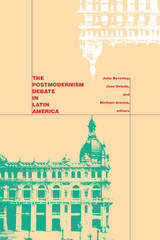 The Postmodernism Debate in Latin America
John Beverley, José Oviedo, and Michael Aronna, eds.
Duke University Press, 1995 Postmodernism may seem a particularly inappropriate term when used in conjunction with a region that is usually thought of as having only recently, and then unevenly, acceded to modernity. Yet in the last several years the concept has risen to the top of the agenda of cultural and political debate in Latin America. This collection explores the Latin American engagement with postmodernism, less to present a regional variant of the concept than to situate it in a transnational framework. Recognizing that postmodernism in Latin America can only inaccurately be thought of as having traveled from an advanced capitalist "center" to arrive at a still dependent neocolonial "periphery," the contributors share the assumption that postmodernism is itself about the dynamics of interaction between local and metropolitan cultures in a global system in which the center-periphery model has begun to break down. These essays examine the ways in which postmodernism not only designates the effects of this transnationalism in Latin America, but also registers the cultural and political impact on an increasingly simultaneous global culture of a Latin America struggling with its own set of postcolonial contingencies, particularly the crisis of its political left, the dominance of neoliberal economic models, and the new challenges and possibilities opened by democratization. With new essays on the dynamics of Brazilian culture, the relationship between postmodernism and Latin American feminism, postmodernism and imperialism, and the implications of postmodernist theory for social policy, as well as the text of the Declaration from the Lacandon Jungle of the Zapatatista National Liberation Army, this expanded edition of boundary 2 will interest not only Latin Americanists, but scholars in all disciplines concerned with theories of the postmodern. Contributors. Xavier Albó, José Joaquín Brunner, Fernando Calderón, Enrique Dussel, Néstor García Canclini, Martín Hopenhayn, Neil Larsen, the Latin American Subaltern Studies Group, Norbert Lechner, María Milagros López, Raquel Olea, Aníbal Quijano, Nelly Richard, Carlos Rincón, Silviano Santiago, Beatriz Sarlo, Roberto Schwarz, and Hernán Vidal
Postmodernism, or, The Cultural Logic of Late Capitalism
Fredric Jameson
Duke University Press, 1992 Now in paperback, Fredric Jameson’s most wide-ranging work seeks to crystalize a definition of ”postmodernism”. Jameson’s inquiry looks at the postmodern across a wide landscape, from “high” art to “low” from market ideology to architecture, from painting to “punk” film, from video art to literature.
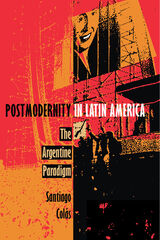 Postmodernity in Latin America: The Argentine Paradigm
Santiago Colás
Duke University Press, 1994 Postmodernity in Latin America contests the prevailing understanding of the relationship between postmodernity and Latin America by focusing on recent developments in Latin American, and particularly Argentine, political and literary culture. While European and North American theorists of postmodernity generally view Latin American fiction without regard for its political and cultural context, Latin Americanists often either uncritically apply the concept of postmodernity to Latin American literature and society or reject it in an equally uncritical fashion. The result has been both a limited understanding of the literature and an impoverished notion of postmodernity. Santiago Colás challenges both of these approaches and corrects their consequent distortions by locating Argentine postmodernity in the cultural dynamics of resistance as it operates within and against local expressions of late capitalism.
Focusing on literature, Colás uses Julio Cortázar’s Hopscotch to characterize modernity for Latin America as a whole, Manuel Puig’s Kiss of the Spider Woman to identify the transition to a more localized postmodernity, and Ricardo Piglia’s Artificial Respiration to exemplify the cultural coordinates of postmodernity in Argentina. Informed by the cycle of political transformation beginning with the Cuban Revolution, including its effects on Peronism, to the period of dictatorship, and finally to redemocratization, Colás’s examination of this literary progression leads to the reconstruction of three significant moments in the history of Argentina. His analysis provokes both a revised understanding of that history and the recognition that multiple meanings of postmodernity must be understood in ways that incorporate the complexity of regional differences.
Offering a new voice in the debate over postmodernity, one that challenges that debate’s leading thinkers, Postmodernity in Latin America will be of particular interest to students of Latin American literature and to scholars in all disciplines concerned with theories of the postmodern.
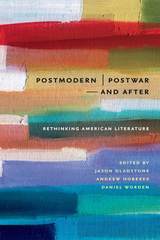 Postmodern/Postwar and After: Rethinking American Literature
Jason Gladstone, Andrew Hoberek, and Daniel Worden
University of Iowa Press, 2016 Within the past ten years, the field of contemporary American literary studies has changed significantly. Following the turn of the twenty-first century and mounting doubts about the continued explanatory power of the category of “postmodernism,” new organizations have emerged, book series have been launched, journals have been created, and new methodologies, periodizations, and thematics have redefined the field. Postmodern/Postwar—and After aims to be a field-defining book—a sourcebook for the new and emerging critical terrain—that explores the postmodern/postwar period and what comes after.
The first section of essays returns to the category of the “post-modern” and argues for the usefulness of key concepts and themes from postmodernism to the study of contemporary literature, or reevaluates postmodernism in light of recent developments in the field and historical and economic changes in the late twentieth and early twenty-first centuries. These essays take the contemporary abandonments of postmodernism as an occasion to assess the current states of postmodernity. After that, the essays move to address the critical shift away from postmodernism as a description of the present, and toward a new sense of postmodernism as just one category among many that scholars can use to describe the recent past. The final section looks forward and explores the question of what comes after the postwar/postmodern.
Taken together, these essays from leading and emerging scholars on the state of twenty-first-century literary studies provide a number of frameworks for approaching contemporary literature as influenced by, yet distinct from, postmodernism. The result is an indispensable guide that seeks to represent and understand the major overhauling of postwar American literary studies that is currently underway.
 Postmortem: How Medical Examiners Explain Suspicious Deaths
Stefan Timmermans
University of Chicago Press, 2006 As elected coroners came to be replaced by medical examiners with scientific training, the American public became fascinated with their work. From the grisly investigations showcased on highly rated television shows like C.S.I. to the bestselling mysteries that revolve around forensic science, medical examiners have never been so visible—or compelling. They, and they alone, solve the riddle of suspicious death and the existential questions that come with it. Why did someone die? Could it have been prevented? Should someone be held accountable? What are the implications of ruling a death a suicide, a homicide, or an accident? Can medical examiners unmask the perfect crime?
Postmortem goes deep inside the world of medical examiners to uncover the intricate web of pathological, social, legal, and moral issues in which they operate. Stefan Timmermans spent years in a medical examiner’s office, following cases, interviewing examiners, and watching autopsies. While he relates fascinating cases here, he is also more broadly interested in the cultural authority and responsibilities that come with being a medical examiner. Although these professionals attempt to remain objective, medical examiners are nonetheless responsible for evaluating subtle human intentions. Consequently, they may end—or start—criminal investigations, issue public health alerts, and even cause financial gain or harm to survivors. How medical examiners speak to the living on behalf of the dead, is Timmermans’s subject, revealed here in the day-to-day lives of the examiners themselves.
The Postnatal Development of the Human Cerebral Cortex
J. LeRoy Conel
Harvard University Press This eighth volume in a series begun by Dr. J. LeRoy Conel in 1939 extends his investigation of the human cerebral cortex to the six-year stage of development. As in the preceding volumes, several features of the microscopic structure of the cortex are described in great detail. In a concluding commentary, the author summarizes his findings and provides comparisons between the six-year and the four-year stages of development. Well-known to specialists, this important series of books lays a uniquely valuable foundation for further neurological research.
 The Postnatal Development of the Human Cerebral Cortex
J. LeRoy Conel
Harvard University Press This is the first of a series of volumes in which the author will present the results of an extensive study of the postnatal development of the human cerebral cortex, beginning at the time of birth. Here he discusses the condition of the neurons in the cortex of the full-term fetus immediately after birth. No such comprehensive study of the development of the cerebral cortex has been heretofore attempted. The definitive cytoarchitectonic pattern of the cerebral cortex is already established in the normal full-term infant at the time of birth. Distinct regional differences in degree of development of the neurons and myelination of the fibers are clearly apparent. In general, the primary efferent area in the gyms centralis anterior, and the primary afferent areas in the gyms centralis posterior, the area striata, the hippocampus, gyrus temporalis transversus anterior, and the gyms cinguli are foci of development in their respective lobes, and in each lobe there is a gradual decrease in differentiation away from these centers.
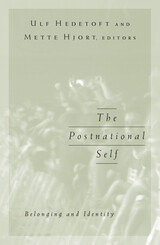 Postnational Self: Belonging And Identity
Ulf Hedetoft
University of Minnesota Press, 2002 A timely look at how our globalized era has reconfigured experiences of belonging. What happens to a sense of belonging when national and regional governments, religious organizations, community groups, political parties, and corporations become unstable and incoherent, as they have in these nationalist and postnationalist times? From a richly interdisciplinary perspective, the authors examine notions of citizenship and cultural hybridization, migration and other forms of mobility, displacements and ethnic cleansing, and the nature of national belonging in a world turning ever more fluid, aided by transnational flows of capital, information, people, and ideas. Contributors: Seyla Benhabib, Yale; John A. Hall, McGill U; Ulf Hannerz, Stockholm U; Jeffrey Herf, U of Maryland; Michael Herzfeld, Harvard; Richard Jenkins, U of Sheffield, UK; Mark Juergensmeyer, U of California, Santa Barbara; Riva Kastoryano, Center for International Studies and Research (CERI), Paris; Michèle Lamont, Princeton; Benjamin Lee, Rice U; Orvar Löfgren, U of Lund, Sweden; Philip Schlesinger, U of Stirling, Scotland; Yasemin Nuhõglu Soysal, U of Essex, UK; Ray Taras, Tulane U; James Tully, U of Victoria, British Columbia.
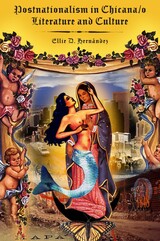 Postnationalism in Chicana/o Literature and Culture
By Ellie D. Hernández
University of Texas Press, 2009 In recent decades, Chicana/o literary and cultural productions have dramatically shifted from a nationalist movement that emphasized unity to one that openly celebrates diverse experiences. Charting this transformation, Postnationalism in Chicana/o Literature and Culture looks to the late 1970s, during a resurgence of global culture, as a crucial turning point whose reverberations in twenty-first-century late capitalism have been profound. Arguing for a postnationalism that documents the radical politics and aesthetic processes of the past while embracing contemporary cultural and sociopolitical expressions among Chicana/o peoples, Hernández links the multiple forces at play in these interactions. Reconfiguring text-based analysis, she looks at the comparative development of movements within women's rights and LGBTQI activist circles. Incorporating economic influences, this unique trajectory leads to a new conception of border studies as well, rethinking the effects of a restructured masculinity as a symbol of national cultural transformation. Ultimately positing that globalization has enhanced the emergence of new Chicana/o identities, Hernández cultivates important new understandings of borderlands identities and postnationalism itself.
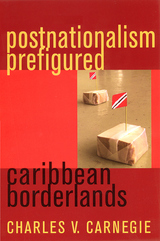 Postnationalism Prefigured: Caribbean Borderlands
Carnegie, Charles V
Rutgers University Press, 2002 We do not consider it noteworthy when somebody moves three thousand miles from New York to Los Angeles. Yet we think that movement across borders requires a major degree of adjustment, and that an individual who migrates 750 miles from Haiti to Miami has done something extraordinary. Charles V. Carnegie suggests that to people from the Caribbean, migration is simply one of many ways to pursue a better future and to survive in a world over which they have little control Carnegie shows not only that the nation-state is an exhausted form of political organization, but that in the Caribbean the ideological and political reach of the nation-state has always been tenuous at best. Caribbean peoples, he suggests, live continually in breach of the nation-state configuration. Drawing both on his own experiences as a Jamaican-born anthropologist and on the examples provided by those who have always considered national borders as little more than artificial administrative nuisances, Carnegie investigates a fascinating spectrum of individuals, including Marcus Garvey, traders, black albinos, and Caribbean Ba’hais. If these people have not themselves developed a scholarly doctrine of transnationalism, they have, nevertheless, effectively lived its demand and prefigured a postnational life.
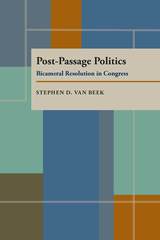 Post-Passage Politics: Bicameral Resolution in Congress
Stephen D. Van Beek
University of Pittsburgh Press, 1995
“Megabills” that package scores of legislative proposals into House and Senate bills are a phenomenon of the congressional reforms of the 1970s and the agenda changes of the 1980s. These bills generate unprecedented disagreements between the House and Senate, requiring congressional leaders, the president, committee chairs, and junior members to play new roles in this struggle for resolution.
Conference committees of hundreds of members, informal negotiations among party leaders, and preconference strategizing and behavior are among the new realities of bicameralism that are viewed in this study. These conferences are vital because they generally are the last arenas in which large-scale changes can be made in legislation.
Van Beek uses a case study approach that investigates the legislative histories of recent bills on the savings and loan bailout, the major trade bill of the late 1980s, and several budget reconciliation bills. His research is brought to life through personal experience as a legislative aide, direct observation of Congress at work, and interviews with members, staff and lobbyists.
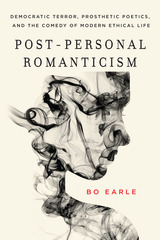 Post-Personal Romanticism: Democratic Terror, Prosthetic Poetics, and the Comedy of Modern Ethical Life
Bo Earle
Ohio State University Press, 2017 Post-Personal Romanticism: Democratic Terror, Prosthetic Poetics, and the Comedy of Modern Ethical Life by Bo Earle offers a broad recasting of Romantic lyric’s formal innovations in terms of Hegel’s historical ethics. These innovations attempt to come to terms with the Enlightenment’s paradoxical legacy: industrial and consumerist modernity depends on the Enlightenment norm of rationally autonomous individuality even as it makes this norm ever more implausible. In turn, a key insight of the Romantics is that modernity depends most crucially upon the very elusiveness of this norm of autonomous individuality. The Romantics emphasize that modernity is constitutively a culture of fantasy, a culture self-conscious about the impossibility of its own organizing values and goals.
Tracing this insight to Hegel’s suggestion that modern subjectivity is in some sense post-individual or even posthumous, Earle argues that signature Romantic lyrics offer a way forward that avoids postmodernism’s wholesale rejection of autonomous selfhood. With chapters on Wordsworth, Blake, Byron, Shelley, and Keats, Earle traces how Romantic lyrics mine this interminability to recover figurative emblems or masks of selfhood from experiences of its inevitable normative failure. This model is of particularly urgent value today when the costs of modern narcissism, economic exploitation, and political imperialism have come to include the normalization of torture, signature drone strikes, and climate change.
Postphenomenology: Essays in the Postmodern Context
Don Ihde
Northwestern University Press, 1995 Postphenomenology is a fascinating investigation of the relationships between global culture and technology. The impressive range of subjects to which Don Ihde applies his skill as a phenomenologist is unified by what he describes as "a concern which arises with respect to one of the now major trends of Euro-American philosophy--its textism." He adds, "I show my worries to be less about the loss of subjects or authors, than I do about [there] not being bodies or perceivers."
 Postpolitics and the Aesthetic Imagination
Juan Meneses
University of Minnesota Press, 2025 Igniting political power through the lens of art and the imagination Postpolitics and the Aesthetic Imagination investigates the erosion of meaningful political action in today’s world. Gathering writings from an array of scholars, editor Juan Meneses asks: can an aesthetic theory of postpolitics help us understand and counteract the most insidious processes of depoliticization? The contributors to this volume explore how the aesthetic imagination can play a crucial role in reenvisioning key political elements, including governance, agency, rights, and responsibility. With a survey of various artistic mediums—film, dance, music, literature, and digital media—the essays illustrate how the aesthetic can reveal ways to breathe new life into the work of emancipatory politics. Reclaiming the arts and humanities as vital to political life, the contributors revisit but also move beyond the social sciences’ central focus on neoliberalism and public administration to address other topics such as tech-capitalism, race, environmental violence, and patriarchy. Postpolitics and the Aesthetic Imagination argues for a conscious deployment of aesthetics to resist political anesthesia and promote a more just society, underscoring the role of the imagination in political engagement and change. Contributors: Jacquelyn Arcy, U of Wisconsin–Parkside; Christopher Breu, Illinois State U; Stephen Charbonneau, Florida Atlantic U; Eric Lemmon, Webster U; Robert P. Marzec, Purdue U; Allison Page, Rutgers U–Camden; Matthew Scully, U of Lausanne; Erik Swyngedouw, U of Manchester; Sherryl Vint, U of California, Riverside.
Postponing Heaven: The Three Nephites, the Bodhisattva, and the Mahdi
Jad Hatem
Neal A. Maxwell Institute for Religious Scholarship, 2015 Christianity, like other world religions, surprisingly acknowledges the existence of a plurality of human messiahs. In this comparative work, philosopher Jad Hatem examines Mormonism’s Three Nephites, Buddhism’s Bodhisattva, and Islam’s Mahdi—distinctive messianic figures who postpone Heaven, sacrificially prolonging their lives for the benefit of humankind.
 Post-Postmodernist Fiction and the Rise of Digital Epitexts
Virginia Pignagnoli
Ohio State University Press, 2023 Post-Postmodernist Fiction and the Rise of Digital Epitexts explores new dynamics created by the intersection of digital media and contemporary fiction, arguing that these synergies are part of the cultural context in which the post-postmodernist novel emerges. Virginia Pignagnoli introduces a rhetorical theory of paratexts meant to reshape traditional views of paratextuality, providing categories, functions, and properties able to accommodate new digital practices, such as those of digital epitexts (authors’ social media posts and novels’ websites, for example), that widen the space for authorial creation and narrative exchange beyond the print novel. Focusing on the effects digital epitexts have on audiences, Pignagnoli presents an analysis of contemporary novels—by Michael Chabon, Jennifer Egan, Catherine Lacey, Meg Wolitzer, and Dave Eggers—that display a post-postmodern sensitivity in dialogue with some of the ways digital epitexts are currently employed. Ultimately, in showing how twenty-first-century novels and digital epitexts are co-constitutive, Pignagnoli offers a vision of a new post-postmodernism interested in sincerity, relationality, and intersubjectivity.
 Post-Post-Soviet?: Art, Politics and Society in Russia at the Turn of the Decade
Edited by Marta Dziewanska, Ekaterina Degot, and Ilya Budratskis
Museum of Modern Art in Warsaw, 2013 By placing emerging artists in their political and social contexts, this collection attempts to confront the new activist scene that has arisen in the Russian art world during the past years. The recent explosion of protests in Russia—often with their very purpose being to decry the lack of artistic freedom—is a symptom of a fundamental change in culture heralded by Vladimir Putin’s first election. This shift was precipitated by the change to a highly commercial, isolated world, financed and informed by oligarchs. In response, the Russian contemporary art scene has faced shrinking freedom yet an even more urgent need for expression. While much of what is emerging from the Moscow art scene is too new to be completely understood, the editors of this volume seek to bring to light the important work of Russian artists today and to explicate the political environment that has given rise to such work. Post-Post-Soviet? will feature both criticism by writers and scholars, as well as dialogues with artists. Contributors include Boris Kagarlitsky, Ekaterina Degot, Keti Chukhrov, Boris Buden, Artur Zmijewski, and others.
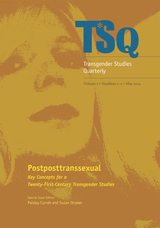 Postposttranssexual: Key Concepts for a 21st Century Transgender Studies, Volume 1
Paisley Currah and Susan Stryker
Duke University Press TSQ aims to be the journal of record for the rapidly emerging field of transgender studies. The inaugural issue, "Postposttranssexual: Key Concepts for a 21st-Century Transgender Studies," pays homage to Sandy Stone's field-defining "Posttranssexual Manifesto" and assesses where the field is now and where it seems to be heading. Comprising over eighty short essays by authors ranging from graduate students to senior scholars, the issue takes on such topics as biopolitics, disability, political economy, childhood, trans-of-color critique, area studies, translation, pathologization, the state, and animal studies. Some keyword entries resemble encyclopedia articles (sports, psychoanalysis); others are poetic meditations on concepts (capacity, transition); still others offer whimsical and eccentric expositions of words that are more unexpected-and unexpectedly productive (perfume, hips). Some entries pose trenchant resistances to the keyword concept itself. The issue includes a substantive introduction by the editors and serves as a primer for readers encountering transgender studies for the first time.
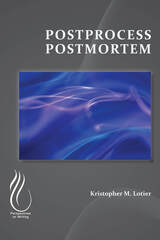 Postprocess Postmortem
M. Kristopher Lotier
University Press of Colorado, 2021 In Postprocess Postmortem, Kristopher M. Lotier surveys the postprocess era-that-never-was, its end, and its after-lives. Employing cutting-edge digital research tools to track the circulation of texts and shifting scales from the global to the local and back again, he offers a revisionist history of a largely unchronicled past. From one perspective, the history of postprocess might seem to be a history of failure: what could have become The Next Big Thing in composition and writing studies during the 1990s and early 2000s never quite ascended. Today, few writing studies scholars apply the term postprocess to their own research or self-identify with a postprocess movement. And yet, as Lotier demonstrates, numerous core postprocess tenets have attained disciplinary centrality. The result: whether they admit to doing so or not, many contemporary scholars employ a postprocess vocabulary, allowing the ideas underlying this important movement/theory/period/attitude to live on.
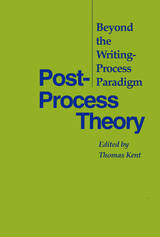 Post-Process Theory: Beyond the Writing-Process Paradigm
Edited by Thomas Kent
Southern Illinois University Press, 1999 Breaking with the still-dominant process tradition in composition studies, post-process theory—or at least the different incarnations of post-process theory discussed by the contributors represented in this collection of original essays—endorses the fundamental idea that no codifiable or generalizable writing process exists or could exist. Post-process theorists hold that the practice of writing cannot be captured by a generalized process or a "big" theory. Most post-process theorists hold three assumptions about the act of writing: writing is public; writing is interpretive; and writing is situated. The first assumption is the commonsensical claim that writing constitutes a public interchange. By "interpretive act," post-process theorists generally mean something as broad as "making sense of" and not exclusively the ability to move from one code to another. To interpret means more than merely to paraphrase; it means to enter into a relationship of understanding with other language users. And finally, because writing is a public act that requires interpretive interaction with others, writers always write from some position or some place. Writers are never nowhere; they are "situated." Leading theorists and widely published scholars in the field, contributors are Nancy Blyler, John Clifford, Barbara Couture, Nancy C. DeJoy, Sidney I. Dobrin, Elizabeth Ervin, Helen Ewald, David Foster, Debra Journet, Thomas Kent, Gary A. Olson, Joseph Petraglia, George Pullman, David Russell, and John Schilb.
Post-processing Techniques in Antenna Measurement
Manuel Sierra Castañer
The Institution of Engineering and Technology, 2019 This book summarises recent developments and enhancements in post-processing techniques that increase the quality and effectiveness of modern antenna measurements. Recent advances in near to far field transformation algorithms for enhancing measurement accuracy in the presence of different common error sources are explained in detail. Developments in techniques for reducing the effect of echoes, noise, and leakage, and to reduce acquisition time, are also explored.
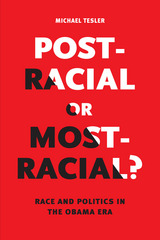 Post-Racial or Most-Racial?: Race and Politics in the Obama Era
Michael Tesler
University of Chicago Press, 2016 When Barack Obama won the presidency, many posited that we were entering into a post-racial period in American politics. Regrettably, the reality hasn’t lived up to that expectation. Instead, Americans’ political beliefs have become significantly more polarized by racial considerations than they had been before Obama’s presidency—in spite of his administration’s considerable efforts to neutralize the political impact of race.
Michael Tesler shows how, in the years that followed the 2008 election—a presidential election more polarized by racial attitudes than any other in modern times—racial considerations have come increasingly to influence many aspects of political decision making. These range from people’s evaluations of prominent politicians and the parties to issues seemingly unrelated to race like assessments of public policy or objective economic conditions. Some people even displayed more positive feelings toward Obama’s dog, Bo, when they were told he belonged to Ted Kennedy. More broadly, Tesler argues that the rapidly intensifying influence of race in American politics is driving the polarizing partisan divide and the vitriolic atmosphere that has come to characterize American politics.
One of the most important books on American racial politics in recent years, Post-Racial or Most-Racial? is required reading for anyone wishing to understand what has happened in the United States during Obama’s presidency and how it might shape the country long after he leaves office.
 The Post-Rapture Diner
Dorothy Barresi
University of Pittsburgh Press, 1996 "[In The Post-Rapture Diner] the brashness and sadness of our polyglot nation is given voice. Dorothy Barresi speaks in tongues - of 'undetonated cherubs,' sitcoms, and agents provocateurs. Her toughminded, eloquent poems articulate family tangles, unintentional cruelties, innocenc and sophistication. . . . The Post-Rapture Diner creates a language commensurate to the ethical complexities of this particular American moment and to the ongoing human dilemma." --Alice Fulton
"[This] new book of poetry imagines southern California as a vast, hot, flat desert wasteland that revises T. S. Eliot's epic locale, finding redemption in lyrical strains of ice-cream trucks and sit-com romance. . . . Barresi's tone is wise and gullible, her cravings material and mystical, metaphorical and theatrical. . . . . I found myself entranced by Barresi's magical specter of the real, the full-bodied images provided by Nureyev or Ralph Kramden-who, after all, has his own ideas about the moon." --Voices in Italian Americana
"Barresi's poetry has wit and pathos. . . . Her metaphors are a delight." --Library Journal
"What a pleasure to find a poet whose sense of risk and honesty drives her to complicate the emotions and attitudes of her poems--so that sorrow might be suddenly hijacked by bravado, or delight by anger and humor-rather than to wrap us up a neat little parcel of agreeable 'sensitivities'. . . .Deeply imagined, full of toughness and great heart, Dorothy Barresi's poems come from the places where we all live now, in America, in the 1990s. I'd pay to read or hear her anytime, I'd stand in line." --Ploughshares
Dorothy Barresi's poems have been published widely in literary journals, including Poetry, Parnassus, the Harvard Review, the Antioch Review and the Kenyon Review, and her essay-reviews appear semi-regularly in the Gettysburg Review. She has been the recipient of Fellowships from the National Endowment for the Arts, the Fine Arts Work Center in Provincetown, and the North Carolina Arts Council. Her poetry has been awarded a Pushcart Prize and the Hart Crane Memorial Poetry Prize. She is a Professor of English at California State University, Northridge, where she is Chair of the Creative Writing program. She lives in Los Angeles, California.
Post-Realism: The Rhetorical Turn in International Relations
Francis A. Beer
Michigan State University Press, 1996 The end of the Cold War encourages new perspectives on international relations. Beer and Hariman provide a comprehensive set of essays that challenge and reinterpret the tradition of realism which has dominated the thinking of academics and foreign policy makers. Post-Realism: The Rhetorical Turn in International Relations systematically discusses the major realist writers of the Post-War era, the foundational concepts of international politics, and representative case studies of foreign policy discourse.
These essays demonstrate how realism operates rhetorically and point the way toward a richer understanding of world politics.
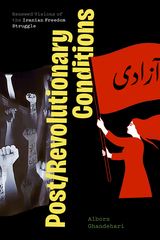 Post/Revolutionary Conditions: Renewed Visions of the Iranian Freedom Struggle
Alborz Ghandehari
Northwestern University Press, 2025 An exploration of how the Iranian people have renewed their longtime struggle for freedom The Woman, Life, Freedom uprising is only the latest manifestation of a century-long struggle for liberation in Iran. This ongoing movement for justice has encompassed two revolutions against domestic dictatorship and foreign imperialism, as well as a series of uprisings since the 1979 Iranian Revolution, which was followed by a new era of repression. Post/Revolutionary Conditions: Renewed Visions of the Iranian Freedom Struggle offers an intersectional analysis of how progressive and radical movement builders have reenvisioned liberation in the post-’79 era, despite new forms of oppression under the Islamic Republic and from US and other foreign imperial powers. Bringing together a diverse array of sources, including oral histories with Iranian labor, student, and gender justice organizers, as well as resistance literature and art, Alborz Ghandehari challenges narratives that treat working-class, feminist, queer, and oppressed ethnic minorities’ movements as separate from one another. Post/Revolutionary Conditions demonstrates how such potent reimaginings of collective liberation and a radically democratic future have been shaped by multiple generations of protest and kindred struggles globally.
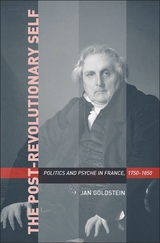 The Post-Revolutionary Self: Politics and Psyche in France, 1750–1850
Jan Goldstein
Harvard University Press, 2005 In the wake of the French Revolution, as attempts to restore political stability to France repeatedly failed, a group of concerned intellectuals identified a likely culprit: the prevalent sensationalist psychology, and especially the flimsy and fragmented self it produced. They proposed a vast, state-run pedagogical project to replace sensationalism with a new psychology that showcased an indivisible and actively willing self, or moi. As conceived and executed by Victor Cousin, a derivative philosopher but an academic entrepreneur of genius, this long-lived project singled out the male bourgeoisie for training in selfhood. Granting everyone a self in principle, Cousin and his disciples deemed workers and women incapable of the introspective finesse necessary to appropriate that self in practice.
Beginning with a fresh consideration of the place of sensationalism in the Old Regime and the French Revolution, Jan Goldstein traces a post-Revolutionary politics of selfhood that reserved the Cousinian moi for the educated elite, outraged Catholics and consigned socially marginal groups to the ministrations of phrenology. Situating the Cousinian moi between the fragmented selves of eighteenth-century sensationalism and twentieth-century Freudianism, Goldstein suggests that the resolutely unitary self of the nineteenth century was only an interlude tailored to the needs of the post-Revolutionary bourgeois order.
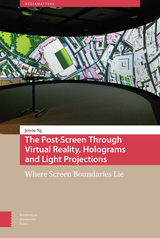 The Post-Screen Through Virtual Reality, Holograms and Light Projections: Where Screen Boundaries Lie
Jenna Ng
Amsterdam University Press, 2022 Screens are ubiquitous today. Yet contemporary screen media eliminate the presence of the screen and diminish the visibility of its boundaries. As the image becomes indistinguishable from the viewer’s surroundings, this unsettling prompts re.examination of how screen boundaries demarcate. Through readings of three media forms – Virtual Reality; holograms; and light projections – this book develops new theories of the surfaces on and spaces in which images are displayed. Interrogating contemporary contestations of reality against illusion, it argues that the disappearance of difference reflects shifted conditions of actuality and virtuality in understanding the human condition. These shifts further connect to the current state of politics by way of their distorted truth values, corrupted terms of information, and internalizations of difference. The Post.Screen Through Virtual Reality, Holograms and Light Projections thus thinks anew the image’s borders and delineations, evoking the screen boundary as an instrumentation of today’s intense virtualizations which do not tell the truth. In the process, a new imagination for images emerges for a gluttony of the virtual; for new conceptualizations of object and representation, materiality and energies, media and histories, real and unreal; for new understandings of appearances, dis-appearances, replacement and re.placement – the post-screen.
Postsecular Benjamin: Agency and Tradition
Brian Britt
Northwestern University Press, 2016 In readings of Walter Benjamin's work, religion often marks a boundary between scholarly camps, but it rarely receives close and sustained scrutiny. Benjamin's most influential writings pertain to modern art and culture, but he frequently used religious language while rejecting both secularism and religious revival. Benjamin was, in today's terms, postsecular. Postsecular Benjamin explicates Benjamin's engagements with religious traditions as resources for contemporary debates on secularism, conflict, and identity. Brian Britt argues that what animates this work on tradition is the question of human agency, which he pursues through lively and sustained experimentation with ways of thinking, reading, and writing.
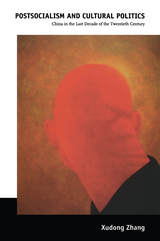 Postsocialism and Cultural Politics: China in the Last Decade of the Twentieth Century
Xudong Zhang
Duke University Press, 2008 In Postsocialism and Cultural Politics, Xudong Zhang offers a critical analysis of China’s “long 1990s,” the tumultuous years between the 1989 Tiananmen Square crackdown and China’s entry into the World Trade Organization in 2001. The 1990s were marked by Deng Xiaoping’s market-oriented reforms, the Taiwan missile crisis, the Asian financial crisis, and the end of British colonial rule of Hong Kong. Considering developments including the state’s cultivation of a market economy, the aggressive neoliberalism that accompanied that effort, the rise of a middle class and a consumer culture, and China’s entry into the world economy, Zhang argues that Chinese socialism is not over. Rather it survives as postsocialism, which is articulated through the discourses of postmodernism and nationalism and through the co-existence of multiple modes of production and socio-cultural norms. Highlighting China’s uniqueness, as well as the implications of its recent experiences for the wider world, Zhang suggests that Chinese postsocialism illuminates previously obscure aspects of the global shift from modernity to postmodernity. Zhang examines the reactions of intellectuals, authors, and filmmakers to the cultural and political conflicts in China during the 1990s. He offers a nuanced assessment of the changing divisions and allegiances within the intellectual landscape, and he analyzes the postsocialist realism of the era through readings of Mo Yan’s fiction and the films of Zhang Yimou. With Postsocialism and Cultural Politics, Zhang applies the same keen insight to China’s long 1990s that he brought to bear on the 1980s in Chinese Modernism in the Era of Reforms.
 Post-Specimen Encounters Between Art, Science and Curating: Rethinking Art Practice and Objecthood through Scientific Collections.
Edited by Edward Juler and Alistair Robinson
Intellect Books, 2020 Post-Specimen Encounters in Art, Science and Curating examines the ways in which scientific objects held within museums and other collections act as inspiration to contemporary art practices, curating strategies, and their histories. With cross-disciplinary contributions from art historians, artists, poets, anthropologists, critics, and curators, this volume looks at how artistic encounters in museums, ranging from anatomy museums to contemporary cabinets of curiosity, can provoke new modes of thinking.
In particular, this volume draws upon the concept of the specimen—a paradigmatic object in science—as a way of critically investigating these hybrid art–science practices and a means of innovating the practice of art writing itself. Edward Juler and Alistair Robinson bring together a variety of interdisciplinary perspectives from leading specialists in the visual arts that inspire new understandings of the relationships between art, science, and curating.
 Poststructuralism and Critical Theory's Second Generation
Edited by Alan D. Schrift
University of Chicago Press, 2010 From Kant to Kierkegaard, from Hegel to Heidegger, continental philosophers have indelibly shaped the trajectory of Western thought since the eighteenth century. Although much has been written about these monumental thinkers, students and scholars lack a definitive guide to the entire scope of the continental tradition. The most comprehensive reference work to date, this eight-volume History of Continental Philosophy will both encapsulate the subject and reorient our understanding of it. Beginning with an overview of Kant’s philosophy and its initial reception, the History traces the evolution of continental philosophy through major figures as well as movements such as existentialism, phenomenology, hermeneutics, and poststructuralism. The final volume outlines the current state of the field, bringing the work of both historical and modern thinkers to bear on such contemporary topics as feminism, globalization, and the environment. Throughout, the volumes examine important philosophical figures and developments in their historical, political, and cultural contexts.
The first reference of its kind, A History of Continental Philosophy has been written and edited by internationally recognized experts with a commitment to explaining complex thinkers, texts, and movements in rigorous yet jargon-free essays suitable for both undergraduates and seasoned specialists. These volumes also elucidate ongoing debates about the nature of continental and analytic philosophy, surveying the distinctive, sometimes overlapping characteristics and approaches of each tradition. Featuring helpful overviews of major topics and plotting road maps to their underlying contexts, A History of Continental Philosophy is destined to be the resource of first and last resort for students and scholars alike.
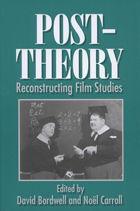 Post-Theory: Reconstructing Film Studies
Edited by David Bordwell and Noël Carroll
University of Wisconsin Press, 1996 With Post-Theory, David Bordwell and Noël Carroll challenge the prevailing practices of film scholarship. Since the 1970s, film scholars have been searching for a unified theory that will explain all sorts of films, their production, and their reception; the field has been dominated by structuralist Marxism, varieties of cultural theory, and the psychoanalytic ideas of Freud and Lacan. Bordwell and Carroll ask, why not employ many theories tailored to specific goals, rather than searching for a unified theory?
Post-Theory offers fresh directions for understanding film, presenting new essays by twenty-seven scholars on topics as diverse as film scores, audience response, and the national film industries of Russia, Scandinavia, the U.S., and Japan. They use historical, philosophical, psychological, and feminist methods to tackle such basic issues as: What goes on when viewers perceive a film? How do filmmakers exploit conventions? How do movies create illusions? How does a film arouse emotion? Bordwell and Carroll have given space not only to distinguished film scholars but to non-film specialists as well, ensuring a wide variety of opinions and ideas on virtually every topic on the current agenda of film studies. Full of stimulating essays published here for the first time, Post-Theory promises to redefine the study of cinema.
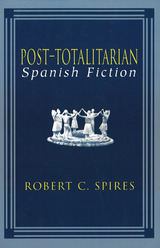 Post-Totalitarian Spanish Fiction
Robert C. Spires
University of Missouri Press, 1996
Focusing on post-Franco Spanish fiction from 1975 to 1989, Robert C. Spires applies the concepts of episteme and discursive field to the ways in which language from multiple sources determines how reality is defined at a given moment and how it influences ideas, attitudes, and feelings. Spires identifies bonds connecting disparate academic disciplines and sociopolitical events by exploring how the world of fiction serves as a register of the nonfictional world.
In 1989 the Soviet bloc, along with other totalitarian regimes in South America and Africa, disappeared from the global geopolitical map. Spain set the precedent for this decentralizing revolution when, in 1975, its longtime dictator, Francisco Franco, died; democratic elections followed two years later. This study records an epistemic shift away from logocentric and totalizing approaches to reality by analyzing the links between the novelistic strategies used by Spanish writers from 1975 to 1989 and recent international events and theoretical trends in science, mathematics, communication studies, and art. Highlighting worldwide processes of fragmentation, decentralization, and pluralism, Spires foregrounds ways in which literary and scientific approaches to and concepts of reality coincide, with fiction serving as one more register of how reality is conceived at a particular point in time.
Post-Totalitarian Spanish Fiction makes a major contribution in the field of Spanish literature and will enhance the esteem that contemporary Spanish literature is beginning to achieve internationally. In addition, this "epistemocritical" project will serve as a model for literary critics who wish to accommodate the increasingly popular approach labeled "cultural studies" without surrendering the primacy of the literary text.
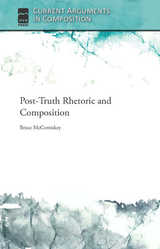 Post-Truth Rhetoric and Composition
Bruce Mccomiskey
Utah State University Press, 2017 Post-Truth Rhetoric and Composition is a timely exploration of the increasingly widespread and disturbing effect of “post-truth” on public discourse in the United States. Bruce McComiskey analyzes the instances of bullshit, fake news, feigned ethos, hyperbole, and other forms of post-truth rhetoric employed in recent political discourse. The book frames “post-truth” within rhetorical theory, referring to the classic triad of logos, ethos, and pathos. McComiskey shows that it is the loss of grounding in logos that exposes us to the dangers of post-truth. As logos is the realm of fact, logic, truth, and valid reasoning, Western society faces increased risks—including violence, unchecked libel, and tainted elections—when the value of reason is diminished and audiences allow themselves to be swayed by pathos and ethos. Evaluations of truth are deferred or avoided, and mendacity convincingly masquerades as a valid form of argument. In a post-truth world, where neither truth nor falsehood has reliable meaning, language becomes purely strategic, without reference to anything other than itself. This scenario has serious consequences not only for our public discourse but also for the study of composition.
The Posture Triangle: A New Framework for U.S. Air Force Global Presence
Stacie L. Pettyjohn
RAND Corporation, 2013 U.S. Air Force (USAF) global posture—its overseas forces, facilities, and arrangements with partner nations—faces a variety of fiscal, political, and military challenges. This report seeks to identify why the USAF needs a global posture, where it needs basing and access, the types of security partnerships that minimize peacetime access risk, and the amount of forward presence that the USAF requires.
 Postures of the Mind: Essays on Mind and Morals
Annette Baier
University of Minnesota Press, 1975 Postures of the Mind was first published in 1985. Minnesota Archive Editions uses digital technology to make long-unavailable books once again accessible, and are published unaltered from the original University of Minnesota Press editions. Annette Baier develops, in these essays, a posture in philosophy of mind and in ethics that grows out of her reading of Hume and the later Wittgenstein, and that challenges several Kantian or analytic articles of faith. She questions the assumption that intellect has authority over all human feelings and traditions; that to recognize order we must recognize universal laws—descriptive or prescriptive; that the essential mental activity is representing; and that mental acts can be analyzed into discrete basic elements, combined according to statable rules of synthesis. In the first group of essays—"Varieties of Mental Postures"—Baier evaluates the positions taken by philosophers ranging from Descartes to Dennett and Davidson. Among her topics are remembering, intending, realizing, caring, representing, changing one's mind, justifying one's actions and feelings, and having conflicting reasons for them. The second group of essays—"Varieties of Moral Postures" - explores the sort of morality we get when all of these capacities become reflective and self-corrective. Some deal with particular moral issues—our treatment of animals, our policies regarding risk to human life, our contractual obligations; others, with more general questions on the role of moral philosophers and the place of moral theory. These essays respond to the theories of Hobbes, Kant, Rawls, and MacIntyre, but Baier's most positive reaction is to David Hume; Postures of the Mind affirms and cultivates his version of a moral reflection that employs feeling and tradition as well as reason.
Postverbal Behavior
Thomas Wasow
CSLI, 2002 Compared to many languages, English has relatively fixed word order, but the ordering among phrases following the verb exhibits a good deal of variation. This monograph explores factors that influence the choice among possible orders of postverbal elements, testing hypotheses using a combination of corpus studies and psycholinguistic experiments. Wasow's final chapters explore how studies of language use bear on issues in linguistic theory, with attention to the roles of quantitative data and Chomsky's arguments against the use of statistics and probability in linguistics.
Postwar Architecture Between Italy and the UK: Exchanges and Transcultural Influences
Edited by Lorenzo Ciccarelli and Clare Melhuish
University College London, 2021 Explores how cultural exchange after World War II produced twentieth-century British and Italian architecture.
In the aftermath of World War II’s devastation, Italy and the United Kingdom reimagined urban space. Post-war Architecture Between Italy and the UK explores how architects, urbanists, and historians in both countries collaborated around the shared need to rebuild. The authors discuss the far-reaching effects of this cultural exchange, including the influence of historic Italian town centers on British public space and the origin of postmodernism in clashes between British critics and Italian architects. Drawing on a wealth of archival materials, this volume offers new insights into architectural history in post-war Europe.
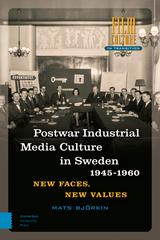 Post-war Industrial Media Culture in Sweden, 1945-1960: New Faces, New Values
Mats Björkin
Amsterdam University Press, 2022 During the 1950s in Sweden, companies aiming for international markets demanded new theories and methods of communication. Ideas regarding cybernetics, systems analysis, new accounting practices, and budgetary principles as well as theories of information, communication, marketing, public relations, and organization were discussed at conferences and seminars and in courses, articles, and books. At the same time, new technologies were introduced that changed corporate communication, from loose-leaf accounting systems to mechanical and electronic business machines, from written texts and oral presentations to slide shows, audio tapes, films, television, and flannelgraphs. By looking at a vast array of objects and relations related to uses of media technologies in Swedish industry from the end of World War II to the breakthrough of television, this book shows what happened in the glitches between mass communication and interaction, and how Swedish industry after the war worked to disrupt established understandings of communication.
Post-War Reflections
Jean-Paul Sartre
Seagull Books, 2021 A compact collection of eight wide-ranging essays by Sartre from the immediate postwar years.
Iconic French novelist, playwright, and essayist Jean-Paul Sartre is widely recognized as one of the most important philosophers of the twentieth century, and his work has remained relevant and thought-provoking through the decades. The Seagull Sartre Library now presents some of his most incisive philosophical, cultural, and literary critical essays in twelve newly designed and affordable editions.
Post-War Reflections collects eight of Sartre’s essays that were written in his most creative period, just after World War II. Sartre’s extraordinary range of engagement is manifest in this collection, which features writings on postwar America, the social impact of war in Europe, contemporary philosophy, race, and avant-garde art.
 Postwar Revisited: A Global Art History
Okwui Enwezor and Atreyee Gupta, editors
Duke University Press, 2025 Okwui Enwezor’s 2016 exhibition Postwar: Art between the Pacific and the Atlantic, 1945–1965 redefined the history of art produced in those two decades. Nearly a decade later, Postwar Revisited returns to these debates to present an image of a historical period in which Western conceptions of art, aesthetics, and philosophy are all thrown into intense flux after Auschwitz and Hiroshima, while the cultural energies of decolonization generate myriad artistic and intellectual practices across the globe, which re-engage the connections of art to life itself. Focusing on modernist artists, artist collectives, and architects central to dissonant regional traditions, as well as influential exhibitions and patronage systems, the contributors produce a new understanding of emergent postwar global art. Provoking new ways of thinking, engaging, and narrating art history, Postwar Revisited is essential reading for those interested in debates on global art history and global modernism, the intersections between art and decolonization, the cultural aspects of the Cold War and the Non-Aligned Movement, and modern and contemporary art more generally.
Contributors. Iftikhar Dadi, Okwui Enwezor, Patrick Flores, Hal Foster, Boris Groys, Atreyee Gupta, Elizabeth Harney, Jennifer Josten, Vivian Li, Tara McDowell, Alexandra Munroe, Nada Shabout, Terry Smith, Jenni Sorkin, Ming Tiampo
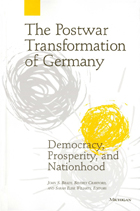 The Postwar Transformation of Germany: Democracy, Prosperity and Nationhood
John S. Brady, Beverly Crawford, and Sarah Elise Wiliarty, Editors
University of Michigan Press, 1999 As Germany celebrates the fiftieth anniversary of the founding of the Federal Republic of Germany--the former West Germany-- leading scholars take stock in this volume of the political, social, and economic progress Germany made as it built a democratic political system and a powerful economy, survived the Cold War, and dealt with the challenges of reunification.
The contributors address issues such as Germany's response to extremists, the development of a professional civil service, judicial review, the maintenance of the welfare state, the nature of contemporary German nationalism, and Germany's role in the world.
Contributors are Thomas Banchoff, Thomas U. Berger, Patricia Davis, Ernst Haas, Jost Halfmann, Christard Hoffmann, Carl-Lugwig Holtfrerich, Donald P. Kommers, Wolfgang Krieger, Peter Krueger, Gregg O. Kvistad, Ludger Lindlar, Charles Maier, Andrei Markovitz, Peter Merkl, Claus Offe, Simon Reich, and Michaela Richter.
John S. Brady and Sarah Elise Wiliarty are doctoral candidates in the Department of Political Science, University of California, Berkeley. Beverly Crawford is Professor of Political Science, Senior Lecturer in Political Economy of Industrial Societies, and Associate Director, Center for German and European Studies, University of California, Berkeley.
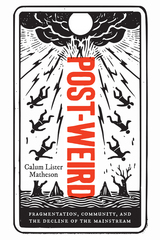 Post-Weird: Fragmentation, Community, and the Decline of the Mainstream
Calum Lister Matheson
Rutgers University Press, 2026 An ambitious look at rhetoric and psychosis that explores how communities form when society collapses American society seems to have fractured. Common touchpoints of authority have receded in recent decades and beliefs that were once taboo are now openly shared, from neo-Nazism to occultism to conspiracy thinking. In this book, Calum Lister Matheson goes beyond the fraying of contemporary American culture to ask how splinter communities form in our current media environment, what keeps them together, and what they build from the ruins of shared language. In his stirring exploration of how people communicate when old forms of authority and meaning collapse, Matheson examines far-flung groups that have departed the mainstream—Sandy Hook deniers, Appalachian serpent handlers, pro-anorexia bloggers, incels, transvestigators, pseudoscientific reactionaries, and more—and finds unexpected similarities among their many differences. Key among their parallels is the insistence that the symbols shared by each community represent a hidden truth that cannot be questioned or interpreted but is revealed through signs—words, images, videos, and texts. By documenting American fringe cultures, extremism, and the social functions of language, this book rethinks concepts like irony, psychosis, propriety, and what it means to be normal in weird times.
 Post-World War One Plebiscites and Their Legacies: Exploring the Right of Self-Determination
Sergiusz Bober
Central European University Press, 2024 Plebiscites, or referendums, are epitomes of direct democracy and the right of self-determination. While direct democracy has always been a key subject in the theory and practice of western liberal democracies, the issue of self-determination has been propelled to the fore by the hegemonistic moves of Russia. By providing a historical analysis of the post-World War One plebiscites, this book deals with enduring, painfully contemporary, and in in any case fundamental, concepts. The contributors to this edited volume approach the referendums comparatively. After grounding the analysis theoretically, the authors look at detailed aspects of individual cases, with the two plebiscites held in the Danish-German border region of Schleswig in the winter of 1920 as points of departure. They then extend the exploration through the inter-war period and address the effects of border delimitations on everyday life or gender roles in the context of ethnic mobilization. Finally, the book places the post-World War One plebiscites in a long-term perspective. The concluding essays assess, among others, the applicability of plebiscitary solutions to contemporary conflicts, taking into consideration issues of borders, religion, language, identity, and minority rights.
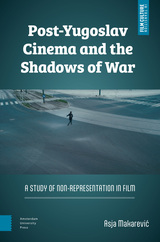 Post-Yugoslav Cinema and the Shadows of War: A Study of Non-Representation in Film
Asja Makarevic
Amsterdam University Press, 2025 Bosnia-Herzegovina is still considered a post-war country. The concept of "post-war" implies that the country and its people are tied more strongly to the past than they are oriented towards the future. Paradoxically, as long as the future is kept at bay and the post-war condition kept alive, Bosnia maintains a certain significance on the global scene. However, living in the temporal vacuum of the post-war condition cannot be a long-term perspective. A range of post-Yugoslav films provides spectators with images that offer innovative approaches to the collective past, while simultaneously reframing contemporary experience. What the author proposes to call non-representational images appears to offer a more dynamic relationship to the past and the present, while reflecting complex processes of the formation of identity, memory, guilt, and responsibility. But if these dynamics are inherent in non-representational images, is there a way in which they can contribute to overcoming the post-war condition?
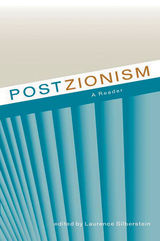 Postzionism: A Reader
Silberstein, Laurence
Rutgers University Press, 2008 Postzionism first emerged in the mid-1980s in writings by historians and social scientists that challenged the dominant academic versions of Israeli history, society, and national identity. Subsequently, this critique was expanded and sharpened in the writings of philosophers, cultural critics, legal scholars, and public intellectuals. This reader provides a broad spectrum of innovative and highly controversial views on Zionism and its place in the global Jewish world of the twenty-first century. While not questioning Israel’s legitimacy as a state, many contributors argue that it has yet to become a fully democratic, pluralistic state in which power is shared among all of its citizens. Essays explore current attitudes about Jewish homeland and diaspora as well as the ways that zionist discourse contributes to the marginalization and exclusion of such minority communities as Palestinian citizens, Jews of Middle-Eastern origin (Mizrahim), women, and the queer community.
An introductory essay describes Postzionism and contextualizes each contribution within the broader discourse. The most complete collection of postzionist documents available in English, this anthology is essential reading for students and scholars of Jewish identity, Middle-Eastern conflict, and Israeli history.
 Pot Roast, Politics, and Ants in the Pantry: Missouri's Cookbook Heritage
Carol Fisher & John Fisher
University of Missouri Press, 2008
When is a cookbook more than just a cookbook? When it’s a gateway to our culinary heritage. For well over a hundred years, Missouri’s cookbooks have helped readers serve up tasty dishes to the state’s tables, but these publications also document the evolution of our kitchens and households.
Pot Roast,Politics, and Ants in the Pantry, a treasure trove of anecdotes and nuggets of historical information about cookery in the Show-Me State, draws from more than 150 publications to reveal Missouri’s cookbook heritage and to deliver a generous sampling of recipes. Carol Fisher and John Fisher look back to manuscript cookbooks from 1821 St. Louis, then progress through the years and around Missouri before arriving at today’s online recipes. Along the way, they dish out servings of kitchen medicine, household hints, and cookbook literature gleaned from the state’s cache of culinary gems.
From handwritten family recipe collections and mimeographed publications to glossy color editions, the texts the Fishers have obtained from libraries and historical societies as well as their own extensive cookbook collection include such curiosities as the Julia Clark Household Memoranda Book from the William Clark papers, an 1880 production by the Ladies of St. Louis called My Mother’s Cookbook, Mary Foote Henderson’s Practical Cooking and Dinner Giving, and Albert E. Brumley’s All-Day Singin’ and Dinner on the Ground. They tell how various ethnic communities raised money by creating cookbooks, how the state’s Beef Council and Pork Association put recipes on the Internet, and how restaurants like the Blue Owl in Kimmswick and Stephenson’s Apple Farm Restaurant near Kansas City enhanced their reputations with their own cookbooks. Festival cookbooks, company cookbooks, even cookbooks tied to world events—they’re all here in one delightful book.
In this vastly entertaining review, readers will learn where to find recipes for dandelion wine, mock turtle soup (requiring a large calf’s head split open by the butcher), and vinegar pie—as well as the curative properties of potato water, tips for raising chickens in the basement, and even “how to cook a husband.” An extensive bibliography includes information to help readers track down the books discussed and also those on their own wish lists.
Pot Roast, Politics, and Ants in the Pantry: Missouri’s Cookbook Heritage shows how, instead of being just collections of recipes, cookbooks provide history lessons, document changing food ways, and demonstrate the cultural diversity of the state. From Julia Clark’s simple frontier recipes for puddings and preserves to Irma Rombauer’s encyclopedic Joy of Cooking—originally self-published in Missouri—Carol Fisher and John Fisher have laid out a smorgasbord of reading pleasure for cookbook collectors, nostalgia buffs, and gourmands alike.
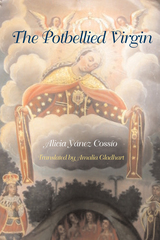 The Potbellied Virgin
By Alicia Yánez Cossío
University of Texas Press, 2006 In an unnamed town in the Ecuadorian Andes, a small wooden icon—La Virgen Pipona (the Potbellied Virgin)—conceals the documents that define the town's social history. That history recently has been dominated by the women of the Benavides family, a conservative clan and, not coincidentally, the caretakers of the Virgin. Their rivals are the Pandos, a family led by four old men who spend their days smoking in the park across from the Virgin's cathedral and offering revisionist versions of local and national events. When a military skirmish threatens the Virgin (and the secret in her famous belly), the Benavides women must scramble to preserve their place as local matriarchs—without alerting the old Pandos to the opportunity that might enable them to finally supplant their rivals. One of Ecuador's foremost contemporary writers, Alicia Yánez Cossío illuminates the complexity of Andean society by placing disenfranchised players such as women and Amerindians onstage with traditional powers such as the military and the church. Folk wisdom, exemplified in The Potbellied Virgin by the beautifully translated proverbs so popular with the Benavideses and the Pandos alike, stands up to historical record. Such inclusiveness ultimately allows the whole truths of Yánez Cossío's subjects to emerge. Only the second of her novels to be translated into English, The Potbellied Virgin (La cofradía del mullo del vestido de la Virgen Pipona) is a funny, focused portrait of Ecuadorian life in the twentieth century.
 The Potential of a Middle Power: Romania's Foreign Policy in Central Asia within the Context of EU Membership
Ana-Maria Anghelescu
Central European University Press The large member states of the European Union have clear priorities when it comes to EU-level decisions, while the small member states hold veto power when decisions need to be taken unanimously. This book focuses on the potential of middle powers in EU decision-making using the example of Romania's relations with Central Asia. The author examines how Romania's diplomatic activities as a medium-sized member state - and as a newer member - can affect EU foreign policy. Ana-Maria-Andreea Anghelescu conducted a quantitative study of three hard power indices, as well as the soft presence dimension of the Elcano Index of Global Presence. The latter includes tourism, sport, culture, science, education, information, and migration. The statistical results were complemented by qualitative field research in Kyrgyzstan involving all five Central Asian countries.
The volume’s analysis concludes that Romania underperforms in using its robust hard faculties to benefit the country's soft capabilities. Central Asia is a region where the EU must work hard to maintain its influence. By strengthening their presence in the region beyond bilateral partnerships, the EU's middle powers can play a key role in asserting Europe's pragmatic and normative interests.T
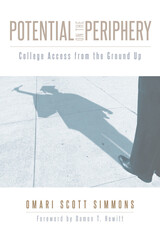 Potential on the Periphery: College Access from the Ground Up
Omari Scott Simmons
Rutgers University Press, 2019 Even high-performing students sometimes need assistance to transform their high school achievement into a higher education outcome that matches their potential, especially when those students come from vulnerable backgrounds. Without intervention, many of these students, lost in the transition between secondary school and higher education, would not attend selective colleges that provide greater opportunities. Potential on the Periphery profiles the Simmons Memorial Foundation (SMF), a grassroots non-profit organization co-founded by author Omari Scott Simmons, that promotes college access for students in North Carolina and Delaware. Simmons discusses how the organization has helped students secure admission and succeed in college, using this example to contextualize the broader realm of existing education practice, academic theory, and public policy. Using data gleaned from interviews with past student participants in the programs run by the SMF, Simmons illuminates the underlying factors thwarting student achievement, such as inadequate information about college options, limited opportunities for social capital acquisition, financial pressures, self-doubt, and political weakness. Simmons then identifies policy solutions and pragmatic strategies that college access organizations can adopt to address these factors.
Potential Stranger
Killarney Clary
University of Chicago Press, 2003 On page after enigmatic page, Killarney Clary shows us her mastery of the prose poem in this spiritual biography that journeys across the natural landscape while plumbing the dizzying depths of the psyche. Potential Stranger reveals that in the public world we are all called upon to perform: as children, we are expected to find a place in the uniform; as entertainers, to play an exaggerated version of ourselves; and, as explorers, to rest content when we have reached our destination. Precise, prophetic, and spare, Clary reminds us that of all the potential strangers we may meet in our travels, people who forever "remain behind gestures and posture," the first and last of those is always the self.
 The Potentials About a Point Electrode and Apparent Resistivity Curves for a Two-, Three-, and Four-Layer Earth
Harold M. Mooney and W. W. Wetzel
University of Minnesota Press, 1956
The Potentials About a Point Electrode and Apparent Resistivity Curves for a Two-, Three-, and Four-Layer Earth was first published in 1956. Minnesota Archive Editions uses digital technology to make long-unavailable books once again accessible, and are published unaltered from the original University of Minnesota Press editions.
This publication will be useful to geophysicists, geologists, and others engaged in exploration for minerals by electrical methods, and may be used in theoretical studies of electrical prospecting. It makes available for the first time a comprehensive collection of 2268 master resistivity curves for a two-, three-, and four-layer earth. All previous collections of curves for Wenner electrode configuration are included, so the user will not need to refer elsewhere to complete his set of working curves. In addition, the basic potential data used in computing the curves is given in tables. Auxiliary tables are provided to reduce the graphic integration procedures to simple arithmetic. The integral in question occurs widely in solutions to Laplace's equation.
 Pothole Confidential: My Life as Mayor of Minneapolis
R.T. Rybak
University of Minnesota Press, 2016 A pajama party at the Minneapolis–St. Paul International Airport inadvertently helped launch R.T. Rybak’s political career (imagine a rumba line one hundred protesters long chanting, “We deserve to sleep, hey!”), but his earliest lessons in leadership occurred during his childhood. Growing up in a middle-class neighborhood, attending private school with students who had much more than he did, spending evenings at his family’s store in an area where people lived with much less, he witnessed firsthand the opportunity and injustice of the city he called home.
In a memoir that is at once a political coming-of-age story and a behind-the-scenes look at the running of a great city, the three-term mayor takes readers into the highs and lows and the daily drama of a life inextricably linked with Minneapolis over the past fifty years. With refreshing candor and insight, Rybak describes his path through journalism, marketing, and community activism that led to his unlikely (to him, at least) primary election—on September 11, 2001. His personal account of the challenges and crises confronting the city over twelve years, including the tragic collapse of the I-35W bridge, the rising scourge of youth violence, and the bruising fight over a ban on gay marriage (with Rybak himself conducting the first such ceremony at City Hall on August 1, 2013), is also an illuminating, often funny depiction of learning the workings of the job, frequently on the fly, while trying to keep up with his most important constituency, his family.
As bracing as the “fresh air” campaign that swept him into office, Rybak’s memoir is that rare document from a politician: one more concerned with the people he served and the issues of his time than with burnishing his own credentials. As such, it reflects what leadership truly looks like.
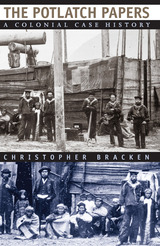 The Potlatch Papers: A Colonial Case History
Christopher Bracken
University of Chicago Press, 1997 Variously described as an exchange of gifts, a destruction of property, a system of banking, and a struggle for prestige, the potlatch is one of the founding concepts of anthropology. Some researchers even claim to have discovered traces of the potlatch in all the economies of the world.
However, as Christopher Bracken shows in this elegantly argued work, the potlatch was in fact invented by the nineteenth-century Canadian law that sought to destroy it. In addition to giving the world its own potlatch, the law also generated a random collection of "potlatch papers" dating from the 1860s to the 1930s. Bracken meticulously analyzes these documents—some canonical, like Franz Boas's ethnographies, others unpublished and little known—to catch a colonialist discourse in the act of constructing fictions about certain First Nations and then deploying those fictions against them. Rather than referring to objects that already exist, the "potlatch papers" instead gave themselves something to refer to; a mirror in which to observe not "the Indian," but "the European."
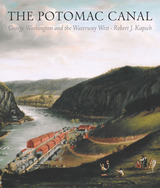 POTOMAC CANAL: GEORGE WASHINGTON AND THE WATERWAY WEST
ROBERT J. KAPSCH
West Virginia University Press, 2007 The Potomac Canal: George Washington and the Waterway West is a history of a new nation’s first effort to link the rich western agricultural lands with the coastal port cities of the east. The Potomac Canal Company was founded in 1785, and was active until it was overtaken by the Chesapeake and Ohio Canal Company in 1828. During its operation, the canal system was used to ship flour from mills in the foothills of Appalachia to the tidewater of the Chesapeake, where the flour was shipped to the Caribbean as trade for sugar and other goods. This trade soon became the basis of agricultural wealth in West Virginia’s eastern panhandle and throughout the Appalachian Piedmont. Coal was also shipped via the canal system from the upper reaches of the Potomac River to workshops at Harpers Ferry and beyond. This industrial trade route laid the foundation for what would eventually become the Chesapeake and Ohio Canal and the Baltimore and Ohio Railroad.
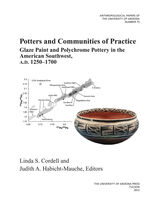 Potters and Communities of Practice: Glaze Paint and Polychrome Pottery in the American Southwest, AD 1250 to 1700
Edited by Linda S. Cordell and Judith A. Habicht-Mauche
University of Arizona Press, 2012 The peoples of the American Southwest during the 13th through the 17th centuries witnessed dramatic changes in settlement size, exchange relationships, ideology, social organization, and migrations that included those of the first European settlers. Concomitant with these world-shaking events, communities of potters began producing new kinds of wares—particularly polychrome and glaze-paint decorated pottery—that entailed new technologies and new materials. The contributors to this volume present results of their collaborative research into the production and distribution of these new wares, including cutting-edge chemical and petrographic analyses. They use the insights gained to reflect on the changing nature of communities of potters as they participated in the dynamic social conditions of their world.
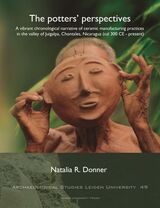 The Potters’ Perspectives: A Vibrant Chronological Narrative of Ceramic Manufacturing Practices in the Valley of Juigalpa, Chontales, Nicaragua (cal 300 CE–present)
Natalia R. Donner
Leiden University Press, 2020 The work of Fernand Braudel (1902–1985) should have revolutionized the way the field of archaeology thinks about the passage of time and constructs narratives throughout it. Braudel’s more general theories deeply affected archaeological theory, yet his three different timescales, as well as his insights into duration as the inner dialectic between different temporalities, remain largely unexplored by practicing archaeologists. Even today, ceramic chronology-building in archaeology still relies on two main variables: time-space and pottery styles. This book seeks to upset that paradigm, proposing instead a radical new approach to creating chronology. This endeavor begins in the valley of Juigalpa, in central Nicaragua, using materials—especially ceramics—as complex palimpsests, through which a chronology that includes five different intervals based on ceramic technologies is presented, from the first traces of human practices in 300 CE through to the present.
 A Potter's Progress: Emanuel Suter and the Business of Craft
Scott Suter
University of Tennessee Press, 2019 Born into a traditional culture in 1833, Emanuel Suter cultivated the art of pottery and expanded markets across the Shenandoah Valley of Virginia, creating a thriving company and leaving thousands of examples of utilitarian ceramic ware that have survived down to the present. Drawing on Suter’s diary—rich with meticulous descriptions of his ceramic wares, along with glazing recipes and the quotidian details of nineteenth-century business—as well as myriad other primary and secondary sources, Suter’s great-great-grandson Scott Hamilton Suter tells the story of how a farmer with a seasonal sideline developed into a technologically advanced entrepreneur who operated a modern industrial company. As a farmer, Emanuel Suter innovated by adopting new time-saving equipment; this progressive thinking bled over into his religious life, as he endeavored to change the traditional way of choosing ministers by lot and advocated for the formation of Sunday schools in the Mennonite Church. But Suter largely made his mark as a potter, and A Potter’s Progress is enhanced by nearly two dozen color images and a close study of the techniques (including kilns and jigger wheels), products, shop organization, marketing, and labor of Suter’s shops, revealing the revolutionary role they played in the world of Rockingham County, Virginia, pottery manufacture. This tightly focused case study of the trials and triumphs of one craftsman as he moved from a cottage industry to a full-scale industrial enterprise—prefiguring the market economy that would characterize the twentieth century—serves as a microcosm for examining the American spirit of progress in late nineteenth-century America.
A Potter's Workbook
Clary Illian
University of Iowa Press, 1999 In A Potter's Workbook, renowned studio potter and teacher Clary Illian presents a textbook for the hand and the mind. Her aim is to provide a way to see, to make, and to think about the forms of wheel-thrown vessels; her information and inspiration explain both the mechanics of throwing and finishing pots made simply on the wheel and the principles of truth and beauty arising from that traditional method. Each chapter begins with a series of exercises that introduce the principles of good form and good forming for pitchers, bowls, cylinders, lids, handles, and every other conceivable functional shape. Focusing on utilitarian pottery created on the wheel, Illian explores sound, lively, and economically produced pottery forms that combine an invitation to mindful appreciation with ease of use. Charles Metzger's striking photographs, taken under ideal studio conditions, perfectly complement her vigorous text.
Pottery Analysis: A Sourcebook
Prudence M. Rice
University of Chicago Press, 1987 Pottery Analysis is a rich and comprehensive sourcebook that draws together diverse approaches to the study of pottery—archaeological, ethnographic, stylistic, functional, and physicochemical. Using pottery as a starting point for insights into people and culture, Prudence M. Rice examines in detail the methods for studying the fired clay vessels used worldwide from prehistoric times to present.
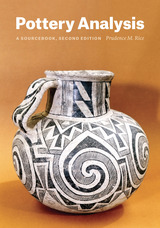 Pottery Analysis, Second Edition: A Sourcebook
Prudence M. Rice
University of Chicago Press, 2015 Just as a single pot starts with a lump of clay, the study of a piece’s history must start with an understanding of its raw materials. This principle is the foundation of Pottery Analysis, the acclaimed sourcebook that has become the indispensable guide for archaeologists and anthropologists worldwide. By grounding current research in the larger history of pottery and drawing together diverse approaches to the study of pottery, it offers a rich, comprehensive view of ceramic inquiry.
This new edition fully incorporates more than two decades of growth and diversification in the fields of archaeological and ethnographic study of pottery. It begins with a summary of the origins and history of pottery in different parts of the world, then examines the raw materials of pottery and their physical and chemical properties. It addresses ethnographic and ethnoarchaeological perspectives on pottery production; reviews the methods of studying pottery’s physical, mechanical, thermal, mineralogical, and chemical properties; and discusses how proper analysis of artifacts can reveal insights into their culture of origin. Intended for use in the classroom, the lab, and out in the field, this essential text offers an unparalleled basis for pottery research.
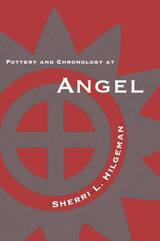 Pottery and Chronology at Angel
Sherri Hilgeman
University of Alabama Press, 2000 By analyzing the pottery found at a well-known archaeological site, Hilgeman constructs the long-awaited timeline for the rise and decline of this ancient society. Located near present-day Evansville, Indiana, the Angel site is one of the important archaeological towns associated with prehistoric Mississippian society. More than two million artifacts were collected from this site during excavations from 1939 to 1989, but, until now, no systematic survey of the pottery sherds had been conducted. This volume, documenting the first in-depth analysis of Angel site pottery, also provides scholars of Mississippian culture with a chronology of this important site.
Angel is generally thought to have been occupied from before A.D. 1200 to 1450, but scholars have been forced to treat this period as one chronological unit without any sense of the growth and decline of the society that occupied it. Using radiocarbon assays and an analysis of its morphological and stylistic attributes of pottery, Sherri Hilgeman is able to divide the occupation of Angel into a series of recognizable stages. She then correlates those stages with similar ones at other archaeological excavations—especially nearby Kincaid—making it possible to compare Angel society with other native cultures of the lower Ohio Valley. Through this important contribution to native pottery studies, Hilgeman opens a window into the lifeways of prehistoric Angel society and places that society in the larger context of Mississippian culture.
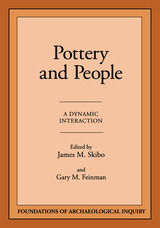 Pottery and People
James Skibo
University of Utah Press, 1998 This volume emphasizes the complex interactions between ceramic containers and people in past and present contexts. Pottery, once it appears in the archaeological record, is one of the most routinely recovered artifacts. It is made frequently, broken often, and comes in endless varieties according to economic and social requirements. Moreover, even in shreds ceramics can last almost forever, providing important clues about past human behavior. The contributors to this volume, all leaders in ceramic research, probe the relationship between humans and ceramics. Here they offer new discoveries obtained through traditional lines of inquiry, demonstrate methodological breakthroughs, and expose innovative new areas for research. Among the topics covered in this volume are the age at which children begin learning pottery making; the origins of pottery in the Southwest U.S., Mesoamerica, and Greece; vessel production and standardization; vessel size and food consumption patterns; the relationship between pottery style and meaning; and the role pottery and other material culture plays in communication. Pottery and People provides a cross-section of the state of the art, emphasizing the complete interactions between ceramic containers and people in past and present contexts. This is a milestone volume useful to anyone interested in the connections between pots and people.
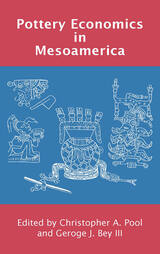 Pottery Economics in Mesoamerica
Edited by Christopher A. Pool and George J. Bey III
University of Arizona Press, 2008 Pottery is one of the most important classes of artifacts available to archaeologists and anthropologists. Every year, volumes of data are generated detailing ceramic production, distribution, and consumption. How these data can be interpreted in relation to the social and cultural framework of prehistoric societies in Mesoamerica is the subject of this book.
Nine chapters written by some of the most well known and respected scholars in the field offer readers an in-depth look at key advances from the past fifteen years. These scholars examine ethnoarchaeological studies and the Preclassic/Formative, Classic, and Postclassic periods and cover geographic areas from eastern to central Mesoamerica. In a series of case studies, contributors address a range of new and developing theories and methods for inferring the technological, organizational, and social dimensions of pottery economics, and draw on a range of sociopolitical examples. Specific topics include the impacts and costs of innovations, the role of the producer in technological choices, the outcomes when errors in vessel formation are tolerated or rectified, the often undocumented multiple lives and uses of ceramic pieces, and the difficulties associated with locating and documenting ceramic production areas in tropical lowlands.
A compelling collection that clearly integrates and synthesizes a wide array of data, this book is the definitive text on pottery economics in Mesoamerica and an important contribution to the fields of anthropology, archaeology, ancient history, and the economics of pre-industrial societies.
CONTENTS
Acknowledgments
1 . Conceptual Issues in Mesoamerican Pottery Economics
Christopher A. Pool and George J. Bey III
2 . An Ethnoarchaeological Perspective on Local Ceramic Production and Distribution in the Maya Highlands
Michael Deal
3 . Why Was the Potter’s Wheel Rejected? Social Choice and Technological Change in Ticul, Yucatán, Mexico
Dean E. Arnold, Jill Huttar Wilson, and Alvaro L. Nieves
4 . Ceramic Production at La Joya, Veracruz: Early Formative Techno Logics and Error Loads
Philip J. Arnold III
5 . Blanco Levantado: A New World Amphora
George J. Bey III
6 . Pottery Production and Distribution in the Gulf Lowlands of Mesoamerica
Barbara L. Stark
7 . Household Production and the Regional Economy in Ancient Oaxaca: Classic Period Perspectives from Hilltop El Palmillo and Valley-Floor Ejutla
Gary M. Feinman and Linda M. Nicholas
8 . Pottery Production and Exchange in the Petexbatun Polity, Petén, Guatemala
Antonia E. Foias and Ronald L. Bishop
9 . Aztec Otumba, AD 1200--1600: Patterns of the Production, Distribution, and Consumption of Ceramic Products
Thomas H. Charlton, Cynthia L. Otis Charlton, Deborah L. Nichols, and Hector Neff
References Cited
About the Contributors
Index
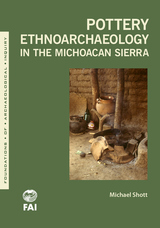 Pottery Ethnoarchaeology in the Michoacán Sierra
Michael J. Shott
University of Utah Press, 2018 Although most ceramic studies describe vessel production and use, the causes and rates of pottery discard are often neglected in archaeological studies. Michael Shott presents analytical methods for determining pottery use life and demonstrates why use life should not be overlooked.
Over a five-year period Shott inventoried the household pottery of about twenty-five homes in five towns in Michoacán, Mexico, recording age and types of use. He also looked at a subsample on a monthly basis over two years to estimate the magnitude of early vessel failure that would go unnoticed in an annual census. His analysis of about 900 vessels clearly shows that context does not explain use life, but vessel size does. Bigger pots last longer. Consulting other ethnoarchaeological sources for comparison and cross-cultural perspectives, Shott shows that his results can be applied to other archaeological datasets for determining numbers of original whole vessels as well as site occupation span.
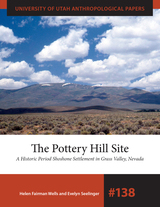 The Pottery Hill Site: A Historic Period Shoshone Settlement in Grass Valley, Nevada
Helen Fairman Wells and Evelyn Seelinger
University of Utah Press, 2023 This archaeological study of the interactions between Western Shoshone families and Euro-American ranchers in the late nineteenth century helps fill the gap between what is known regarding Late Prehistoric foragers of the American West and ethnohistoric understanding of Native American peoples of the Great Basin.
Pottery Hill, an archaeological site located in Grass Valley, Nevada, northeast of the historic mining town of Austin, represents a small settlement of Native Americans who lived there in the late 1800s. The Grass Valley Shoshone, whose environment and traditional lifeways were disrupted by the arrival of miners and settlers in the 1860s, found work on the ranches and farms in the valley.
Archaeological fieldwork conducted in the 1970s investigated house remains, hearths, and artifacts. A recent analysis of these data, enhanced by the use of archival documents and oral history, provides new insights into the dynamics of late nineteenth-century life in central Nevada. The Pottery Hill Site addresses a critical period in the history of the Grass Valley Shoshone, who adopted and modified Euro-American artifacts and materials while maintaining important aspects of their traditional culture. It gives readers a deeper understanding of the effects of Euro-American settlement on the Shoshone, the history of the western United States, and the reciprocal impacts of cultural contact.
Pottery of the Great Basin and Adjacent Areas: UUAP 111
Suzanne Griset
University of Utah Press, 1986 This volume is compilation of individual papers from the Great Basin/California Pottery Workshop of April 1983. The papers include data reports, literature reviews, statements of theoretical positions, and analytical methodology. All address ceramics, primarily of undecorated wares, from the Great Basin and nearby areas.
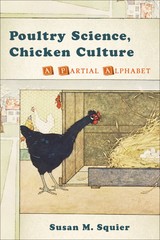 Poultry Science, Chicken Culture: A Partial Alphabet
Squier, Susan M
Rutgers University Press, 2010 Poultry Science, Chicken Culture is a collection of engrossing, witty, and thought-provoking essays about the chicken-the familiar domestic bird that has played an intimate part in our cultural, scientific, social, economic, legal, and medical practices and concerns since ancient Egypt, Greece, and Rome. Organized as a primer, the book reaches beyond narrow disciplines to discover why individuals are so fascinated with the humble, funny, overlooked, and omnipresent chicken.
Spanning fascinating and diverse fields, Susan Merrill Squier assesses the chicken as the focus of film, photography, and visual art in many media; details some of the roles played by chickens and eggs in the development of embryology, biology, and regenerative medicine; traces the iconic figure of the chicken (and the chicken thief) in political discourse during the 2008 presidential election; demonstrates the types of knowledge that have been lost as food production moved from small-scale farming to industrial agriculture; investigates the connection between women and chickens; analyzes the fears and risks behind the panic around avian flu; and scrutinizes the role of chicken farming in international development. A combination of personal passion and surprising scholarly information, Poultry Science, Chicken Culture will change forever the way you think about chickens.
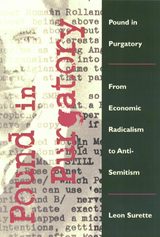 Pound in Purgatory: From Economic Radicalism to Anti-Semitism
Leon Surette
University of Illinois Press, 1999 Pound in Purgatory, available now in paperback, overturns all previous explanations of Ezra Pound's anti-Semitism by uncovering its roots in economic and conspiracy theory. Leon Surette demonstrates that, contrary to popular opinion, Pound was not a life-long anti-Semite and consistently ignored or resisted anti-Semitic comments from his correspondents until after 1931.
From 1931 to 1945 Pound's poetry took a back seat to his activities as an economic reformer and propagandist for the corporate state. Pound believed he had a simple and practical solution for the economic woes of the world brought on by the Great Depression, and he became increasingly preoccupied with capturing political power for the economic reform he envisioned.
As the world spiraled toward war, Pound's program of economic reform foundered and he gradually succumbed to a paranoid belief in a Jewish conspiracy. Through an incisive analysis of Pound's correspondence and writings, much of it previously unexamined, Surette shows how this belief fostered the virulent anti-Semitism that pervades his work-–both poetry and prose-–from this time forward.
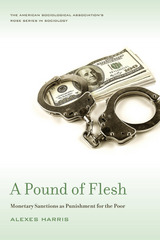 A Pound of Flesh: Monetary Sanctions as Punishment for the Poor
Alexes Harris
Russell Sage Foundation, 2016 Over seven million Americans are either incarcerated, on probation, or on parole, with their criminal records often following them for life and affecting access to higher education, jobs, and housing. Court-ordered monetary sanctions that compel criminal defendants to pay fines, fees, surcharges, and restitution further inhibit their ability to reenter society. In A Pound of Flesh, sociologist Alexes Harris analyzes the rise of monetary sanctions in the criminal justice system and shows how they permanently penalize and marginalize the poor. She exposes the damaging effects of a little-understood component of criminal sentencing and shows how it further perpetuates racial and economic inequality. Harris draws from extensive sentencing data, legal documents, observations of court hearings, and interviews with defendants, judges, prosecutors, and other court officials. She documents how low-income defendants are affected by monetary sanctions, which include fees for public defenders and a variety of processing charges. Until these debts are paid in full, individuals remain under judicial supervision, subject to court summons, warrants, and jail stays. As a result of interest and surcharges that accumulate on unpaid financial penalties, these monetary sanctions often become insurmountable legal debts which many offenders carry for the remainder of their lives. Harris finds that such fiscal sentences, which are imposed disproportionately on low-income minorities, help create a permanent economic underclass and deepen social stratification. A Pound of Flesh delves into the court practices of five counties in Washington State to illustrate the ways in which subjective sentencing shapes the practice of monetary sanctions. Judges and court clerks hold a considerable degree of discretion in the sentencing and monitoring of monetary sanctions and rely on individual values—such as personal responsibility, meritocracy, and paternalism—to determine how much and when offenders should pay. Harris shows that monetary sanctions are imposed at different rates across jurisdictions, with little or no state government oversight. Local officials’ reliance on their own values and beliefs can also push offenders further into debt—for example, when judges charge defendants who lack the means to pay their fines with contempt of court and penalize them with additional fines or jail time. A Pound of Flesh provides a timely examination of how monetary sanctions permanently bind poor offenders to the judicial system. Harris concludes that in letting monetary sanctions go unchecked, we have created a two-tiered legal system that imposes additional burdens on already-marginalized groups.
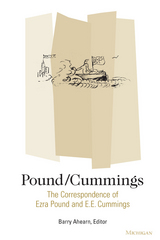 Pound/Cummings: The Correspondence of Ezra Pound and E.E. Cummings
Barry Ahearn, Editor
University of Michigan Press, 1996 Ezra Pound and E. E. Cummings carried on a long and varied correspondence from the 1920s until Cummings's death in 1962. This volume collects all of the important letters from this important friendship in the history of modern poetry.
Throughout the correspondence both poets reveal themselves and their beliefs to a remarkable degree. Pound entrusted to Cummings details of his political outlook in the 1930s and 1940s, including his opinions about Mussolini's Italy. The letters to Cummings also shed new light on the question of Pound's sanity after World War II. Although he was diagnosed as mentally unfit, the letters generally show no evidence of paranoia, only of his characteristic eccentricity.
Similarly, these letters should provoke a reevaluation of Cummings. Critics have treated Cummings's political views as either strictly private matters or merely incidental to his art. The letters, however, show that Cummings's radically conservative political opinions are wholly consistent with his poetics, and raise the question of the relation between Cummings's political principles and his enthusiasm for particular forms (and particular stars) of mass entertainment.
In addition to their political revelations, the letters are steeped in the literary climate--and literary gossip--of the times. Pound comments often and candidly on Cummings's poetry and prose; both Pound and Cummings send light verse to each other. And the poets exchange anecdotes about such figures as Henry James, Wyndham Lewis, T. S. Eliot, Edmund Grosse, Max Eastman, and Aldous Huxley, among other writers.
There is much here to interest and delight both fans and foes of Pound and Cummings. The book will be of primary importance to students and scholars of modern poetry, especially those who emphasize the intersection of literary works and political history.
Barry Ahearn is Associate Professor of English, Tulane University.
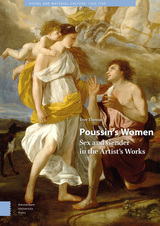 Poussin's Women: Sex and Gender in the Artist's Works
Troy Thomas
Amsterdam University Press, 2020 Poussin’s Women: Sex and Gender in the Artist’s Works examines the paintings and drawings of the well-known seventeenth-century French painter Nicolas Poussin (1594-1665) from a gender studies perspective, focusing on a critical analysis of his representations of women. The book’s thematic chapters investigate Poussin’s women in their roles as predators, as lustful or the objects of lust, as lovers, killers, victims, heroines, or models of virtue. Poussin’s paintings reflect issues of gender within his social situation as he consciously or unconsciously articulated its conflicts and assumptions. A gender studies approach brings to light new critical insights that illuminate how the artist represented women, both positively and negatively, within the framework in his seventeenth-century culture. This book covers the artist’s works from Classical mythology, Roman history, Tasso, and the Bible. It serves as a good overview of Poussin as an artist, discussing the latest research and including new interpretations of his major works.
 Poverty and Antitheatricality: Form and Formlessness in Latin American Literature, Art, and Theory
Stephen Buttes
Rutgers University Press, 2025 Poverty and Antitheatricality argues that many major analytical approaches today misunderstand the problem of poverty by emphasizing its status as an experience. These experiential models transform poverty from a specific socioeconomic status lived in a particular historical sequence into a transhistorical presence of marginality that is not only inevitable but necessary. Embedded in capitalist, socialist, and populist forms of socioeconomic organization, these models paradoxically suggest that if we want to have a world free of poverty, we must always have the poor and their experience of formlessness. Taking up the paired terms—form and formlessness—Stephen Buttes demonstrates how they sustain not only debates about poverty and its political role within modernity but also the idea of the work of art within the history of modernism. Offering critiques of critical theory alongside new readings of both canonical and little-studied Latin American authors and artists, Poverty and Antitheatricality makes a compelling case that understanding the kind of problem the work of art is opens up overlooked but essential pathways to understanding poverty and the kind of problem it is.
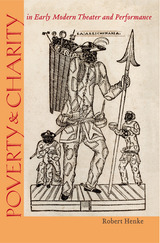 Poverty and Charity in Early Modern Theater and Performance
Robert Henke
University of Iowa Press, 2015 Whereas previous studies of poverty and early modern theatre have concentrated on England and the criminal rogue, Poverty and Charity in Early Modern Theatre and Performance takes a transnational approach, which reveals a greater range of attitudes and charitable practices regarding the poor than state poor laws and rogue books suggest. Close study of German and Latin beggar catalogues, popular songs performed in Italian piazzas, the Paduan actor-playwright Ruzante, the commedia dell’arte in both Italy and France, and Shakespeare demonstrate how early modern theatre and performance could reveal the gap between official policy and actual practices regarding the poor.
The actor-based theatre and performance traditions examined in this study, which persistently explore felt connections between the itinerant actor and the vagabond beggar, evoke the poor through complex and variegated forms of imagination, thought, and feeling. Early modern theatre does not simply reflect the social ills of hunger, poverty, and degradation, but works them through the forms of poverty, involving displacement, condensation, exaggeration, projection, fictionalization, and marginalization. As the critical mass of medieval charity was put into question, the beggar-almsgiver encounter became more like a performance. But it was not a performance whose script was prewritten as the inevitable exposure of the dissembling beggar. Just as people’s attitudes toward the poor could rapidly change from skepticism to sympathy during famines and times of acute need, fictions of performance such as Edgar’s dazzling impersonation of a mad beggar in Shakespeare’s King Lear could prompt responses of sympathy and even radical calls for economic redistribution.
Poverty and Inequality
Edited by Chris Jones and Tony Novak
Bristol University Press, 2014 Many agree that neoliberal economic policies have led to growing class inequality and increasing levels of poverty. Investigating the challenges that the growing financial and class disparity poses for the engaged social work academic and practitioner, the contributors look at the current state of poverty and inequality in a number of countries and examine social work’s response to it. They argue that—especially for a profession committed to values based on equality, social justice, and the meeting of human needs—poverty imposes a special requirement on social workers and academics to speak out when policies don’t work and the plight of the impoverished is exacerbated.
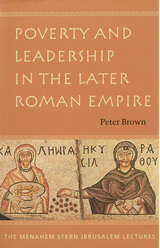 Poverty and Leadership in the Later Roman Empire
Peter Brown
Brandeis University Press, 2001 In three magisterial essays, Peter Brown, one of the world's foremost scholars of the society and culture of late antiquity, explores the emergence in late Roman society of "the poor" as a distinct social class, one for which the Christian church claimed a special responsibility. It is the story of how a society came to see itself as responsible for the care of a particular class of people -- a class that had not previously been cared for -- and of who benefited from that shift in interests. In his characteristically elegant and lucid prose, Brown seeks to recover the pre-Christian status of poor people, the actual nature of the relations between the Christian church and the poor, and the true motivations -- sometimes sincere, sometimes self-serving -- behind Christian rhetoric of love for the poor. He draws not only on the standard Greek and Latin sources for the later Roman Empire, but also on Jewish sources to document the interactions between Middle Eastern provincial societies and classical Roman traditions. Brown gracefully illuminates a crucial transition from classical to Christian culture: the emergence of a new understanding of what society -- and the Church -- owes to the poor that continues to resonate.
Poverty and Neoliberalism: Persistence and Reproduction in the Global South
Ray Bush
Pluto Press, 2007 Why do so many people worldwide suffer hunger and poverty when there is enough food and other resources globally to prevent it? This book shows how famine and food insecurity are an essential part of modern capitalism. Although trade, debt relief and development initiatives are important, they do not alter the structure of the global economy and the poverty that is created by processes like privatisation, trade liberalisation and market reform.
Despite the rhetoric of the World Bank and the G8, high levels of poverty actually sustain western wealth and power. But there is some hope for change. Using case studies from Egypt and North Africa, Nigeria, Sudan and elsewhere in sub-Saharan Africa, Ray Bush illustrates that there is resistance to neoliberal policies, and that struggles over land, mining and resources can shape real alternatives to existing globalisation.
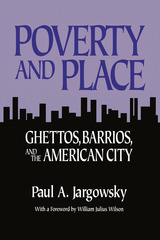 Poverty and Place: Ghettos, Barrios, and the American City
Paul A. Jargowsky
Russell Sage Foundation, 1997 "[An] alarming report, a rigorous study packed with charts, tables, 1990 census data and [Jargowsky's] own extensive field work.... His careful analysis of enterprise zones, job-creation strategies, local economic development schemes and housing and tax policies rounds out an essential handbook for policy makers, a major contribution to public debate over ways to reverse indigence." —Publishers Weekly "A data-rich description and a conceptually innovative explanation of the spread of neighborhood poverty in the United States between 1970 and 1990. Urban scholars and policymakers alike should find Jargowsky's compelling arguments thought-provoking. "—Library Journal "A powerful book that allows us to really understand how ghettos have been changing over time and the forces behind these changes. It should be required reading of anyone who cares about urban poverty." —David Ellwood, Malcolm Wiener Professor of Public Policy, John F. Kennedy School of Government, Harvard University Poverty and Place documents the geographic spread of the nation's ghettos and shows how economic shifts have had a particularly devastating impact on certain regions, particularly in the rust-belt states of the Midwest. Author Paul Jargowsky's thoughtful analysis of the causes of ghetto formation clarifies the importance of widespread urban trends, particularly those changes in the labor and housing markets that have fostered income inequality and segregated the rich from the poor. Jargowsky also examines the sources of employment that do exist for ghetto dwellers, and describes how education and family structure further limit their prospects. Poverty and Place shows how the spread of high poverty neighborhoods has particularly trapped members of poor minorities, who account for nearly four out of five ghetto residents. Poverty and Place sets forth the facts necessary to inform the public understanding of the growth of concentrated poverty, and confronts essential questions about how the spiral of urban decay in our nation's cities can be reversed.
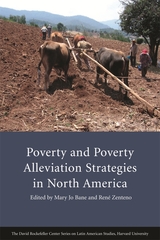 Poverty and Poverty Alleviation Strategies in North America
Mary Jo Bane
Harvard University Press This book is a dialogue about poverty in North America, especially in Mexico and the United States. Poverty has different roots and different manifestations, and requires different responses, whether in the Mississippi delta, in Native American reservations, among single-parent families in inner cities, or in Mexico’s rural southern states and in its urban areas.
In this book, twelve poverty scholars in Mexico and the United States contribute to the understanding of the roots of poverty and build knowledge about effective policy alleviation strategies. After setting the context of poverty and place in North America, the book focuses on three areas of policy response: macroeconomic policy, education policy, and safety nets. Within each section, the authors explore the dimensions of the poverty problem and alternative responses. A final chapter by the editors—from the United States and from Mexico—raises provocative questions about poverty in North America as a whole.
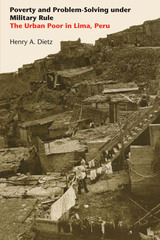 Poverty and Problem-Solving under Military Rule: The Urban Poor in Lima, Peru
By Henry A. Dietz
University of Texas Press, 1980 Many countries in Latin America have experienced both rapid urbanization and military involvement in politics. Yet few studies examine how military regimes react to the political pressures that wide-spread urban poverty creates or how the poor operate under authoritative rule. Henry Dietz investigates Lima’s poor during the “revolution” of General Juan Velasco (1968–1975). His study examines both the structural conditions promoting poverty and the individual consequences of being poor. The poor join together in several ways to resolve politicized communal needs; Dietz’s data indicate that the local neighborhood plays a crucial role in determining modes of involvement. Considerable attention is given to government attempts to encourage and control political activities by the poor. Dietz analyzes the failure of SINAMOS, the regime’s mobilization agency, and in so doing raises general questions about corporatist solutions to social problems. The wide range of original survey, informant, and ethnographic data provides much new information on elite-mass relationships in contemporary Latin America. Dietz’s research illuminates much that is of concern to scholars and planners dealing with urbanization, poverty, and social policy formation.
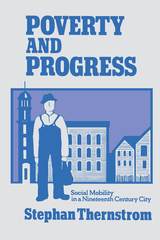 Poverty and Progress: Social Mobility in a Nineteenth Century City
Stephan Thernstrom
Harvard University Press, 1964 Embedded in the consciousness of Americans throughout much of the country’s history has been the American Dream: that every citizen, no matter how humble his beginnings, is free to climb to the top of the social and economic ladder. Poverty and Progress assesses the claims of the American Dream against the actual structure of economic and social opportunities in a typical nineteenth century industrial community—Newburyport, Massachusetts.
Here is local history. With the aid of newspapers, census reports, and local tax, school, and savings bank records Stephan Thernstrom constructs a detailed and vivid portrait of working class life in Newburyport from 1850 to 1880, the critical years in which this old New England town was transformed into a booming industrial city. To determine how many self-made men there really were in the community, he traces the career patterns of hundreds of obscure laborers and their sons over this thirty year period, exploring in depth the differing mobility patterns of native-born and Irish immigrant workmen. Out of this analysis emerges the conclusion that opportunities for occupational mobility were distinctly limited. Common laborers and their sons were rarely able to attain middle class status, although many rose from unskilled to semiskilled or skilled occupations.
But another kind of mobility was widespread. Men who remained in lowly laboring jobs were often strikingly successful in accumulating savings and purchasing homes and a plot of land. As a result, the working class was more easily integrated into the community; a new basis for social stability was produced which offset the disruptive influences that accompanied the first shock of urbanization and industrialization.
Since Newburyport underwent changes common to other American cities, Thernstrom argues, his findings help to illuminate the social history of nineteenth century America and provide a new point of departure for gauging mobility trends in our society today. Correlating the Newburyport evidence with comparable studies of twentieth century cities, he refutes the popular belief that it is now more difficult to rise from the bottom of the social ladder than it was in the idyllic past. The “blocked mobility” theory was proposed by Lloyd Warner in his famous “Yankee City” studies of Newburyport; Thernstrom provides a thorough critique of the “Yankee City” volumes and of the ahistorical style of social research which they embody.
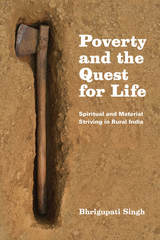 Poverty and the Quest for Life: Spiritual and Material Striving in Rural India
Bhrigupati Singh
University of Chicago Press, 2015 The Indian subdistrict of Shahabad, located in the dwindling forests of the southeastern tip of Rajasthan, is an area of extreme poverty. Beset by droughts and food shortages in recent years, it is the home of the Sahariyas, former bonded laborers, officially classified as Rajasthan’s only “primitive tribe.” From afar, we might consider this the bleakest of the bleak, but in Poverty and the Quest for Life, Bhrigupati Singh asks us to reconsider just what quality of life means. He shows how the Sahariyas conceive of aspiration, advancement, and vitality in both material and spiritual terms, and how such bridging can engender new possibilities of life.
Singh organizes his study around two themes: power and ethics, through which he explores a complex terrain of material and spiritual forces. Authority remains contested, whether in divine or human forms; the state is both despised and desired; high and low castes negotiate new ways of living together, in conflict but also cooperation; new gods move across rival social groups; animals and plants leave their tracks on human subjectivity and religiosity; and the potential for vitality persists even as natural resources steadily disappear. Studying this milieu, Singh offers new ways of thinking beyond the religion-secularism and nature-culture dichotomies, juxtaposing questions about quality of life with political theologies of sovereignty, neighborliness, and ethics, in the process painting a rich portrait of perseverance and fragility in contemporary rural India.
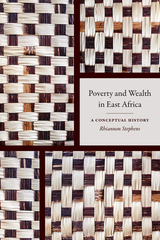 Poverty and Wealth in East Africa: A Conceptual History
Rhiannon Stephens
Duke University Press, 2022 In Poverty and Wealth in East Africa Rhiannon Stephens offers a conceptual history of how people living in eastern Uganda have sustained and changed their ways of thinking about wealth and poverty over the past two thousand years. This history serves as a powerful reminder that colonialism and capitalism did not introduce economic thought to this region and demonstrates that even in contexts of relative material equality between households, people invested intellectual energy in creating new ways to talk about the poor and the rich. Stephens uses an interdisciplinary approach to write this history for societies without written records before the nineteenth century. She reconstructs the words people spoke in different eras using the methods of comparative historical linguistics, overlaid with evidence from archaeology, climate science, oral traditions, and ethnography. Demonstrating the dynamism of people’s thinking about poverty and wealth in East Africa long before colonial conquest, Stephens challenges much of the received wisdom about the nature and existence of economic and social inequality in the region’s deeper past.
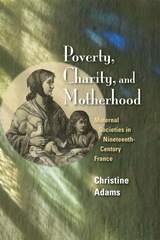 Poverty, Charity, and Motherhood: Maternal Societies in Nineteenth-Century France
Christine Adams
University of Illinois Press, 2010 This far-reaching study of maternal societies in post-revolutionary France focuses on the philanthropic work of the Society for Maternal Charity, the most prominent organization of its kind. Administered by middle-class and elite women and financed by powerful families and the government, the Society offered support to poor mothers, helping them to nurse and encouraging them not to abandon their children. In Poverty, Charity, and Motherhood, Christine Adams traces the Society's key role in shaping notions of maternity and in shifting the care of poor families from the hands of charitable volunteers with religious-tinged social visions to paid welfare workers with secular goals such as population growth and patriotism. Adams plumbs the origin and ideology of the Society and its branches, showing how elite women in Paris, Lyon, Bordeaux, Rouen, Marseille, Dijon, and Limoges tried to influence the maternal behavior of women and families with lesser financial means and social status. A deft analysis of the philosophy and goals of the Society details the members' own notions of good mothering, family solidarity, and legitimate marriages that structured official, elite, and popular attitudes concerning gender and poverty in France. These personal attitudes, Adams argues, greatly influenced public policy and shaped the country's burgeoning social welfare system.
Poverty Creek Journal
Thomas Gardner
Tupelo Press, 2014 That rush in between when it all comes undone. Knowing its edge like your own pulse and breathing. As I knew them this morning, racing a 10K in late-spring heat, the taste of panic in the last two miles as everything slipped away, losing time and barely finishing. A tingling in my limbs as if I were driving on ice, the road beneath me suddenly gone, the feeling of that in my hands. Deeper than words, being lost for a moment and then being done. Left with a pounding, stiff-legged stagger. Spiritual improvisations, radiant acts of attention: echoing Thoreau's Walden, the meditations of Guy Davenport, and Kenny Moore's groundbreaking articles for Sports Illustrated, Thomas Gardner strides through inner and outer landscapes. Freed by disciplined effort, the runner's mind here roams and mourns and remembers.
Poverty, Equality, and Growth: The Politics of Economic Need in Postwar Japan
Deborah J. Milly
Harvard University Press, 1999 In striking contrast to the large indigent population in Japan in the 1950s, very few Japanese live in poverty today. This book explains the Japanese government's decision to respond to poverty by promoting equality as the basis for a social compromise. Milly argues that to account for why and how political actors crafted a program that won acceptance, we must look beyond them and identify how they relied on knowledge and normative arguments. This book straddles theoretical fault lines in comparative politics by exploring the interactions among choice, language, knowledge, and institutions in policy processes, and has implications for the ongoing debate between proponents of rational choice theory as a universal explanation for the decisions of political actors and those who focus on historically or culturally specific conditions.
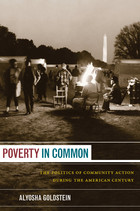 Poverty in Common: The Politics of Community Action during the American Century
Alyosha Goldstein
Duke University Press, 2012 After the Second World War, the idea that local community action was indispensable for the alleviation of poverty was broadly embraced by US policymakers, social scientists, international development specialists, and grassroots activists. Governmental efforts to mobilize community action in the name of democracy served as a volatile condition of possibility for poor people and dispossessed groups negotiating the tension between calls for self-help and demands for self-determination in the era of the Cold War and global decolonization. In Poverty in Common, Alyosha Goldstein suggests new ways to think about the relationship among liberalism, government, and inequality in the United States. He does so by analyzing historical dynamics including Progressive-era reform as a precursor to community development during the Cold War, the ways that the language of "underdevelopment" articulated ideas about poverty and foreignness, the use of poverty as a crucible of interest group politics, and radical groups' critical reframing of community action in anticolonial terms. During the mid-twentieth century, approaches to poverty in the United States were linked to the racialized and gendered negotiation of boundaries—between the foreign and the domestic, empire and nation, violence and order, and dependency and autonomy.
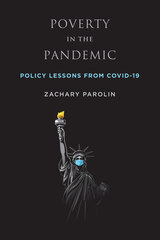 Poverty in the Pandemic: Policy Lessons from COVID-19
Zachary Parolin
Russell Sage Foundation, 2023 At the close of 2019, the United States saw a record-low poverty rate. At the start of 2020, the COVID-19 pandemic threatened to upend that trend and plunge millions of Americans into poverty. However, despite the highest unemployment rate since the Great Depression, the poverty rate declined to the lowest in modern U.S. history. In Poverty in the Pandemic social policy scholar Zachary Parolin provides a data-driven account of how poverty influenced the economic, social, and health consequences of the COVID-19 pandemic in the U.S., as well as how the country’s policy response led to historically low poverty rates.
Drawing on dozens of data sources ranging from debit and credit card spending, the first national databases of school and childcare center closures in the U.S., and bi-weekly Census-run surveys on well-being, Parolin finds that entering the pandemic in poverty substantially increased a person’s likelihood of experiencing negative health outcomes due to the pandemic, such as contracting and dying from COVID, as well as losing their job. Additionally, he found that students from poor families suffered the greatest learning losses as a result of school closures and the shift to distance learning during the pandemic.
However, unprecedented legislative action by the U.S. government, including the passage of the Families First Coronavirus Response Act (FFCRA), the Coronavirus Aid, Relief, and Economic Security (CARES) Act, and the American Rescue Plan (ARP) helped mitigate the economic consequences of the pandemic and lifted around 18 million Americans out of poverty. Based on the success of these policies, Parolin concludes with policy suggestions that the U.S. can implement in more ‘normal’ times to improve the living conditions of low-income households after the pandemic subsides, including expanding access to Unemployment Insurance, permanently expanding the Child Tax Credit, promoting greater access to affordable, high-quality healthcare coverage, and investing more resources into the Census Bureau’s data-collection capabilities. He also details a method of producing a monthly measurement of poverty, to be used in conjunction with the traditional annual measurement, in order to better understand the intra-year volatility of poverty that many Americans experience.
Poverty in the Pandemic provides the most complete account to date of the unique challenges that low-income households in the U.S. faced during the COVID-19 pandemic.
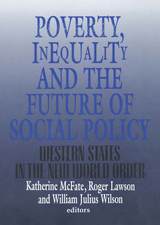 Poverty, Inequality, and the Future of Social Policy: Western States in the New World Order
Katherine McFate
Russell Sage Foundation, 1995 "Extremely coherent and useful, this much needed volume is concerned with the current status of the poor in Western industrial states. Its closely linked essays allow comparisons between case studies and are often themselves cross-national comparisons....The essays also comment on the meaning of globalization for social policy." —Choice "Excellent and tightly integrated articles by a group of prominent international scholars....A timely and important book, which will surely become the basic reference point for all future research on inequality and social policy." —Contemporary Sociology The social safety net is under strain in all Western nations, as social and economic change has created problems that traditional welfare systems were not designed to handle. Poverty, Inequality, and the Future of Social Policy provides a definitive analysis of the conditions that are fraying the social fabric and the reasons why some countries have been more successful than others in addressing these trends. In the United States, where the poverty rate in the 1980s was twice that of any advanced nation in Europe, the social protection system—and public support for it—has eroded alarmingly. In Europe, the welfare system more effectively buffered the disadvantaged, but social expenditures have been indicted by many as the principal cause of high unemployment. Concluding chapters review the progress and goals of social welfare programs, assess their viability in the face of creeping economic, racial, and social fragmentation, and define the challenges that face those concerned with social cohesion and economic prosperity in the new global economy. This volume illuminates the disparate effects of government intervention on the incidence and duration of poverty in Western countries. Poverty, Inequality, and the Future of Social Policy is full of lessons for anyone who would look beyond the limitations of the welfare debate in the United States.
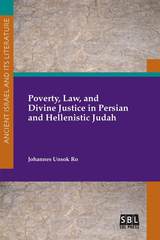 Poverty, Law, and Divine Justice in Persian and Hellenistic Judah
Johannes Unsok Ro
SBL Press, 2018 A view of Persian and Hellenistic Judean communities through theological and socioeconomic lenses
Johannes Unsok Ro employs philological, historical, and sociological approaches to investigate the close connections between socioeconomic structures, social inequality, and theological developments in the Judean communities in Persian- and Hellenistic-era Palestine. Ro contends that competing points of view from communities of lay returnees, priestly returnees, and communities of resident Judeans and Samaritans were juxtaposed within the Hebrew Bible, which took shape during the postexilic period. By exploring issues such as the relationship between the shaping of the canon and literacy in the Judean community, the term strangers in the biblical law codes, the socioeconomic structures of Judean communities reflected in the biblical law codes, the development of the theological concept of divine punitive justice, the piety of the poor in certain psalms, and the concept of poverty in the Dead Sea Scrolls, Ro illustrates that the communities behind each text and its redactions can be ascertained through sociological and theological lenses.
Features
- Demonstration that a theology of the poor materialized orally among the poor but found written expression among Levites
- Insight into the socioeconomic and theological concerns of the authorial groups behind various biblical law codes
- A case that biblical “poverty” sometimes refers to humility and a theologically reflected consciousness of lowliness toward God
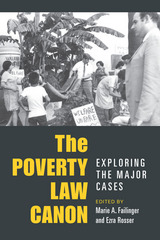 The Poverty Law Canon: Exploring the Major Cases
Marie A. Failinger and Ezra Rosser, Editors
University of Michigan Press, 2016 The Poverty Law Canon takes readers into the lives of the clients and lawyers who brought critical poverty law cases in the United States. These cases involved attempts to establish the right to basic necessities, as well as efforts to ensure dignified treatment of welfare recipients and to halt administrative attacks on federal program benefit levels. They also confronted government efforts to constrict access to justice, due process, and rights to counsel in child support and consumer cases, social welfare programs, and public housing. By exploring the personal narratives that gave rise to these lawsuits as well as the behind-the-scenes dynamics of the Supreme Court, the text locates these cases within the social dynamics that shaped the course of litigation.
Noted legal scholars explain the legal precedent created by each case and set the case within its historical and political context in a way that will assist students and advocates in poverty-related disciplines in their understanding of the implications of these cases for contemporary public policy decisions in poverty programs. Whether the focus is on the clients, on the lawyers, or on the justices, the stories in The Poverty Law Canon illuminate the central legal themes in federal poverty law of the late 20th century and the role that racial and economic stereotyping plays in shaping American law.
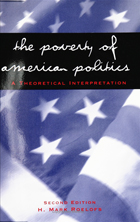 Poverty Of Amer Pol 2Nd Ed
H. Mark Roelofs
Temple University Press, 1998 Maintaining that the American political system is not working well enough to inspire confidence that it can meet the challenges o four time, H. Mark Roelofs attributes that failure, not to its practitioners, but to its very design. He sees that system as split between its legitimizing self-image, social democracy, and its operational element, liberal democracy.
Based on his novel understanding of the American political system, Roelofs presents a devastating and closely reasoned critique that traces our nation's political ills to fundamental flaws in the very design of its founding principles, the character of its major institutions, and the basic pattern of its processes. Dissecting our political and societal problems, he explains the limitations and basic contributions arising from the social democratic/liberal democratic dichotomy that result in our current political poverty.
While Roelofs's analysis remains the same as in the earlier edition, in this revised edition he has sharpened and extended the argument and expanded and updated his illustrative materials. Improved bibliographical citations and new diagrams make the book an even more useful teaching tool.
 The Poverty of Capitalism: Economic Meltdown and the Struggle for What Comes Next
John Hilary
Pluto Press, 2013 Capitalist growth is widely heralded as the only answer to the crisis still sweeping the global economy. Yet the era of corporate globalisation has been defined by unprecedented levels of inequality and environmental degradation. A return to capitalist growth threatens to exacerbate these problems, not solve them.
In The Poverty of Capitalism, John Hilary reveals the true face of transnational capital in its insatiable drive for expansion and accumulation. He exposes the myth of ‘corporate social responsibility’ (CSR), and highlights key areas of conflict over natural resources, labour rights and food sovereignty.
Hilary also describes the growing popular resistance to corporate power, as well as the new social movements seeking to develop alternatives to capitalism itself. This book will be essential reading for all those concerned with global justice, human rights and equity in the world order.
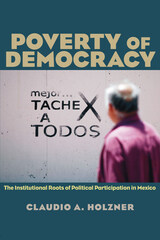 Poverty of Democracy: The Institutional Roots of Political Participation in Mexico
Claudio A. Holzner
University of Pittsburgh Press, 2010
Political participation rates have declined steadily in Mexico since the 1990s. The decline has been most severe among the poor, producing a stratified pattern that more and more mirrors Mexico’s severe socioeconomic inequalities. Poverty of Democracy examines the political marginalization of Mexico’s poor despite their key role in the struggle for democracy.
Claudio A. Holzner uses case study evidence drawn from eight years of fieldwork in Oaxaca, and from national surveys to show how the institutionalization of a free-market democracy created a political system that discourages the political participation of Mexico’s poor by limiting their access to politicians at the local and national level. Though clean elections bolster political activity, Holzner shows that at the local level, and particularly in Mexico’s poorest regions, deeply rooted enclaves of authoritarianism and clientelism still constrict people’s political opportunities.
To explain this phenomenon, Holzner develops an institutional theory in which party systems, state-society linkages, and public policies are the key determinants of citizen political activity. These institutions shape patterns of political participation by conferring and distributing resources, motivating or discouraging an interest in politics, and by affecting the incentives citizens from different income groups have for targeting the state with political activity.
Holzner’s study sheds light on a disturbing trend in Latin America (and globally), in which neoliberal systems exacerbate political and economic disparities and create institutions that translate economic inequalities into political ones.
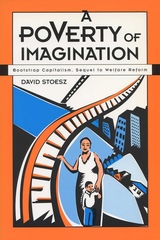 A Poverty of Imagination: Bootstrap Capitalism, Sequel to Welfare Reform
David Stoesz
University of Wisconsin Press, 2000 Welfare reform was supposed to end welfare as we know it. And it has. The welfare poor have been largely transformed into the working poor, but their poverty persists. This hard-hitting book takes a close look at where we’ve gone wrong—and where we might go next if we truly want to improve the lot of America’s underclass.
Tracing the roots of recent reforms to the early days of the war on poverty, A Poverty of Imagination describes a social welfare system grown increasingly inept, corrupt, and susceptible to conservative redesign. Investigating the causes of the ongoing failure of welfare assistance, Stoesz focuses on the economic barriers that impede movement out of poverty into the American mainstream. He explores such issues as the heterogeneity of welfare families, generational welfare, inadequate benefits, the negative effects of time limits on welfare recipients, a fringe banking industry that exploits low-income families, the limited capacity of low-wage markets, and the unavailability of credit.
Stoesz suggests that a form of "bootstrap capitalism" would allow individuals and families to participate more fully in American society and achieve upward economic mobility and stability. This proposal, emphasizing wage supplements, asset building, and community capitalism, sets the stage for the next act in poverty policy in the United States. With its valuable insights on the American welfare system and its positive agenda for change, this book makes a significant intervention in our ongoing struggle to come to terms with widespread poverty in the wealthiest nation on earth.
Poverty of the Imagination: Nineteenth-Century Russian Literature about the Po
David Herman
Northwestern University Press, 2001 The primal scene of all nineteenth-century western thought might involve an observer gazing at someone poor, most commonly on the streets of a great metropolis, and wondering what the spectacle meant in human, moral, political, and metaphysical terms. For Russia, most of whose people hovered near the poverty line throughout history, the scene is one of special significance, presenting a plethora of questions and possibilities for writers who wished to depict the spiritual and material reality of Russian life. How these writers responded, and what their portrayal of poverty reveals and articulates about core values of Russian culture, is the subject of this book, which offers a compelling look into the peculiar convergence in nineteenth-century Russian literature of ideas about the poor and about the processes of art.
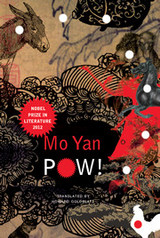 POW!
Mo Yan
Seagull Books, 2012 In this novel by the 2012 Nobel Laureate in Literature, Mo Yan, a benign old monk listens to a prospective novice’s tale of depravity, violence, and carnivorous excess while a nice little family drama—in which nearly everyone dies—unfurls. But in this tale of sharp hatchets, bad water, and a rusty WWII mortar, we can’t help but laugh. Reminiscent of the novels of dark masters of European absurdism like Günter Grass, Witold Gombrowicz, or Jakov Lind, Mo Yan’s POW! is a comic masterpiece.
In this bizarre romp through the Chinese countryside, the author treats us to a cornucopia of cooked animal flesh—ostrich, camel, donkey, dog, as well as the more common varieties. As his dual narratives merge and feather into one another, each informing and illuminating the other, Mo Yan probes the character and lifestyle of modern China. Displaying his many talents, as fabulist, storyteller, scatologist, master of allusion and cliché, and more, POW! carries the reader along quickly, hungrily, and giddily, up until its surprising dénouement.
Mo Yan has been called one of the great novelists of modern Chinese literature and the New York Times Book Review has hailed his work as harsh and gritty, raunchy and funny. He writes big, sometimes mystifying, sometimes infuriating, but always entertaining novels—and POW! is no exception.
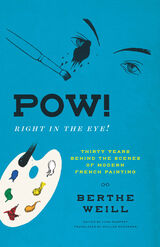 Pow! Right in the Eye!: Thirty Years behind the Scenes of Modern French Painting
Berthe Weill
University of Chicago Press, 2022 Memoir of a provocative Parisian art dealer at the heart of the 20th-century art world, available in English for the first time.
Berthe Weill, a formidable Parisian dealer, was born into a Jewish family of very modest means. One of the first female gallerists in the business, she first opened the Galerie B. Weill in the heart of Paris’s art gallery district in 1901, holding innumerable exhibitions over nearly forty years. Written out of art history for decades, Weill has only recently regained the recognition she deserves.
Under five feet tall and bespectacled, Weill was beloved by the artists she supported, and she rejected the exploitative business practices common among art dealers. Despite being a self-proclaimed “terrible businesswoman,” Weill kept her gallery open for four decades, defying the rising tide of antisemitism before Germany’s occupation of France. By the time of her death in 1951, Weill had promoted more than three hundred artists—including Henri Matisse, Pablo Picasso, Amedeo Modigliani, Diego Rivera, and Suzanne Valadon—many of whom were women and nearly all young and unknown when she first exhibited them.
Pow! Right in the Eye! makes Weill’s provocative 1933 memoir finally available to English readers, offering rare insights into the Parisian avant-garde and a lively inside account of the development of the modern art market.
 The Powell Expedition: New Discoveries about John Wesley Powell's 1869 River Journey
Don Lago
University of Nevada Press, 2017 John Wesley Powell’s 1869 expedition down the Green and Colorado Rivers and through the Grand Canyon continues to be one of the most celebrated adventures in American history, ranking with the Lewis and Clark expedition and the Apollo landings on the moon. For nearly twenty years Lago has researched the Powell expedition from new angles, traveled to thirteen states, and looked into archives and other sources no one else has searched. He has come up with many important new documents that change and expand our basic understanding of the expedition by looking into Powell’s crewmembers, some of whom have been almost entirely ignored by Powell historians. Historians tended to assume that Powell was the whole story and that his crewmembers were irrelevant. More seriously, because several crew members made critical comments about Powell and his leadership, historians who admired Powell were eager to ignore and discredit them.
Lago offers a feast of new and important material about the river trip, and it will significantly rewrite the story of Powell’s famous expedition. This book is not only a major work on the Powell expedition, but on the history of American exploration of the West.
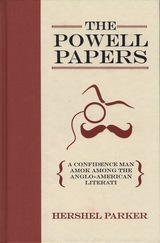 The Powell Papers: A Confidence Man Amok Among the Anglo-American Literati
Hershel Parker
Northwestern University Press, 2011 In 1849—months before the term “confidence man” was coined to identify a New York crook—Thomas Powell (1809–1887), a spherical, monocled, English poetaster, dramatist, journalist, embezzler, and forger, landed in Manhattan. Powell in London had capped a career of grand theft and literary peccadilloes by feigning a suicide attempt and having himself committed to a madhouse, after which he fled England. He had been an intimate of William Wordsworth, Elizabeth Barrett, Robert Browning, Charles Dickens, and a crowd of lesser literary folk.
Thoughtfully bearing what he presented as a volume of Tennyson with a few trifling revisions in the hand of the poet, Powell was embraced by the slavishly Anglophile New York literary establishment, including a young Herman Melville. In two pot-boilers—The Living Authors of England (1849) and The Living Authors of America (1850)—Powell denounced the most revered American author, Washington Irving, for plagiarism; provoked Charles Dickens to vengeful trans-Atlantic outrage and then panic; and capped his insolence by identified Irving and Melville as the two worst “enemies of the American mind.” For almost four more decades he sniped at Dickens, put words in Melville’s mouth, and survived even the most conscientious efforts to expose him. Long fascinated by this incorrigible rogue, Hershel Parker in The Powell Papers uses a few familiar documents and a mass of freshly discovered material (including a devastating portrait of Powell in a serialized novel) to unfold a captivating tale of skullduggery through the words of great artists and then-admired journalists alike.
Power
Keith Dowding
University of Minnesota Press, 1996
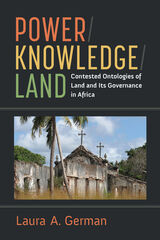 Power / Knowledge / Land: Contested Ontologies of Land and Its Governance in Africa
Laura A. German
University of Michigan Press, 2022 The 2008 outcry over the “global land grab” made headlines around the world, leading to a sustained interest in the dynamics and fate of customary land among both academics and development practitioners. In Power/Knowledge/Land, author Laura German profiles the consolidation of a global knowledge regime surrounding land and its governance within international development circles in the decade following this outcry, and the growing enrollment of previously antagonistic actors within it. Drawing theoretical insights on the inseparability of power and knowledge, German reveals the dynamics of knowledge practices that have enabled the longstanding project of commodifying customary land – and the more contemporary interests in acquiring and financializing it – to be advanced and legitimated by capturing the energies of socially progressive forces. By bringing theories of change from the emergent land governance orthodoxy into dialogue with the ethnographic evidence from across the African continent and beyond, concepts masquerading as universal and self-evident truths are provincialized, and their role in commodifying customary land and entrenching colonial futurities put on display. In doing so, the volume brings wider academic debates surrounding productive forms of power into the heart of the land grab debate, while enhancing their accessibility to a wider audience.
Power/Knowledge/Land takes current scholarly debates surrounding land grabs beyond their theoretical moorings in critical agrarian studies, political economy and globalization into contemporary debates surrounding the politics of knowledge—from theories of coloniality to ontological anthropology, thereby enabling new dynamics of the phenomenon to be revealed. The book deploys a pioneering epistemology integrating deconstructionist approaches (to reveal the tactics, truth claims and ontological assumptions of global knowledge brokers), with systematic qualitative reviews and comparative study (to contrast these dominant constructs with the evidence and reveal alternative ways of knowing “land” and practicing “security” from the ethnographic literature). This helps to reveal the Western and modernist biases in the narratives that have been advanced about women, custom, and security, revealing how the coloniality of knowledge works to grease the wheels of land takings by advancing highly provincialized constructs aligned with western interests as universal truths.
Power & Persuasion Late Antiquity: Towards A Christian Empire
Peter Brown
University of Wisconsin Press, 1992 Peter Brown, perhaps the greatest living authority on Mediterranean civilization in late antiquity, traces the growing power of Christian bishops as they wrested influence from philosophers, who had traditionally advised the rulers of Graeco-Roman society. In the new “Christian empire,” the ancient bonds of citizen to citizen and of each city to its benefactors were replaced by a common Christianity and common loyalty to a distant, Christian autocrat. This transformation of the Roman empire from an ancient to a medieval society, he argues, is among the most far-reaching consequences of the rise of Christianity.
 Power after Carbon: Building a Clean, Resilient Grid
Peter Fox-Penner
Harvard University Press, 2020 As the electric power industry faces the challenges of climate change, technological disruption, new market imperatives, and changing policies, a renowned energy expert offers a roadmap to the future of this essential sector.
As the damaging and costly impacts of climate change increase, the rapid development of sustainable energy has taken on great urgency. The electricity industry has responded with necessary but wrenching shifts toward renewables, even as it faces unprecedented challenges and disruption brought on by new technologies, new competitors, and policy changes. The result is a collision course between a grid that must provide abundant, secure, flexible, and affordable power, and an industry facing enormous demands for power and rapid, systemic change.
The fashionable solution is to think small: smart buildings, small-scale renewables, and locally distributed green energy. But Peter Fox-Penner makes clear that these will not be enough to meet our increasing needs for electricity. He points instead to the indispensability of large power systems, battery storage, and scalable carbon-free power technologies, along with the grids and markets that will integrate them. The electric power industry and its regulators will have to provide all of these, even as they grapple with changing business models for local electric utilities, political instability, and technological change. Power after Carbon makes sense of all the moving parts, providing actionable recommendations for anyone involved with or relying on the electric power system.
Power and Compassion: On Moral Force Ethics and Historical Change
Bennett Gilbert
Amsterdam University Press, 2025 This book presents a theory of the morality of human relations deeply drawn from widespread spiritual traditions, offering an account of the full range of sociality that comprises our moral life. Bennett Gilbert argues that the dynamic character of our choices and actions is developed as the center of philosophical inquiry into ethics. Relying on the tradition of philosophical personalism, the author reads moral life in terms of the central worth and value of human personhood. This fully relational concept supports a picture of the clash and cooperation of two great moral forces, power and compassion. By combining hermeneutics, first-person philosophy, moral philosophy, and existential philosophy of history, Power and Compassion is a philosophical exploration of the ways in which we use our moral force to create meaningfulness in our collective experience.
 Power and Culture: The Japanese–American War, 1941–1945
Akira Iriye
Harvard University Press, 1981 Power and Culture challenges existing assumptions about the war in the Pacific. By focusing on the interplay between culture and international relations, one of the world’s most distinguished scholars of United States–Japanese affairs offers a startling reassessment of what the war really meant to the two combatants. Akira Iriye examines the Japanese–American war for the first time from the cultural perspectives of both countries, arguing that it was more a search for international order than a ruthless pursuit of power.
His thesis is bold, for he convincingly demonstrates that throughout the war many Japanese leaders shared with their American counterparts an essentially Wilsonian vision of international cooperation. As the war drew to a close, these statesmen began to plan for a cooperative world structure that was remarkably similar to the ideas of American policymakers. Indeed, as Iriye shows, the stunning success of Japanese–American postwar relations can be understood only in the light of a deep convergence of their ideals.
Iriye has drawn his conclusions from original research, using official Japanese archives and recently declassified American documents. These offer a totally new perspective on the ways leaders in both countries actually viewed the war they were waging.
 Power and Decision: The Social Control of Reproduction
Gita Sen
Harvard University Press, 1994 This volume brings together feminist social and biomedical scholars from the Southern and Northern hemispheres to examine the aggregate forces that affect reproductive choice. Drawing on numerous case studies, this book examines the range of social, economic, and scientific policies which collectively impact on reproductive well being. Power and Decision offers an analysis of how disparate policies, seemingly unrelated to reproduction, are implicitly “pro-natalist” or “anti-natalist.” Moreover, these policies are imbued with gender, race, and class biases. The authors examine the reproductive impact of welfare and parental leave legislation, health services, adoption policies, biomedical research, the global transfer and regulation of reproductive technologies, and international family planning programs.
Offering a rare global feminist critique of social policy, this volume makes explicit the direction of current legislative, economic, and scientific trends, providing a basis for discussion, debate, and possible redress.
 Power and Elusiveness in Shelley
Oscar W. Firkins
University of Minnesota Press, 1937 Power and Elusiveness in Shelley was first published in 1937. Minnesota Archive Editions uses digital technology to make long-unavailable books once again accessible, and are published unaltered from the original University of Minnesota Press editions. This is a discussion in measured prose of the strange yet frequent union of various abstract elements in Shelley's poetry. The study contains an interesting analysis of the thesis that Shelley's "love of abstraction is only one form—probably the most obvious and the most significant form—of a larger and more general tendency." The object of this essay, in the author's words, "is to collect and combine the manifestations of this larger tendency." The two great "abstractions" that Firkins selects as the touchstones in his study he generalizes as "power" and "elusiveness," and he shows how these seemingly antithetical qualities are united in both the structure and the style of all Shelley's chief poems.
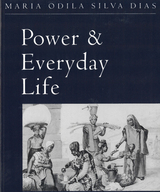 Power and Everyday Life: The Lives of Working Women in Nineteenth-Century Brazil
Dias, Maria Odila Silva
Rutgers University Press, 1995 This important new work is a study of the everyday lives of the inhabitants of São Paulo in the nineteenth century. Full of vivid detail, the book concentrates on the lives of working women--black, white, Indian, mulatta, free, freed, and slaves, and their struggles to survive. Drawing on official statistics, and on the accounts of travelers and judicial records, the author paints a lively picture of the jobs, both legal and illegal, that were performed by women. Her research leads to some surprising discoveries, including the fact that many women were the main providers for their families and that their work was crucial to the running of several urban industries. This book, which is a unique record of women’s lives across social and race strata in a multicultural society, should be of interest to students and researchers in women’s studies, urban studies, historians, geographers, economists, sociologists, and anthropologists.
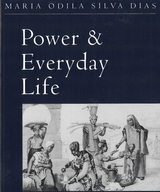 Power and Everyday Life: The Lives of Working Women in Nineteenth-Century Brazil
Dias, Maria Odila Silva
Rutgers University Press, 1995 This important new work is a study of the everyday lives of the inhabitants of São Paulo in the nineteenth century. Full of vivid detail, the book concentrates on the lives of working women--black, white, Indian, mulatta, free, freed, and slaves, and their struggles to survive. Drawing on official statistics, and on the accounts of travelers and judicial records, the author paints a lively picture of the jobs, both legal and illegal, that were performed by women. Her research leads to some surprising discoveries, including the fact that many women were the main providers for their families and that their work was crucial to the running of several urban industries. This book, which is a unique record of women’s lives across social and race strata in a multicultural society, should be of interest to students and researchers in women’s studies, urban studies, historians, geographers, economists, sociologists, and anthropologists.
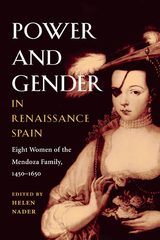 Power and Gender in Renaissance Spain: Eight Women of the Mendoza Family, 1450-1650
Edited by Helen Nader
University of Illinois Press, 2003 The Mendoza family was one of Spain's most prominent Renaissance dynasties, and this collection, a groundbreaking overview of two hundred years of Spanish history, provides in-depth portraits of eight of its female members.
These essays explore the lives of powerful women whose lineage gave them status within a patriarchal society designed to keep women from public life. Each of the influential and literary women discussed in this volume handled her status differently, and their concerns were not dissimilar from the concerns of feminists today: the blurring of the personal and the political, public versus private space, language and voice, and property.
Spanning the two centuries between Juana Pimentel, a widow who manipulated the patronage system to her own ends, and Luisa de Carvajal y Mendoza, who rejected both convent and marriage in favor of missionary work, Power and Gender in Renaissance Spain reveals a complex society in which women were limited by law, and yet their social status made those laws negotiable.
These women found that their personal agendas had a broad societal impact, challenging the laws of the land and patriarchal assumptions about women's inferiority.
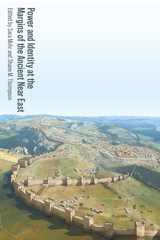 Power and Identity at the Margins of the Ancient Near East
Sara Mohr
University Press of Colorado, 2022 Power and Identity at the Margins of the Ancient Near East rethinks the dichotomy between antiquated terms such as “core” and “periphery,” explores lived realities in the margins of central authority, and centers those margins as places of resistance and power in their own right.
The borderlands of hegemonic entities within the Near East and Egypt pressed against each other, creating cities and societies with influence from several competing polities. The peoples, cities, and cultures that resulted present a unique lens by which to examine how states controlled and influenced the lives, political systems, and social hierarchies of these subjects (and vice versa). This volume addresses the distinct traditions and experiences of areas beyond the core; terminology used when discussing empire, core, periphery, borderlands, and frontiers; conceptualization of space; practices and consequences of warfare, captive-taking, and slavery; identity- and secondary state–formation; economy and society; ritual; diplomacy; and the negotiation of claims to power.
It is imperative that historians and social scientists understand the ways in which these cultures developed, spread, and interacted with others along frontier edges. Using an intersectional approach across disciplines, Power and Identity at the Margins of the Ancient Near East brings together professionals from archaeology, religious studies, history, sociology, and anthropology to make new contributions to the study of the frontier.
Contributors: Alexander Ahrens, Peter Dubovský, Avraham Faust, Daniel E. Fleming, Mahri Leonard-Fleckman, Alvise Matessi, Ellen Morris, Valeria Turriziani, Eric M. Trinka
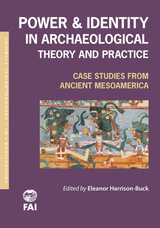 Power and Identity in Archaeological Theory and Practice: Case Studies from Ancient Mesoamerica
Eleanor Harrison-Buck
University of Utah Press, 2012 The contributions to this volume represent a diverse array of Mesoamerican archaeological studies that are all theo-retically rooted to larger, global debates concerning issues of power and identity—two logically paired concepts. While social identity has been the focus of more critical analysis in recent years, the concept of power has received far less attention. Most studies focus on large-scale, institutional forms of power and the ruling body. Here, the focus is on relations of power, addressing broader segments of society outside the dominant group, that often are ignored in traditional reconstructions of past societies. Harrison-Buck has compiled works that address a common criticism of social theory in the field of anthropological archaeology—the lack of strong case studies and corroborating facts supporting the abstract and often complex social theoretical concepts presented by scholars. Each contributor offers innovative method and theory and provides alternative and varied approaches to understanding power and identity in the archaeological record. They draw from a wide range of related disciplines and theoretical frameworks, including feminism, queer theory, cognitive studies, and postcolonial theory. The provocative case studies and exciting theoretical applications presented here will stimulate lively debate among scholars working both in and outside of Mesoamerica.
Power and Its Disguises: Anthropological Perspectives on Politics
John Gledhill
Pluto Press, 2000 In this fully updated edition of Power and Its Disguises, John Gledhill explores both the complexities of local situations and the power relations that shape the global order. He shows how historically informed anthropological perspectives can contribute to debates about democratisation by incorporating a ‘view from below’ and revealing forces that shape power relations behind the formal facade of state institutions. Examples are drawn from Brazil, Cameroon, Democratic Republic of Congo, Guatemala, Indonesia, India, Mexico, Peru, Sierra Leone, South Africa and Sri Lanka, amongst others.
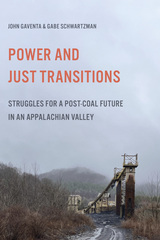 Power and Just Transitions: Struggles for a Post-Coal Future in an Appalachian Valley
John Gaventa and Gabe Schwartzman
University of Illinois Press, 2026 Published in 1982, John Gaventa’s award-winning Power and Powerlessness examined the dominance of the absentee coal industry in Central Appalachia. Gaventa and Gabe Schwartzman update the story through coal’s decline and into the present while focusing on how power relations and community mobilizing have changed and evolved during this era of transition. Their analysis tracks the impact on a place where a fossil fuel–based economy shaped political and social structures for over a century. As they show, new forms of power emerged while old ones remained, and both affected the popular struggle for a future that’s both just and more inclusive. Original and timely, Power and Just Transitions merges historical perspective with interviews and engagement to look at how coal’s decline impacted power and resistance in an Appalachian community.
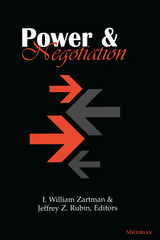 Power and Negotiation
I. William Zartman and Jeffrey Z. Rubin, Editors
University of Michigan Press, 2002 The editors to this volume begin their introduction with an age-old puzzle in negotiation: “How can weaker parties negotiate with stronger parties and still get something?” Addressing this and other paradoxes, Power and Negotiation produces new findings about the concept of power and about its applications in negotiations between countries. Rejecting the notions of power as a resource and power as an ability, the work defines power as an act that is designed to cause another party to move in a desired direction, thus separating the concept both from its source and from its effects and leaving it open to much more detailed analysis.Using this new definition of the concept of power, this book examines the relations between parties in symmetrical and asymmetrical negotiations. I. William Zartman and Jeffrey Z. Rubin argue that negotiations between countries that are not equal in power tend to be more efficient and effective than symmetrical negotiations, as weaker and stronger parties negotiating together know their roles and are able to get appropriate benefits to each side in a negotiated agreement. In cases of symmetry or near symmetry the countries, whether they are equally weak or equally strong, tend to spend most of their time maintaining their status and waste inordinate amounts of time before they ever come to an agreement. At the same time, Power and Negotiation also examines perceived power on the basis of which symmetries and asymmetries in the relations between parties can be identified. It then looks at six cases of clear asymmetry, two cases of symmetry, and one mixed situation. The book ends with a careful examination of lessons for practice and lessons for theory. The book will appeal to students of negotiation strategy and international relations.
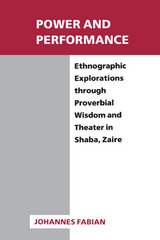 Power and Performance: Ethnographic Explorations through Proverbial Wisdom and Theater in Shaba, Zaire
Johannes Fabian
University of Wisconsin Press, 1990 In 1985 Johannes Fabian, while engaged in fieldwork in the Shaba province of Zaire, first encountered this saying. Its implications—for the charismatic religious movements Fabian was examining, for the highly charged political atmosphere of Zaire, and for the cultures of the Luba peoples—continued to intrigue him, though its meaning remained elusive. On a later visit, he mentioned the saying to a company of popular actors, and triggered an ethnographic brainstorm. “Spontaneously, they decided it would be just the right topic for their next play. On the spot they began planning—suggestions for a plot were made, problems of translating the French term ‘pouvoir’ were debated, several actors cited sayings and customs from their home villages. . . .”
Power and Performance examines traditional proverbs about power as it illustrates how the performance of Le pouvoir se mange entier was created, rehearsed, and performed. The play deals with the issue of power through a series of conflicts between villagers and their chief. Both rehearsal and performance versions of the text of this drama are included, in Swahili and in English translation.
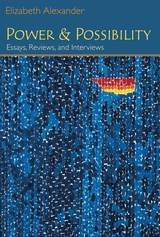 Power and Possibility: Essays, Reviews, and Interviews
Elizabeth Alexander
University of Michigan Press, 2007 A volume in the Poets on Poetry series, which collects critical works by contemporary poets, gathering together the articles, interviews, and book reviews by which they have articulated the poetics of a new generation. Elizabeth Alexander is considered one of the country's most gifted contemporary poets, and the publication of her essays in The Black Interior in 2004 established her as an astute critic and cultural commentator as well. Arnold Rampersad has called Alexander "one of the brightest stars in our literary sky . . . a superb, invaluable commentator on the American scene." In this new collection of her essays, reviews, and interviews, Alexander again focuses on African American artistic production, particularly poetry, and the cultural contexts in which it is created and experienced. The book's first section, "Black Arts 101," takes up the poetry of Paul Laurence Dunbar, Sterling Brown, Lucille Clifton, Gwendolyn Brooks, and Rita Dove (among others); artist Romare Bearden; dancer Bill T. Jones; and dramatist August Wilson. A second section, "Black Feminist Thinking," provides engaging meditations ranging from "My Grandmother's Hair" and "A Very Short History of Black Women and Food" to essays on the legacies of Toni Cade, Audre Lorde, and June Jordan. The collection's final section, "Talking," includes interviews, a commencement address---"Black Graduation"---and the essay "Africa and the World." Elizabeth Alexander received a B.A. from Yale University, an M.A. from Boston University, and a Ph.D. in English from the University of Pennsylvania. She has published four books of poems: The Venus Hottentot (1990); Body of Life (1996); Antebellum Dream Book (2001); and, most recently, American Sublime (2005), which was one of three finalists for the Pulitzer Prize. Her play, Diva Studies, was produced at the Yale School of Drama. She is presently Professor of American and African American Studies at Yale University.
Power and Powerlessness: Quiescence and Rebellion in an Appalachian Valley
John Gaventa
University of Illinois Press, 1980 Winner of the W. D. Weatherford Award of the Appalachian Society, the Woodrow Wilson Foundation Award of the APSA, Lillian Smith Award of the Southern Regional Council, V.O. Key Award of the Southern PSA, and the Governor's Award from the Kentucky Historical Society
 Power and Principle: Human Rights Programming in International Organizations
Joel E. Oestreich
Georgetown University Press, 2007 The UN Secretary-General, Kofi Annan, has instructed all UN specialized agencies and other affiliated organizations to consider how their work might advance the cause of human rights around the world. Many of these bodies have taken this call to heart, with a wide range of intergovernmental organizations (IGOs) trying to play a more active role in promoting human welfare. Power and Principle is a comparative study of how and why IGOs integrate human rights standards into their development operations. It focuses on the process of policy innovation in three UN-related IGOs: the UN Children's Fund (UNICEF,) the World Bank, and the World Health Organization (WHO). In his comprehensive analysis, Joel E. Oestreich uses case studies to demonstrate how their policies have evolved during the past two decades to reflect important human rights considerations. Drawing on interviews with dozens of staffers from IGOs, Oestreich creates a gripping narrative of the inner workings of these large bureaucracies. In each study he describes how the organization first became interested in human rights standards, how these standards were adopted as a priority, how the organization defined rights in the context of their work, and what a rights-based approach has meant in practice. The book argues that IGOs ought to be seen as capable of meaningful agency in international politics, and describes the nature of that agency. It concludes with an examination of these organizations and their ethical responsibilities as actors on the world stage.
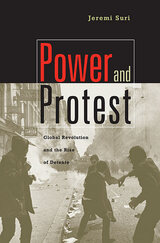 Power and Protest: Global Revolution and the Rise of Detente
Jeremi Suri
Harvard University Press, 2005 In a brilliantly-conceived book, Jeremi Suri puts the tumultuous 1960s into a truly international perspective in the first study to examine the connections between great power diplomacy and global social protest. Profoundly disturbed by increasing social and political discontent, Cold War powers united on the international front, in the policy of detente. Though reflecting traditional balance of power considerations, detente thus also developed from a common urge for stability among leaders who by the late 1960s were worried about increasingly threatening domestic social activism.
In the early part of the decade, Cold War pressures simultaneously inspired activists and constrained leaders; within a few years activism turned revolutionary on a global scale. Suri examines the decade through leaders and protesters on three continents, including Mao Zedong, Charles de Gaulle, Martin Luther King Jr., Daniel Cohn-Bendit, and Aleksandr Solzhenitsyn. He describes connections between policy and protest from the Berkeley riots to the Prague Spring, from the Paris strikes to massive unrest in Wuhan, China.
Designed to protect the existing political order and repress movements for change, detente gradually isolated politics from the public. The growth of distrust and disillusion in nearly every society left a lasting legacy of global unrest, fragmentation, and unprecedented public skepticism toward authority.
Power and Protest in the Countryside: Studies of Rural Unrest in Asia, Europe, and Latin America
Robert P. Weller and Scott Guggenheim
Duke University Press, 1993 “Constitutes an important and timely addition to the literature on peasant rebellion; wisely, the editors have been eclectic in drawing from some of the leading historians, anthropologists, political scientists, and sociologists active in the field an analysis of the forms that rural violence has taken through the past three centuries.”—Pacific Affairs
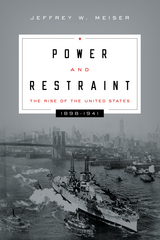 Power and Restraint: The Rise of the United States, 1898–1941
Jeffrey W. Meiser
Georgetown University Press, 2015 At the end of the nineteenth century, the United States emerged as an economic colossus in command of a new empire. Yet for the next forty years the United States eschewed the kind of aggressive grand strategy that had marked other rising imperial powers in favor of a policy of moderation. In Power and Restraint, Jeffrey W. Meiser explores why the United States—counter to widely accepted wisdom in international relations theory—chose the course it did. Using thirty-four carefully researched historical cases, Meiser asserts that domestic political institutions and culture played a decisive role in preventing the mobilization of resources necessary to implement an expansionist grand strategy. These factors included traditional congressional opposition to executive branch ambitions, voter resistance to European-style imperialism, and the personal antipathy to expansionism felt by presidents like Woodrow Wilson and Franklin Roosevelt. The web of resilient and redundant political restraints halted or limited expansionist ambitions and shaped the United States into an historical anomaly, a rising great power characterized by prudence and limited international ambitions.
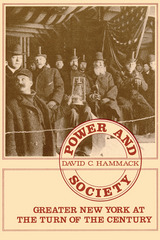 Power and Society in Greater NY
David C. Hammack
Russell Sage Foundation, 1982 Who has ruled New York? Has power become more concentrated—or more widely and democratically dispersed—in American cities over the past one hundred years? How did New York come to have its modern physical and institutional shape? Focusing on the period when New York City was transformed from a nineteenth-century mercantile center to a modern metropolis, David C. Hammack offers an entirely new view of the history of power and public policy in the nation's largest urban community. Opening with a fresh and original interpretation of the metropolitan region's economic and social history between 1890 and 1910, Hammack goes on to show how various population groups used their economic, social, cultural, and political resources to shape the decisions that created the modern city. As New York grew in size and complexity, its economic and social interests were forced to compete and form alliances. No single group—not even the wealthy—was able to exercise continuing control of urban policy. Building on his account of this interplay among numerous elites, Hammack concludes with a new interpretation of the history of power in New York and other American cities between 1890 and 1950. This book makes a major contribution to the study of community power, of urban and regional history, and of public policy. And by taking the meaning and distribution of power as his theme, Hammack is able to reintegrate economic, social, and political history in a rich and comprehensive work. "Lucid, instructive, and discerning....The most commanding analysis of its subject that I know." —John M. Blum, professor of history, Yale University "A powerful and persuasive treatment of a marvelous subject." —Nelson W. Polsby, professor of political science, University of California, Berkeley
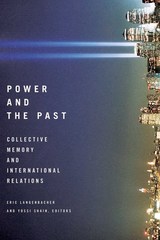 Power and the Past: Collective Memory and International Relations
Eric Langenbacher and Yossi Shain, Editors
Georgetown University Press, 2010 Only recently have international relations scholars started to seriously examine the influence of collective memory on foreign policy formation and relations between states and peoples. The ways in which the memories of past events are interpreted, misinterpreted, or even manipulated in public discourse create the context that shapes international relations. Power and the Past brings together leading history and international relations scholars to provide a groundbreaking examination of the impact of collective memory. This timely study makes a contribution to developing a theory of memory and international relations and also examines specific cases of collective memory’s influence resulting from the legacies of World War II, the Holocaust, and September 11. Addressing concerns shared by world leaders and international institutions as well as scholars of international studies, this volume illustrates clearly how the memory of past events alters the ways countries interact in the present, how memory shapes public debate and policymaking, and how memory may aid or more frequently impede conflict resolution.
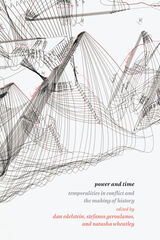 Power and Time: Temporalities in Conflict and the Making of History
Edited by Dan Edelstein, Stefanos Geroulanos, and Natasha Wheatley
University of Chicago Press, 2020 Time is the backdrop of historical inquiry, yet it is much more than a featureless setting for events. Different temporalities interact dynamically; sometimes they coexist tensely, sometimes they clash violently. In this innovative volume, editors Dan Edelstein, Stefanos Geroulanos, and Natasha Wheatley challenge how we interpret history by focusing on the nexus of two concepts—“power” and “time”—as they manifest in a wide variety of case studies. Analyzing history, culture, politics, technology, law, art, and science, this engaging book shows how power is constituted through the shaping of temporal regimes in historically specific ways. Power and Time includes seventeen essays on human rights; sovereignty; Islamic, European, Chinese, and Indian history; slavery; capitalism; revolution; the Supreme Court; the Anthropocene; and even the Manson Family. Power and Time will be an agenda-setting volume, highlighting the work of some of the world’s most respected and original contemporary historians and posing fundamental questions for the craft of history.
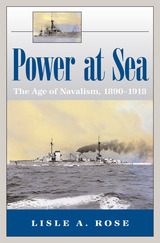 Power at Sea, Volume 1: The Age of Navalism, 1890-1918
Lisle A. Rose
University of Missouri Press, 2006 The twentieth century was preeminently an age of warring states and collapsing empires. Industrialism brought not peace but the sword. And the tip of that sword was sea power. In Power at Sea, Lisle A. Rose gives us an unprecedented narrative assessment of modern sea power, how it emerged from the Age of Fighting Sail, how it was employed in war and peace, and how it has shaped the life of the human community over the past century and a quarter. In this first volume, Rose recalls the early twentieth-century world of emerging, predatory industrial nations engaging in the last major scramble for global markets and empire. In such times, an imposing war fleet was essential to both national security and international prestige. Battleship navies became pawns of power politics, and between 1890 and 1914 four of them--Britain’s Royal Navy, the Imperial German Navy, the Japanese Navy, and the U.S. Navy--set the tone and rhythm of international life. Employing a global canvas, Rose portrays the increasingly frantic naval race between Britain and Germany that did so much to bring about the First World War; he takes us aboard America’s Great White Fleet as it circumnavigated the world between 1907 and 1909, leaving in its wake both goodwill and jealousy; he details Japan’s growing naval and military power and the hunger for unlimited expansion that resulted. Important naval battles were fought in those days of ostensible peace, and Rose brings to life the encounters of still young and relatively small industrial fighting fleets at Manila Bay and Tsushima. He also takes us into the huge naval factories where the engines of war were forged. He invites us aboard the imperial battleships and battle cruisers, exploring the dramatically divided worlds of the officers’ lordly wardroom with its clublike atmosphere and the often foul and fetid enlisted men’s quarters. The Age of Navalism climaxed in the epic First World War Battle of Jutland, in which massive guns and maneuvering dreadnoughts determined that Imperial Germany would become the latest in a line of ambitious naval powers that failed to shake Britannia’s rule of the waves. Germany’s subsequent use of a revolutionary new strategy, unrestricted submarine warfare, nearly brought Britain to its knees, reduced the level of naval combat to barbarism, and brought the United States into the war with its own substantial navy, ultimately turning the tide of battle. Focusing as much on social issues and technological advances as on combat, Power at Sea: The Age of Navalism tells a compelling story of newfound power that is fascinating in its own right. Yet, it is merely a prologue to more startling accounts contained in the author’s succeeding volumes.
 Power at Sea, Volume 2: The Breaking Storm, 1919-1945
Lisle A. Rose
University of Missouri Press, 2006 After 1921, the clouds of suspicion and resentment left by the Great War gradually obscured the strenuous efforts of negotiating statesmen and led to ever greater appetites for power at sea. By the midthirties, worried admiralties around the world were bracing themselves for a new and deadlier round of global violence. In this monumental study, Lisle A. Rose revisits the strategies, battles, ships, planes, weapons, and people of the most destructive war in history to show the decisive influence of sea power upon its outcome. During the years preceding World War II, Britain’s once dominant Royal Navy, beset by national economic decline and steadily eroding morale within the fleet, pleaded for the appeasement of dictators in Europe and the Far East in an attempt to avoid a three-front maritime war that would surely doom the British Empire. Desperately hoping for time to build a formidable fleet, Hitler’s admirals feverishly tried to rebuild German naval weaponry upon a technological foundation not much improved since 1918. In the end, it was Japan and the United States, facing each other across the broad Pacific, that moved naval history into a new phase by fashioning ultramodern navies based on the integration of sea, air, and amphibious forces. Rose relates how the strengths and weaknesses of seafaring nations came into play within the crucible of a six-year war during which naval encounters were every bit as critical and frequent as land-based fighting. He recounts the well-known naval battles and operations of World War II from a novel perspective, placing them in the context of daring gambles open to both the Axis and the Allies that were either seized upon or ignored. Once Britain’s survival was assured, and the Allies held on in the North Atlantic and the Pacific, however, the superior industrial culture of the United States doomed the Axis. After 1943, America threw into the deadly battles against the German U-boats and the Japanese fleet more and better ships, more and better citizen sailors, better intelligence, and better strategies than did its antagonists or allies. Two years later, the United States had not only defeated the Axis, it had also won control of the world’s oceans from its exhausted British ally. In the process, it had begun a revolutionary transition in which power at sea became power from the sea. Whether recounting the heart-stopping action of naval encounters or analyzing the technologies that made victory possible, Rose traces in vigorous, memorable prose the dramatic emergence of a new naval power that would leave all others in its wake.
 Power at Sea, Volume 3: A Violent Peace, 1946-2006
Lisle A. Rose
University of Missouri Press, 2006 Bringing to a close his epic recounting of naval power in the twentieth century, Lisle Rose describes the virtual disappearance after 1945 of all but one great navy, whose existence and operations over the next sixty years guaranteed a freedom of the seas so complete as to be at once universally acknowledged and ignored. In the first twenty years after World War II, the U.S. Navy continued the revolutionary transformation of sea power begun in the 1930s with the integration of sea, air, and amphibious capabilities. Between 1946 and 1961, the United States placed on, above, and beneath the world’s oceans the mightiest concentration of military power in history. Supercarriers filled with aircraft capable of long-range nuclear strikes were joined by strategic ballistic missile submarines, even one of whose sixteen nuclear-tipped missiles could devastate most of an enemy’s major urban centers together with its industrial and military infrastructure. Such a fleet was incredibly costly. No ally or adversary in a world recovering slowly from global war could afford to build and maintain such an awesome entity. Its needs constantly had to be balanced against competing requirements of a broader national defense establishment. But the U.S. Navy ensured an unchallenged Pax Americana, and its warships steamed where they wished throughout the globe in support of a policy to contain the influence and threat represented by the Soviet Union and China. The 1962 Cuban missile crisis, however, galvanized the Soviet leadership to construct a powerful blue-water fleet that within less than a decade began to challenge the United States for global maritime supremacy, even as its own ballistic missile boats posed a massive threat to U.S. national security. While the Soviets enjoyed the luxury of building exclusively against the U.S. Navy and challenging it at almost every point, America’s sailors were increasingly burdened by a broad array of specific missions: fighting two regional wars in Asia, intervening in Lebanon, protecting Taiwan, aiding in the preservation of Israel, and maintaining close surveillance of Cuba, chief among them. Confronting ever-growing Soviet sea power stretched U.S. capabilities to the limit even as the fleet itself underwent revolutionary changes in its social composition. The abrupt decline and fall of the Soviet Union after 1989 led to another reappraisal of the importance, even necessity, of navies. But the turbulent Middle East and the struggle against international terrorism after 2001 have demanded a projection of sea-air-amphibious power onto coasts and adjacent areas similar to that which America’s fleets had already undertaken in Korea, Vietnam, and Lebanon. The U.S. Navy now sails on the front line of defense against terrorism—a threat that confronts strategists with the greatest challenge yet to the ongoing relevance of maritime power. This third volume of Rose’s majestic work offers readers an up-close look at the emergence of America’s naval might and establishes Power at Sea as essential in tracing the emergence of U.S. dominance and understanding the continuing importance of ships and sailors in international power plays.
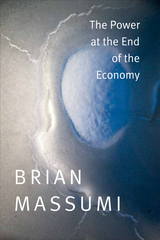 The Power at the End of the Economy
Brian Massumi
Duke University Press, 2015 Rational self-interest is often seen as being at the heart of liberal economic theory. In The Power at the End of the Economy Brian Massumi provides an alternative explanation, arguing that neoliberalism is grounded in complex interactions between the rational and the emotional. Offering a new theory of political economy that refuses the liberal prioritization of individual choice, Massumi emphasizes the means through which an individual’s affective tendencies resonate with those of others on infra-individual and transindividual levels. This nonconscious dimension of social and political events plays out in ways that defy the traditional equation between affect and the irrational. Massumi uses the Arab Spring and the Occupy Movement as examples to show how transformative action that exceeds self-interest takes place. Drawing from David Hume, Michel Foucault, Gilles Deleuze, Niklas Luhmann and the field of nonconsciousness studies, Massumi urges a rethinking of the relationship between rational choice and affect, arguing for a reassessment of the role of sympathy in political and economic affairs.
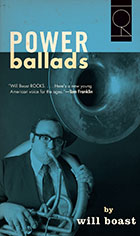 Power Ballads
Will Boast
University of Iowa Press, 2011 Real musicians don’t sign autographs, date models, or fly in private jets. They spend their lives in practice rooms and basement clubs or toiling in the obscurity of coffee-shop gigs, casino jobs, and the European festival circuit. The ten linked stories in Power Ballads are devoted to this unheard virtuoso: the working musician. From the wings of sold-out arenas to hip-hop studios to polka bars, these stories are born out of a nocturnal world where music is often simply work, but also where it can, in rare moments, become a source of grace and transcendence, speaking about the things we never seem to say to each other. A skilled but snobby jazz drummer joins a costumed heavy metal band to pay his rent. A country singer tries to turn her brutal past into a successful career. A vengeful rock critic reenters the life of an emerging singer-songwriter, bent on wreaking havoc. The characters in Power Ballads—aging head-bangers, jobbers, techno DJs, groupies, and the occasional rock star (and those who have to live with them)—need music to survive, yet find themselves lost when the last note is played, the lights go up, and it’s time to return to regular life. By turns melancholy and hilarious, Power Ballads is not only a deeply felt look at the lives of musicians but also an exploration of the secret music that plays inside us all.
 Power Beyond Scrutiny: Media, Justice and Accountability
Justin Schlosberg
Pluto Press, 2013 Power Beyond Scrutiny uncovers the forces which distort and limit public debate in the media. From the misuse of politicians' expenses to recent phone hacking scandals, establishment corruption has never been more in the headlines. Yet amidst the din there have been seismic silences.
Justin Schlosberg interrogates these silences - why did a plea bargain which allowed Britain’s biggest arms company to escape bribery prosecution go almost entirely unchallenged in television news? Why did journalists routinely endorse the official explanation of how intelligence analyst David Kelly died, whilst all but ignoring mounting evidence which undermined it? Why, in 2010, did broadcasters offer an unchallenged platform to critics of Wikileaks but not its supporters?
These are some of the questions and imbalances that Schlosberg seeks to address as he explains the nature of public debate in the digital age. In doing so he uncovers a range of news blockages that are more than just accidents of a fragmented, chaotic mediascape. They are ultimately ideological forces which ensure that contestability and dissent remain within definable limits.
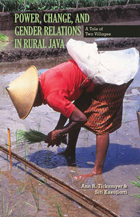 Power, Change, and Gender Relations in Rural Java: A Tale of Two Villages
Ann R. Tickamyer
Ohio University Press, 2012 Women’s status in rural Java can appear contradictory to those both inside and outside the culture. In some ways, women have high status and broad access to resources, but other situations suggest that Javanese women lack real power and autonomy. Javanese women have major responsibilities in supporting their families and controlling household finances. They may also own and manage their own property. Yet these symbols and potential sources of independence and influence are determined by a culturally prescribed, state-reinforced, patriarchal gender ideology that limits women’s autonomy. Power, Change, and Gender Relations in Rural Java examines this contradiction as well as sources of stability and change in contemporary Javanese gender relations. The authors conducted their research in two rural villages in Yogyakarta, Indonesia, during three important historical and political periods: the end of the New Order regime; the transitional period of reformation; and the subsequent establishment of a democratic government. Their collaboration brings a unique perspective, analyzing how gender is constructed and reproduced and how power is exercised as Indonesia faces the challenges of building a new social order.
Power Circuit Breaker Theory and Design
C.H. Flurscheim
The Institution of Engineering and Technology, 1982 The aim has been to provide an up-to-date analysis of the theoretical and practical problems involved in circuit breaker design. Circuit breakers present very special design problems because of the wide mixture of experience required.
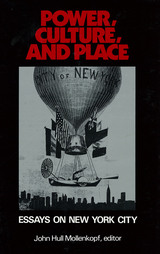 Power, Culture and Place: Essays on New York City
John H. Mollenkopf
Russell Sage Foundation, 1988 With a population and budget exceeding that of many nations, a central position in the world's cultural and corporate networks, and enormous concentrations off wealth and poverty, New York City intensifies interactions among social forces that elsewhere may be hidden or safely separated. The essays in Power, Culture, and Place represent the first comprehensive program of research on this city in a quarter century. Focusing on three historical transformations—the mercantile, industrial, and postindustrial—several contributors explore economic growth and change and the social conflicts that accompanied them. Other papers suggest how popular culture, public space, and street life served as sources of order amidst conflict and disorder. Essays on politics and pluralism offer further reflections on how social tensions are harnessed in the framework of political participation. By examining the intersection of economics, culture, and politics in a shared spatial context, these multidisciplinary essays not only illuminate the City's fascinating and complex development, but also highlight the significance of a sense of "place" for social research. It has been said that cities gave birth to the social sciences, exemplifying and propagating dramatic social changes and proving ideal laboratories for the study of social patterns and their evolution. As John Mollenkopf and his colleagues argue, New York City remains the quintessential case in point.
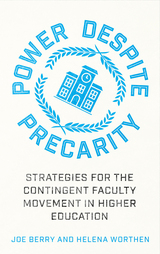 Power Despite Precarity: Strategies for the Contingent Faculty Movement in Higher Education
Joe Berry
Pluto Press, 2021 Higher education is the site of an ongoing conflict. At the heart of this struggle are the precariously employed faculty 'contingents' who work without basic job security, living wages or benefits. Yet they have the incentive and, if organized, the power to shape the future of higher education.
Power Despite Precarity is part history, part handbook and a wholly indispensable resource in this fight. Joe Berry and Helena Worthen outline the four historical periods that led to major transitions in the worklives of faculty of this sector. They then take a deep dive into the 30-year-long struggle by California State University lecturers to negotiate what is recognized as the best contract for contingents in the US.
The authors ask: what is the role of universities in society? Whose interests should they serve? What are the necessary conditions for the exercise of academic freedom? Providing strategic insight for activists at every organizing level, they also tackle 'troublesome questions' around legality, union politics, academic freedom and how to recognize friends (and foes) in the struggle.
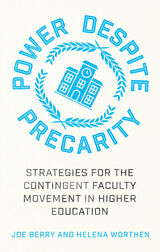 Power Despite Precarity: Strategies for the Contingent Faculty Movement in Higher Education
Joe Berry
Pluto Press, 2021 Higher education is the site of an ongoing conflict. At the heart of this struggle are the precariously employed faculty 'contingents' who work without basic job security, living wages or benefits. Yet they have the incentive and, if organized, the power to shape the future of higher education.
Power Despite Precarity is part history, part handbook and a wholly indispensable resource in this fight. Joe Berry and Helena Worthen outline the four historical periods that led to major transitions in the worklives of faculty of this sector. They then take a deep dive into the 30-year-long struggle by California State University lecturers to negotiate what is recognized as the best contract for contingents in the US.
The authors ask: what is the role of universities in society? Whose interests should they serve? What are the necessary conditions for the exercise of academic freedom? Providing strategic insight for activists at every organizing level, they also tackle 'troublesome questions' around legality, union politics, academic freedom and how to recognize friends (and foes) in the struggle.
Power Distribution Automation
Biswarup Das
The Institution of Engineering and Technology, 2016 Utilities around the world are under increasing pressure to provide reliable and good quality power supply to their retail customers, and to reduce their operational costs. These concerns call for real time monitoring and control of the distribution system, which can be accomplished by deploying distribution automation (DA) systems, a key enabling technology for smart grids.
Power Distribution System State Estimation
Elizete Maria Lourenço
The Institution of Engineering and Technology, 2022 State estimation is a key function for real-time operation and control of electrical power systems since its role is to provide a complete, coherent, and reliable network real-time model used to set up other real-time operation and control functions. In recent years it has extended its applications to monitoring active distribution networks with distributed energy resources. The inputs of a conventional state estimator are a redundant collection of real-time measurement, load and production forecasts and a mathematical model that relates these measurements to the complex nodal voltages, which are taken as the state variables of the system. The goal of state estimation is to adjust models so that they are closer to observed values and deliver better forecasts. In power systems, this is key to maintaining power quality and operating generation and storage units well.
 Power: Divine and Human: Christian and Muslim Perspectives
Lucinda Mosher and David Marshall, Editors
Georgetown University Press, 2019 This volume of the Building Bridges Seminar, Power: Divine and Human, Christian and Muslim Perspectives, comprises pairs of essays by Christians and Muslims which introduce texts for dialogical study, plus the actual text-excerpts themselves. This new book goes far beyond mere reporting on a dialogical seminar; rather, it provides guidance and materials for constructing a similar dialogical experience on a particular topic. As a resource for comparative theology, Power: Divine and Human is unique in that it takes up a topic not usually explored in depth in Christian-Muslim conversations. It is written by scholars for scholars. However, in tone and structure, it is suitable for the non-specialist as well. Students (undergraduate and graduate), religious leaders, and motivated non-specialists will find it readable and useful. While it falls solidly in the domain of comparative theology, it can also be used in courses on dialogical reading of scripture, interreligious relations, and political philosophy.
Power Electronic Converters and Systems: Applications, Volume 2
Marcelo Godoy Simões
The Institution of Engineering and Technology, 2024 Power electronics is a field in constant evolution. Power grids require further developments, and the overall society electrification requires enhanced power electronics and motor drives. New semiconductor wide bandgap devices and modern implementation hardware software play a key role, power converters for the direct current and alternating current electrical conversion, for changing voltage or frequency have become integrated with layers of communication, control, and information processing.
Power Electronic Converters and Systems: Converters and machine drives, Volume 1
Marcelo Godoy Simões
The Institution of Engineering and Technology, 2024 Power electronics is a field in constant evolution. Power grids require further developments, and the overall society electrification requires enhanced power electronics and motor drives. New semiconductor wide bandgap devices and modern implementation hardware software play a key role, power converters for the direct current and alternating current electrical conversion, for changing voltage or frequency have become integrated with layers of communication, control, and information processing.
 Power Electronic Converters and Systems: Frontiers and applications
Andrzej M. Trzynadlowski
The Institution of Engineering and Technology, 2016 Power electronics is a branch of electrical engineering dealing with conversion and control of electric power using semiconductor power switches. This book, written by an international panel of more than 40 experts, provides an overview of modern power electronic converters and systems, and their applications. Topics covered include semiconductor power switches, multilevel, multi-input, modular, matrix, soft-switching, and Z-source converters, switching power supplies, and smart power electronic modules. Applications discussed encompass permanent magnet synchronous motor and induction motor drives, wind, photovoltaic, and automotive energy systems, shipboard power systems, the power grid, distributed generation and microgrids, uninterruptable power supplies, and wireless power transfer. Advanced control of power electronic systems is also examined. The book is essential reading for researchers and students working in power electronics, and for practising engineers specialising in the development and application of power electronic converters and systems.
Power Electronics for Next-Generation Drives and Energy Systems: Clean generation and power grids, Volume 2
Nayan Kumar
The Institution of Engineering and Technology, 2022 Power electronics converters are devices that change parameters of electric power, such as voltage and frequency, as well as between AC and DC. They are essential parts of both advanced drives, for machines and vehicles, and energy systems to meet required flexibility and efficiency criteria. In energy systems both stationary and mobile, control and converters help ensure reliability and quality of electric power supplies.
Power Electronics for Next-Generation Drives and Energy Systems: Converters and control for drives, Volume 1
Nayan Kumar
The Institution of Engineering and Technology, 2022 Power electronics converters are devices that change parameters of electric power, such as voltage and frequency, as well as between AC and DC. They are essential parts of both advanced drives, for machines and vehicles, and energy systems to meet required flexibility and efficiency criteria. In energy systems both stationary and mobile, control and converters help ensure reliability and quality of electric power supplies.
Power Electronics Packaging Reliability
Mark Johnson
The Institution of Engineering and Technology, 2020 Unpredictable fluctuating loads and exposure to widely varying environmental conditions (including heat, vibration, humidity and dust) present a particularly challenging environment for power electronics modules. This book describes the technologies involved in power electronic device manufacturing with an emphasis on characterising the key wear-out mechanisms and technologies to increase reliability. This book is a must-read for all engineers involved with electronics or reliable power systems.
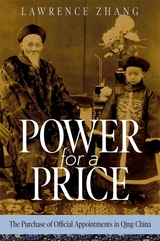 Power for a Price: The Purchase of Official Appointments in Qing China
Lawrence Zhang
Harvard University Press, 2022 The Qing dynasty office purchase system (juanna), which allowed individuals to pay for appointments in the government, was regarded in traditional Chinese historiography as an inherently corrupt and anti-meritocratic practice. It enabled participants to become civil and military officials while avoiding the competitive government-run examination systems.
Lawrence Zhang’s groundbreaking study of a broad selection of new archival and other printed evidence—including a list of over 10,900 purchasers of offices from 1798 and narratives of purchase—contradicts this widely held assessment and investigates how observers and critics of the system, past and present, have informed this questionable negative view. The author argues that, rather than seeing office purchase as a last resort for those who failed to obtain official appointments via other means, it was a preferred method for wealthy and well-connected individuals to leverage their social capital to the fullest extent. Office purchase was thus not only a useful device that raised funds for the state, but also a political tool that, through literal investments in their positions and their potential to secure status and power, tied the interests of official elites ever more closely to those of the state.
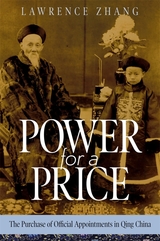 Power for a Price: The Purchase of Official Appointments in Qing China
Lawrence Zhang
Harvard University Press, 2022 The Qing dynasty office purchase system (juanna), which allowed individuals to pay for appointments in the government, was regarded in traditional Chinese historiography as an inherently corrupt and anti-meritocratic practice. It enabled participants to become civil and military officials while avoiding the competitive government-run examination systems.
Lawrence Zhang’s groundbreaking study of a broad selection of new archival and other printed evidence—including a list of over 10,900 purchasers of offices from 1798 and narratives of purchase—contradicts this widely held assessment and investigates how observers and critics of the system, past and present, have informed this questionable negative view. The author argues that, rather than seeing office purchase as a last resort for those who failed to obtain official appointments via other means, it was a preferred method for wealthy and well-connected individuals to leverage their social capital to the fullest extent. Office purchase was thus not only a useful device that raised funds for the state, but also a political tool that, through literal investments in their positions and their potential to secure status and power, tied the interests of official elites ever more closely to those of the state.
Power Grids with Renewable Energy: Storage, integration and digitalization
Abdelhay A. Sallam
The Institution of Engineering and Technology, 2021 Generation of electricity from renewable sources has become a necessity, particularly due to environmental concerns. In order for renewable sources to provide reliable power, their sporadic availability under certain conditions and the lack of control over the resource must be addressed. Different renewable energy sources and storage technologies bring various properties to the table, and power systems must be adapted and constructed to accommodate these. Power electronics and micro-grids play key roles in enabling the use of renewable energy in the evolving smarter grids.
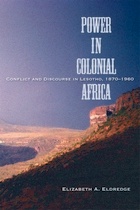 Power in Colonial Africa: Conflict and Discourse in Lesotho, 1870–1960
Elizabeth A. Eldredge
University of Wisconsin Press, 2007 Even in its heyday European rule of Africa had limits. Whether through complacency or denial, many colonial officials ignored the signs of African dissent. Displays of opposition by Africans, too indirect to counter or quash, percolated throughout the colonial era and kept alive a spirit of sovereignty that would find full expression only decades later.
In Power in Colonial Africa: Conflict and Discourse in Lesotho, 1870–1960, Elizabeth A. Eldredge analyzes a panoply of archival and oral resources, visual signs and symbols, and public and private actions to show how power may be exercised not only by rulers but also by the ruled. The BaSotho—best known for their consolidation of a kingdom from the 1820s to 1850s through primarily peaceful means, and for bringing colonial forces to a standstill in the Gun War of 1880–1881—struggled to maintain sovereignty over their internal affairs during their years under the colonial rule of the Cape Colony (now part of South Africa) and Britain from 1868 to 1966. Eldredge explores instances of BaSotho resistance, resilience, and resourcefulness in forms of expression both verbal and non-verbal. Skillfully navigating episodes of conflict, the BaSotho matched wits with the British in diplomatic brinksmanship, negotiation, compromise, circumvention, and persuasion, revealing the capacity of a subordinate population to influence the course of events as it selectively absorbs, employs, and subverts elements of the colonial culture.
“A refreshing, readable and lucid account of one in an array of compositions of power during colonialism in southern Africa.”—David Gordon, Journal of African History
“Elegantly written.”—Sean Redding, Sub-Saharan Africa
“Eldredge writes clearly and attractively, and her studies of the war between Lerotholi and Masupha and of the conflicts over the succession to the paramountcy are essential reading for anyone who wants to understand those crises.”—Peter Sanders, Journal of Southern African Studies
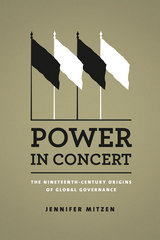 Power in Concert: The Nineteenth-Century Origins of Global Governance
Jennifer Mitzen
University of Chicago Press, 2013 How states cooperate in the absence of a sovereign power is a perennial question in international relations. With Power in Concert, Jennifer Mitzen argues that global governance is more than just the cooperation of states under anarchy: it is the formation and maintenance of collective intentions, or joint commitments among states to address problems together. The key mechanism through which these intentions are sustained is face-to-face diplomacy, which keeps states’ obligations to one another salient and helps them solve problems on a day-to-day basis.
Mitzen argues that the origins of this practice lie in the Concert of Europe, an informal agreement among five European states in the wake of the Napoleonic wars to reduce the possibility of recurrence, which first institutionalized the practice of jointly managing the balance of power. Through the Concert’s many successes, she shows that the words and actions of state leaders in public forums contributed to collective self-restraint and a commitment to problem solving—and at a time when communication was considerably more difficult than it is today. Despite the Concert’s eventual breakdown, the practice it introduced—of face to face diplomacy as a mode of joint problem solving—survived and is the basis of global governance today.
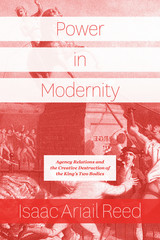 Power in Modernity: Agency Relations and the Creative Destruction of the King’s Two Bodies
Isaac Ariail Reed
University of Chicago Press, 2020 In Power in Modernity, Isaac Ariail Reed proposes a bold new theory of power that describes overlapping networks of delegation and domination. Chains of power and their representation, linking together groups and individuals across time and space, create a vast network of intersecting alliances, subordinations, redistributions, and violent exclusions. Reed traces the common action of “sending someone else to do something for you” as it expands outward into the hierarchies that control territories, persons, artifacts, minds, and money.
He mobilizes this theory to investigate the onset of modernity in the Atlantic world, with a focus on rebellion, revolution, and state formation in colonial North America, the early American Republic, the English Civil War, and French Revolution. Modernity, Reed argues, dismantled the “King’s Two Bodies”—the monarch’s physical body and his ethereal, sacred second body that encompassed the body politic—as a schema of representation for forging power relations. Reed’s account then offers a new understanding of the democratic possibilities and violent exclusions forged in the name of “the people,” as revolutionaries sought new ways to secure delegation, build hierarchy, and attack alterity.
Reconsidering the role of myth in modern politics, Reed proposes to see the creative destruction and eternal recurrence of the King’s Two Bodies as constitutive of the modern attitude, and thus as a new starting point for critical theory. Modernity poses in a new way an eternal human question: what does it mean to be the author of one’s own actions?
 Power in the Balance: Presidents, Parties, and Legislatures in Peru and Beyond
Barry S. Levitt
University of Notre Dame Press, 2012
In Power in the Balance: Presidents, Parties, and Legislatures in Peru and Beyond, Barry S. Levitt answers urgent questions about executive power in “new” democracies. He examines in rich detail the case of Peru, from President Alan García’s first term (1985–1990), to the erosion of democracy under President Alberto Fujimori (1990–2000), through the interim government of Valentín Paniagua (2000–2001) and the remarkable, if rocky, renewal of democracy culminating in Alejandro Toledo's 2001–2006 presidency. This turbulent experience with democracy brings into clear focus the functioning of formal political institutions—constitutions and electoral laws, presidents and legislatures, political parties and leaders—while also exposing the informal side of Peru’s national politics over the course of two decades.
Levitt's study of politics in Peru also provides a test case for his regional analysis of cross-national differences and change over time in presidential power across eighteen Latin American countries. In Peru and throughout Latin America, Levitt shows, the rule of law itself and the organizational forms of political parties have a stronger impact on legislative-executive relations than do most of the institutional traits and constitutional powers that configure the formal "rules of the game" for high politics. His findings, and their implications for improving the quality of new democracies everywhere, will surprise promoters, practitioners, and scholars of democratic politics alike.
"Barry S. Levitt has delivered an important and original analysis of presidential power, legislative-executive relations, party politics, and rule of law in Peru from 1985 through 2006, advancing a fresh perspective on the strengths—and limitations—of institutionalist analyses in the fragile new democracies of Latin America. His book will be of great significance to scholars and students studying democratization and legislative-executive relations in the region."
—Scott P. Mainwaring, Eugene and Helen Conley Professor of Political Science and Director of the Kellogg Institute for International Studies, University of Notre Dame
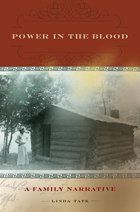 Power in the Blood: A Family Narrative
Linda Tate
Ohio University Press, 2009 Power in the Blood: A Family Narrative traces Linda Tate’s journey to rediscover the Cherokee-Appalachian branch of her family and provides an unflinching examination of the poverty, discrimination, and family violence that marked their lives. In her search for the truth of her own past, Tate scoured archives, libraries, and courthouses throughout Kentucky, Tennessee, Alabama, Illinois, and Missouri, visited numerous cemeteries, and combed through census records, marriage records, court cases, local histories, old maps, and photographs. As she began to locate distant relatives — fifth, sixth, seventh cousins, all descended from her great-greatgrandmother Louisiana — they gathered in kitchens and living rooms, held family reunions, and swapped stories. A past that had long been buried slowly came to light as family members shared the pieces of the family’s tale that had been passed along to them. Power in the Blood is a dramatic family history that reads like a novel, as Tate’s compelling narrative reveals one mystery after another. Innovative and groundbreaking in its approach to research and storytelling, Power in the Blood shows that exploring a family story can enhance understanding of history, life, and culture and that honest examination of the past can lead to healing and liberation in the present.
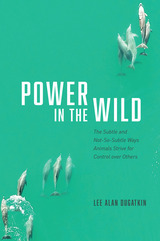 Power in the Wild: The Subtle and Not-So-Subtle Ways Animals Strive for Control over Others
Lee Alan Dugatkin
University of Chicago Press, 2022 From the shell wars of hermit crabs to little blue penguins spying on potential rivals, power struggles in the animal kingdom are as diverse as they are fascinating, and this book illuminates their surprising range and connections.
The quest for power in animals is so much richer, so much more nuanced than who wins what knock-down, drag-out fight. Indeed, power struggles among animals often look more like an opera than a boxing match. Tracing the path to power for over thirty different species on six continents, writer and behavioral ecologist Lee Alan Dugatkin takes us on a journey around the globe, shepherded by leading researchers who have discovered that in everything from hyenas to dolphins, bonobos to field mice, cichlid fish to cuttlefish, copperhead snakes to ravens, and meerkats to mongooses, power revolves around spying, deception, manipulation, forming and breaking up alliances, complex assessments of potential opponents, building social networks, and more. Power pervades every aspect of the social life of animals: what they eat, where they eat, where they live, whom they mate with, how many offspring they produce, whom they join forces with, and whom they work to depose. In some species, power can even change an animal’s sex. Nor are humans invulnerable to this magnificently intricate melodrama: Dugatkin’s tales of the researchers studying power in animals are full of unexpected pitfalls, twists and turns, serendipity, and the pure joy of scientific discovery.
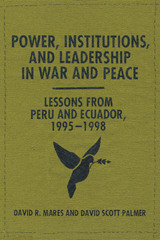 Power, Institutions, and Leadership in War and Peace: Lessons from Peru and Ecuador, 1995–1998
By David R. Mares and David Scott Palmer
University of Texas Press, 2012 In January 1995, fighting broke out between Ecuadorian and Peruvian military forces in a remote section of the Amazon. It took more than three years and the interplay of multiple actors and factors to achieve a definitive peace agreement, thus ending what had been the region's oldest unresolved border dispute. This conflict and its resolution provide insights about other unresolved and/or disputed land and sea boundaries which involve almost every country in the Western Hemisphere. Drawing on extensive field research at the time of the dispute and during its aftermath, including interviews with high-ranking diplomats and military officials, Power, Institutions, and Leadership in War and Peace is the first book-length study to relate this complex border dispute and its resolution to broader theories of conflict. The findings emphasize an emerging leadership approach in which individuals are not mere captives of power and institutions. In addition, the authors illuminate an overlap in national and international arenas in shaping effective articulation, perception, and selection of policy. In the “new” democratic Latin America that emerged in the late 1970s through the early 1990s, historical memory remains influential in shaping the context of disputes, in spite of presumed U.S. post–Cold War influence. This study offers important, broader perspectives on a hemisphere still rife with boundary disputes as a rising number of people and products (including arms) pass through these borderlands.
 Power, Knowledge, and Politics: Policy Analysis in the States
John A. Hird
Georgetown University Press, 2005 If knowledge is power, then John Hird has opened the doors for anyone interested in public policymaking and policy analysis on the state level. A beginning question might be: does politics put gasoline or sugar in the tank? More specifically, in a highly partisan political environment, is nonpartisan expertise useful to policymaking? Do policy analysts play a meaningful role in decision making? Does policy expertise promote democratic decision making? Does it vest power in an unelected and unaccountable elite, or does it become co-opted by political actors and circumstances? Is it used to make substantive changes or just for window-dressing? In a unique comparative focus on state policy, Power, Knowledge, and Politics dissects the nature of the policy institutions that policymakers establish and analyzes the connection between policy research and how it is actually used in decision making. Hird probes the effects of politics and political institutions—parties, state political culture and dynamics, legislative and gubernatorial staffing, partisan think tanks, interest groups—on the nature and conduct of nonpartisan policy analysis. Through a comparative examination of institutions and testing theories of the use of policy analysis, Hird draws conclusions that are more useful than those derived from single cases. Hird examines nonpartisan policy research organizations established by and operating in U.S. state legislatures—one of the most intense of political environments—to determine whether and how nonpartisan policy research can survive in that harsh climate. By first detailing how nonpartisan policy analysis organizations came to be and what they do, and then determining what state legislators want from them, he presents a rigorous statistical analysis of those agencies in all 50 states and from a survey of 800 state legislators. This thoroughly comprehensive look at policymaking at the state level concludes that nonpartisan policy analysis institutions can play an important role—as long as they remain scrupulously nonpartisan.
Power Line Communication Systems for Smart Grids
Ivan R.S. Casella
The Institution of Engineering and Technology, 2019 Power Line Communication (PLC) is a well-established technology that allows the transmission of data through electrical wires. A key advantage of PLC is its low cost of deployment when the electrical wiring infrastructure already exists, enabling it to compete or work in conjunction with wireless technologies. PLC has recently received growing attention and significant investments within the development of the Smart Grid (SG), that in turn requires sophisticated data exchange and communication.
Power Line Communication Systems for Smart Grids
Ivan R.S. Casella
The Institution of Engineering and Technology, 2024 Power Line Communication Systems for Smart Grids presents the fundamentals and principles behind narrowband and broadband PLC technologies, covering the particularities of coupling PLC signals to the electrical grid and the main modulation and coding techniques used, to their standardisation and use in monitoring and control operations involved in energy management, charging of electric vehicles and distributed generation, taking into account the use of intermittent renewable energy sources.
Power Lines: and Other Stories
Jane Bradley
University of Arkansas Press, 1989 Jane Bradley's career was launched when the University of Arkansas Press published her first collection of short stories, Power Lines, in 1989. The collection, lauded at the time by the New York Times, Library Journal, Publishers Weekly, and others, is available again, bringing readers this writing filled with sympathy for and understanding of ordinary lives, and as the New York Times book review said at its publication, writing filled also with promise for Bradley’s future.
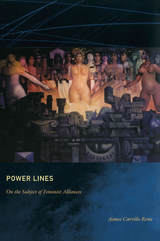 Power Lines: On the Subject of Feminist Alliances
Aimee Carrillo Rowe
Duke University Press, 2008 Like the complex systems of man-made power lines that transmit electricity and connect people and places, feminist alliances are elaborate networks that have the potential to provide access to institutional power and to transform relations. In Power Lines, Aimee Carrillo Rowe explores the formation and transformative possibilities of transracial feminist alliances. She draws on her conversations with twenty-eight self-defined academic feminists, who reflect on their academic careers, alliances, feminist struggles, and identifications. Based on those conversations and her own experiences as an Anglo-Chicana queer feminist researcher, Carrillo Rowe investigates when and under what conditions transracial feminist alliances in academia work or fail, and how close attention to their formation provides the theoretical and political groundwork for a collective vision of subjectivity. Combining theory, criticism, and narrative nonfiction, Carrillo Rowe develops a politics of relation that encourages the formation of feminist alliances across racial and other boundaries within academia. Such a politics of relation is founded on her belief that our subjectivities emerge in community; our affective investments inform and even create our political investments. Thus experience, consciousness, and agency must be understood as coalitional rather than individual endeavors. Carrillo Rowe’s conversations with academic feminists reveal that women who restrict their primary allies to women of their same race tend to have limited notions of feminism, whereas women who build transracial alliances cultivate more nuanced, intersectional, and politically transformative feminisms. For Carrillo Rowe, the institutionalization of feminism is not so much an achievement as an ongoing relational process. In Power Lines, she offers a set of critical, practical, and theoretical tools for building and maintaining transracial feminist alliances.
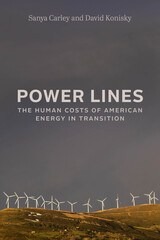 Power Lines: The Human Costs of American Energy in Transition
Sanya Carley and David Konisky
University of Chicago Press, 2025 On American energy and its persisting power to destroy. In the United States, the promise of a green-energy future is complicated by its realities. The country’s legacy energy systems are decrepit; the rollout of new technologies is unequal and piecemeal; households find themselves increasingly without reliable or affordable access; and Americans are excluded from the decisions that shape their energy futures. Having power in America has become an exercise in race, class, and wealth—in more ways than one. Power Lines is a sweeping portrait of American energy in the twenty-first century, rendered in terms of its increasing—and inevitable—human costs. Coal miners in West Virginia lose their livelihoods as energy markets change; historically marginalized households cannot easily access new technologies; children in “sacrifice zones” adjacent to mineral-mining sites suffer health problems and limited resources; and cities and towns are burdened from the production of alternative energies. Sanya Carley and David Konisky show current challenges and an uncertain future of America’s greatest policy imperative. The result is not only sobering but also essential for planning and pursuing a clean-energy transition that improves on the errors of the past.
 Power Market Transformation: Reducing emissions and empowering consumers
Barrie Murray
The Institution of Engineering and Technology, 2018 This book describes recent developments in the power and energy markets that are driving major changes in the generation mix, network requirements and customer engagement. The industry now faces new challenges associated with global warming and escalating demand from developing countries such as China and India. The effect of government interventions to manage changes and to meet emission targets has resulted in an industry that is neither a free market nor centrally coordinated and often lacks strategic direction. The uncertainty has resulted in a dearth of investment in generation and unprecedented low margins of spare capacity. This book provides an analysis of the changes and quantifies their impact. It reviews strategic decisions in the management of changes in the sector and aims to identify the optimal way forward to meet the triple objectives of security, affordability and sustainability with low emissions. It focuses on the economic aspects of initiatives to provide insight into their interaction. It also provides insight into the opportunities in the sector to the many new potential players.
Power, Money, and Media: Communication Patterns and Bureaucratic Control in Cultural China
Chin-Chuan Lee
Northwestern University Press, 2000 This book addresses, as few books in English have, a broad range of topics pertaining to China's expanding media and telecommunications systems. American and Chinese experts in journalism, communication, government, and political science use fieldwork, including participant observations, surveys, and in-depth interviews conducted within media organizations, to provide richly detailed analyses of the issues and of the changing face of media in China.
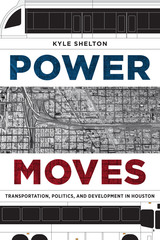 Power Moves: Transportation, Politics, and Development in Houston
By Kyle Shelton
University of Texas Press, 2017 Since World War II, Houston has become a burgeoning, internationally connected metropolis—and a sprawling, car-dependent city. In 1950, it possessed only one highway, the Gulf Freeway, which ran between Houston and Galveston. Today, Houston and Harris County have more than 1,200 miles of highways, and a third major loop is under construction nearly thirty miles out from the historic core. Highways have driven every aspect of Houston’s postwar development, from the physical layout of the city to the political process that has transformed both the transportation network and the balance of power between governing elites and ordinary citizens. Power Moves examines debates around the planning, construction, and use of highway and public transportation systems in Houston. Kyle Shelton shows how Houstonians helped shape the city’s growth by attending city council meetings, writing letters to the highway commission, and protesting the destruction of homes to make way for freeways, which happened in both affluent and low-income neighborhoods. He demonstrates that these assertions of what he terms “infrastructural citizenship” opened up the transportation decision-making process to meaningful input from the public and gave many previously marginalized citizens a more powerful voice in civic affairs. Power Moves also reveals the long-lasting results of choosing highway and auto-based infrastructure over other transit options and the resulting challenges that Houstonians currently face as they grapple with how best to move forward from the consequences and opportunities created by past choices.
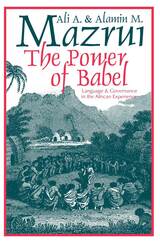 The Power of Babel: Language and Governance in the African Experience
Ali A. Mazrui and Alamin M. Mazrui
University of Chicago Press, 1998 Linguists estimate that there are currently nearly 2,000 languages in Africa, a staggering figure that is belied by the relatively few national languages. While African national politics, economics, and law are all conducted primarily in the colonial languages, the cultural life of the majority of citizens is conducted in a bewildering Babel of local and regional dialects, making language itself the center of debates over multiculturalism, gender studies, and social theory. In The Power of Babel, the noted Africanist scholar Ali Mazrui and linguist Alamin Mazrui explore this vast territory of African language.
The Power of Babel is one of the first comprehensive studies of the complex linguistic constellations of Africa. It draws on Ali Mazrui's earlier work in its examination of the "triple heritage" of African culture, in which indigenous, Islamic, and Western traditions compete for influence. In bringing the idea of the triple heritage to language, the Mazruis unravel issues of power, culture, and modernity as they are embedded in African linguistic life.
The first section of the book takes a global perspective, exploring such issues as the Eurocentrism of much linguistic scholarship on Africa; part two takes an African perspective on a variety of issues from the linguistically disadvantaged position of women in Africa to the relation of language policy and democratic development; the third section presents a set of regional studies, centering on the Swahili language's exemplification of the triple heritage.The Power of Babel unites empirical information with theories of nationalism and pluralism—among others—to offer the richest contextual account of African languages to date.
|
|
